
‘Spangle’ Pendant
Mid 6th-Mid 7th Century AD
Metal
Trapezoid “spangle” made of white washed metal sheet, with punched dots around the edges. This may have been worn on a necklace, or it could have been mounted on another object as decoration.
Reference: CANCM:1978.3.1120
Can be found: The Anglo-Saxon Kingdom of KentTop Shelf in Explorers and Collectors Collection


Aboriginal hammers
Early to mid-19th century
Stone, wood and gum
These are practical tools made from local materials. The stones are fixed to the wooden handles with gum from trees.
Reference: 4480, 4481, 4482
Can be found: Heroes and VillainsTravellers to the Pacific, Australasia and America in Explorers and Collectors Collection


Aegis amulet
Aegis
Green glazed amulet with three row pearl border. Card for Egyptian IV states “Amulet in fused green enamel”.
Reference: CANCM: 2428
Can be found: Ancient EgyptMiddle Shelf in Explorers and Collectors Collection


Afghan embroidered trousers 19th century; made in Afghanistan, bought in Tashkent
Cotton
Described by Lansdell as from ‘Chambar’, a place in Afghanistan. The colourful embroidery is typical of Afghan work. Lansdell bought them at a bazaar in Tashkent, a Russian trading city north of the Afghan border. He thought they would ‘be warm and both useful, when tied at the bottoms’ during his journeys on horseback across the continent.
Lansdell had his photograph taken wearing these trousers.
Presented by Mary Landsdell in memory of her late husband, 1922, and conserved with grant-aid from the Kathy Callow Trust, 2012
Reference: 2006.56.15
Can be found: Henry Lansdell in Explorers and Collectors Collection


African dagger in scabbard
18th to early 19th century; Fernando Po, West Africa
Wood and metal
Small dagger in gold-covered scabbard collected in 1821-26.
Presented by Captain Thomas Boteler, RN, to Canterbury Philosophical and Literary Institution Museum, 1827-28, and acquired through purchase of the Museum by Canterbury Corporation, 1846-47
Reference: 4613
Can be found: Africa, Asia, America, PacificHeroes and Villains in Explorers and Collectors Collection


African dagger in scabbard 18th to early 19th century; Fernando Po, West Africa
Wood and metal
Small dagger in gold-covered scabbard collected in 1821-26.
Presented by Captain Thomas Boteler, RN, to Canterbury Philosophical and Literary Institution Museum, 1827-28, and acquired through purchase of the Museum by Canterbury Corporation, 1846-47
Reference: 4612
Can be found: Africa, Asia, America, PacificHeroes and Villains in Explorers and Collectors Collection


African hair pin
19th century
Bone
This hair pin has four long prongs and a spoon-shaped handle, which has been described as a snuff ladle.
Reference: 4633
Can be found: Africa, Asia, America, PacificHeroes and Villains in Explorers and Collectors Collection


African headrests
19th century; Ashanti, Ghana
Painted wood
The smaller headrest is typical of the Ashanti people in the former Gold Coast, now Ghana. It is decorated with a wash of blue pigment. The larger headrest follows the Ghanaian shape but has elements of southeast African decoration. Cross-cultural styles like this were used in South Africa. The original black paint has worn with use.
Headrests were used by African men of fairly high status and were significant personal objects, protecting the owner’s head and hairstyle.
Reference: 4508, 4509
Can be found: Africa, Asia, America, PacificHeroes and Villains in Explorers and Collectors Collection


African sculpture, Qur’anic board, cap and gourds
20th century; Yoruba, Hausa and Ashanti peoples, Nigeria and Ghana
Wood and bronze
Two of the Yoruba sculptures are ritual ‘deceased-twin substitute’ carvings. The third is a small figure with distinctive hairstyle. Such African sculptures, with bold abstract features, have had a huge influence on modern artists. The doll is Ashanti from Ghana and would be carried by a pregnant woman to promote beauty in her unborn child.
Ghana is a centre of gold mining and the Ashanti are best known for their intricate tiny brass sculptures used to weigh gold. Dried and decorated gourd rinds are from the Hausa people, northern Nigeria, as is the Qur’anic writing board of the Hausa people has been decorated to celebrate a pupil’s achievement at school, and the embroidered cap.
Lent by Dr David Heathcote, 2012
Reference: CANCM:nn
Can be found: Africa, Asia, America, PacificHeroes and Villains in Explorers and Collectors Collection


African spear and shield
19th century; Mahdi people, Sudan
Wood, metal, animal hide
Captain J Graham brought back three spearheads and two spears described as ‘small’ but with shafts so long they had to be broken for transport. One spearhead was said to have belonged to the Khalifa, the Mahdi’s successor.
Collected by Captain J. Graham, 1898, and presented by General Sir James Graham, KCB, 1902
Reference: 3007, 3009
Can be found: Africa, Asia, America, PacificHeroes and Villains in Explorers and Collectors Collection


African sword
19th century; Akan Gold Coast (Ghana)
Metal and wood
The weapon with double-balled handle and openwork decoration on the blade is from the Akan area of the Gold Coast and probably an Ashanti sword.
Probably presented by Captain Thomas Boteler, RN, to Canterbury Philosophical and Literary Institution Museum, 1828, and acquired through purchase of the Museum by Canterbury Corporation, 1846-47
Reference: CANCM:nn
Can be found: Africa, Asia, America, PacificHeroes and Villains in Explorers and Collectors Collection


African sword
19th century; Congo
Metal and wood
This is a Congo ceremonial sword used among the Ngombe, Ngbandi and Lokele peoples.
Probably presented by Captain Thomas Boteler, RN, to Canterbury Philosophical and Literary Institution Museum, 1828, and acquired through purchase of the Museum by Canterbury Corporation, 1846-47
Reference: CANCM:nn
Can be found: Africa, Asia, America, PacificHeroes and Villains in Explorers and Collectors Collection


African sword and scabbard
19th century; Mahdi people, Sudan
Metal and wood
A souvenir with broken blade. It belonged to a fighter in the Islamic Mahdi army massacred by British troops.
Collected by Captain J Graham, 1898, and presented by General Sir James Graham, KCB, 1902
Reference: 3004
Can be found: Africa, Asia, America, PacificHeroes and Villains in Explorers and Collectors Collection


African water pot and water juj
20th century; Hausa people, Northern Nigeria
Earthenware, gourd rind
The pot was formed by pressing clay into an earthen hollow, making two half-rounds then joining them together and smoothing by hand. It sits on a ring when carried on the head. The jug is used for washing before entering a mosque.
Lent by Dr David Heathcote, 2012
Reference: CANCM:nn
Can be found: Africa, Asia, America, PacificHeroes and Villains in Explorers and Collectors Collection

















































































































Albuhera relics
1811
Flint and lead
Framed relics from the battlefield of Albuhera presented to the 1st Battalion of the Buffs by the Mayor of Albuhera in 1926.
The number of musket balls collected for this gift gives some idea of the thousands that must have been fired during the battle. The flint pieces were part of the musket firing mechanism and would strike a spark that fired the gunpowder and propelled the musket ball.
Donated to the National Army Museum, London by the Trustees of the Buffs Regimental Trust 2001
Reference: 2001-04-71-1-B
Can be found: The Buffs in Explorers and Collectors Collection

















































































































Amber Beads
5th – 8th Century AD
Amber
Necklace of 12 amber beads, of various shapes and sizes. Amber was likely imported from the Baltic, and would have been expensive to purchase; these beads would have belonged to someone very wealthy.
Found at Eastry, Kent, by Mr. Irby. Presented to the museum by Dr. W.G. Urry
Reference: CANCM:7509
Can be found: Bottom ShelfThe Anglo-Saxon Kingdom of Kent in Explorers and Collectors Collection

















































































































Amethyst beads
5th – 8th Century AD
Amethyst
String of 14 amethyst beads. Amethyst beads, mainly from trade routes that led through Germany, are more commonly found in Kent than elsewhere in the country.
Found by Mr. J. Brent.
Reference: CANCM:2139
Can be found: Middle ShelfThe Anglo-Saxon Kingdom of Kent in Explorers and Collectors Collection


Amulet
Small ornament in red stone/sun disc amulet of carnelian.
Reference: CANCM: 2122
Can be found: Ancient EgyptMiddle Shelf in Explorers and Collectors Collection


Amulet
Faience amulet of a pregnant woman / taweret. Hole for cord, broken at bottom.
Reference: E190
Can be found: Ancient EgyptMiddle Shelf in Explorers and Collectors Collection


Amulet
Green amulet in the shape of an eye.
Reference: E256
Can be found: Ancient EgyptMiddle Shelf in Explorers and Collectors Collection


Amulet
Glazed amulet in the shape of a collar or Bes.
Reference: E365
Can be found: Ancient EgyptMiddle Shelf in Explorers and Collectors Collection


Amulet
Bes, grotesque amulet figure for suspension with blue glaze
Reference: CANCM: 2126
Can be found: Ancient EgyptMiddle Shelf in Explorers and Collectors Collection


Amulet
Faience amulet, possible obscene. Hole for cord has broken off the back.
Reference: CANCM:6009
Can be found: Ancient EgyptMiddle Shelf in Explorers and Collectors Collection


Amulet
Large amulet in the shape of the cat goddess.
Reference: E53
Can be found: Ancient EgyptMiddle Shelf in Explorers and Collectors Collection
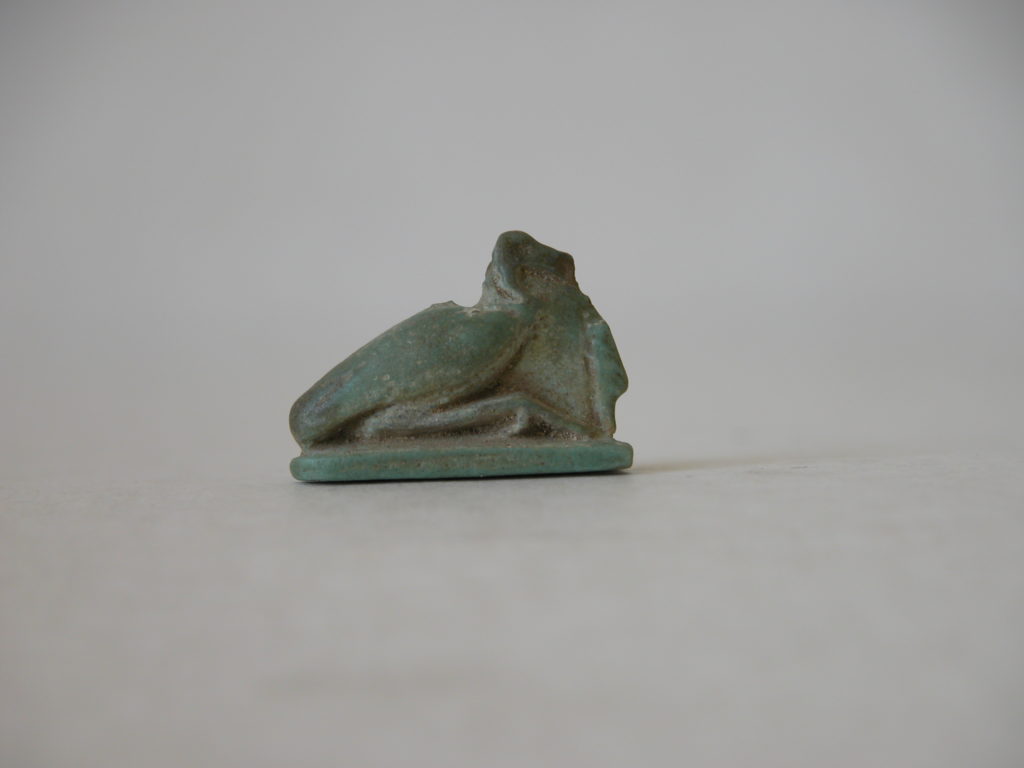

Amulet
Small bird amulet.
Reference: CANCM: 6014
Can be found: Ancient EgyptMiddle Shelf in Explorers and Collectors Collection


Amulet
Cat amulet.
Reference: CANCM:6013
Can be found: Ancient EgyptMiddle Shelf in Explorers and Collectors Collection


Amulet
Faience amulet in the shape of a djed pillar; the Egyptian symbol of stability. Hole for cord.
Reference: E149
Can be found: Ancient EgyptBottom Shelf in Explorers and Collectors Collection


Amulet
A green faience amulet depicting a Ram, an animal significant to more than one deity in Ancient Egypt. It possibly represents either Amun-Re, king of the Gods, or Khnum the potter.
Reference: CANCM: 6016
Can be found: Ancient EgyptBottom Shelf in Explorers and Collectors Collection

















































































































Amulet
Faience amulet in the shape of a lion. Hole for cord should be on the back but has been broken off.
Reference: E204
Can be found: Ancient EgyptBottom Shelf in Explorers and Collectors Collection


Amulet
Faience amulet in the shape of a ram-headed sphinx. Hole for cord above back.
Reference: E84
Can be found: Ancient EgyptBottom Shelf in Explorers and Collectors Collection


Amulet
Faience amulet in the shape of a standing goddess. Hole for cord above head.
Reference: E58
Can be found: Ancient EgyptBottom Shelf in Explorers and Collectors Collection


Amulet
Faience glazed bead in the shape of an eye.
Reference: E43
Can be found: Ancient EgyptBottom Shelf in Explorers and Collectors Collection
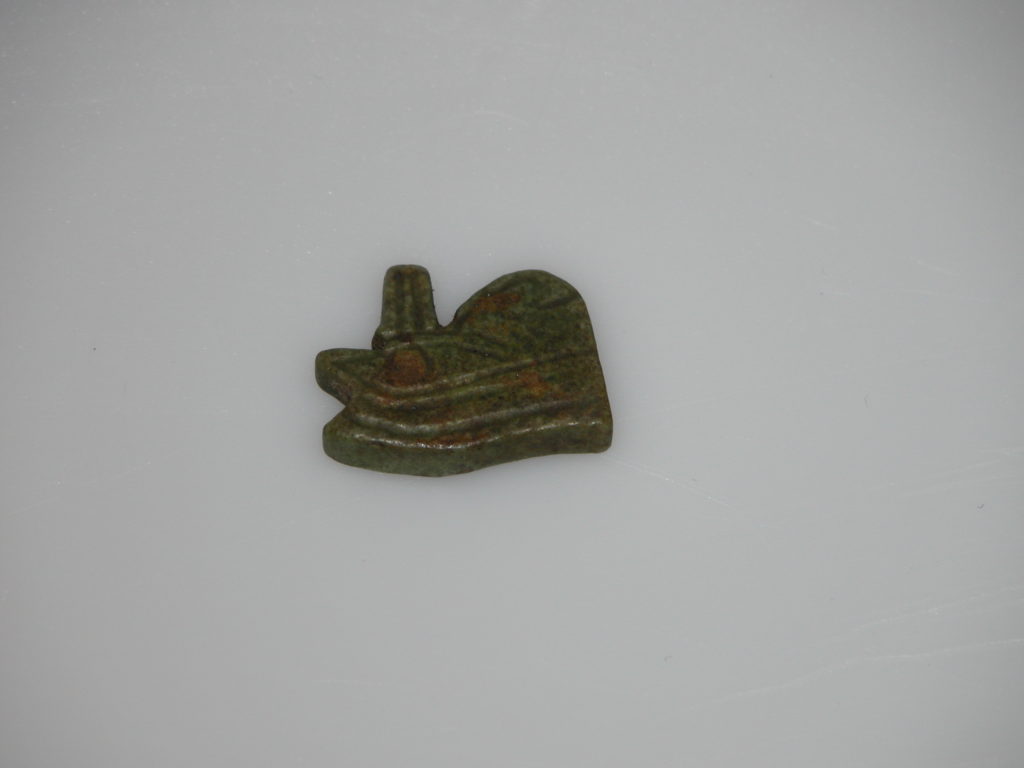

Amulet
Egyptian Sacred eye/Wadjet eye amulet.
Reference: CANCM: 2019
Can be found: Ancient EgyptBottom Shelf in Explorers and Collectors Collection


Amulet
Wedjat eye amulet.
Reference: CANCM: 5995.1
Can be found: Ancient EgyptBottom Shelf in Explorers and Collectors Collection


Amulet
Green bead in the shape of a dog-headed ape/standing baboon.
Reference: E68
Can be found: Ancient EgyptBottom Shelf in Explorers and Collectors Collection


Amulet
Faience green bead. Rabbit/hare.
Reference: CANCM: 6011
Can be found: Ancient EgyptBottom Shelf in Explorers and Collectors Collection


Amulet
Faience bead in the shape of Bes.
Reference: E41
Can be found: Ancient EgyptBottom Shelf in Explorers and Collectors Collection


Amulet
Anubis amulet made of stone. First two fingers from mummy’s stone placed on left side of pelvis inside the body to ward off evil.
Reference: CANCM: 2014
Can be found: Ancient EgyptBottom Shelf in Explorers and Collectors Collection
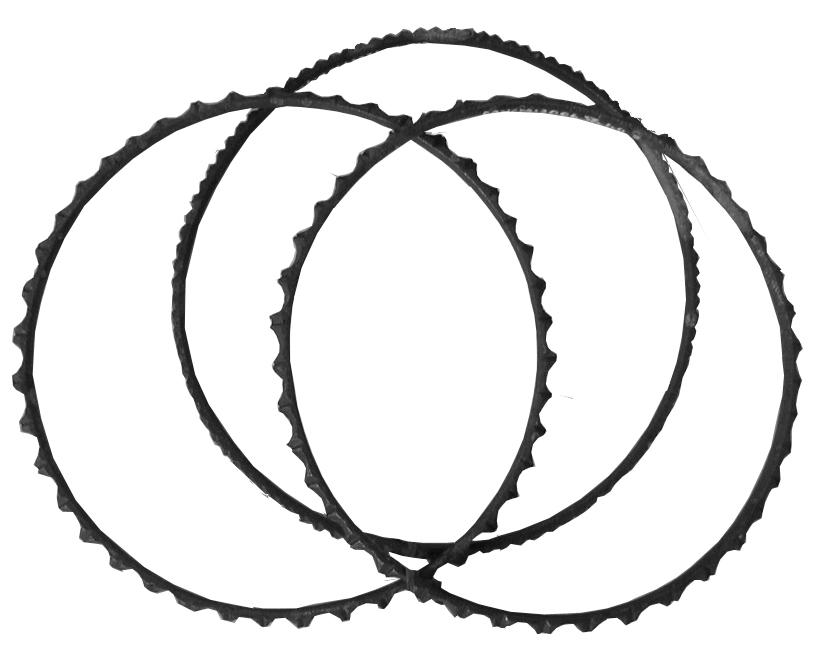

Anklets
19th century; collected in Jaipur, India, 1889
Metal
Tagged with a green label, like most of Lansdell’s collection, describing where acquired.
Presented by Mary Landsdell in memory of her late husband, 1922
Reference: 2006.56.48.1-3
Can be found: Henry Lansdell in Explorers and Collectors Collection

















































































































Ansate Brooch
5th-8th Centuries AD
Copper Alloy
Brooch. This type of brooch is sometimes called a ‘caterpillar’ brooch on account of their shape.
Presented by Canterbury Archaeological Trust
Reference: CANCM:1980.12.719
Can be found: The Anglo-Saxon Kingdom of KentTop Shelf in Explorers and Collectors Collection


Bark cloth
19th century; South Sea Islands
Bark
Reference: 4590
Can be found: Heroes and VillainsTravellers to the Pacific, Australasia and America in Explorers and Collectors Collection


Bead
Orange stone bead with six indentations.
Reference: 6088
Can be found: Ancient EgyptMiddle Shelf in Explorers and Collectors Collection

















































































































Bead
Faience bead.
Reference: E122
Can be found: Ancient EgyptMiddle Shelf in Explorers and Collectors Collection

















































































































Bead
Faience bead with a hole for cord.
Reference: E125
Can be found: Ancient EgyptMiddle Shelf in Explorers and Collectors Collection

















































































































Bead
Semi-precious stone bead with a hole for cord.
Reference: E164
Can be found: Ancient EgyptMiddle Shelf in Explorers and Collectors Collection

















































































































Bead
Glass bead.
Reference: E198
Can be found: Ancient EgyptMiddle Shelf in Explorers and Collectors Collection

















































































































Bead
A blue glazed bead.
Reference: E24
Can be found: Ancient EgyptMiddle Shelf in Explorers and Collectors Collection

















































































































Bead
A blue glass bead.
Reference: E163
Can be found: Ancient EgyptMiddle Shelf in Explorers and Collectors Collection

















































































































Bead
A green glazed bead.
Reference: E168
Can be found: Ancient EgyptMiddle Shelf in Explorers and Collectors Collection

















































































































Bead
A green glazed bead.
Reference: E267
Can be found: Ancient EgyptMiddle Shelf in Explorers and Collectors Collection


Bead
A blue faience bead.
Reference: E372
Can be found: Ancient EgyptMiddle Shelf in Explorers and Collectors Collection


Bead
An inscribed cylindrical green bead with a hole for cord.
Reference: E214
Can be found: Ancient EgyptMiddle Shelf in Explorers and Collectors Collection

















































































































Bead
White scarab bead.
Reference: E266
Can be found: Ancient EgyptMiddle Shelf in Explorers and Collectors Collection


Bead
Pink stone bead. Scarab.
Reference: E138
Can be found: Ancient EgyptMiddle Shelf in Explorers and Collectors Collection
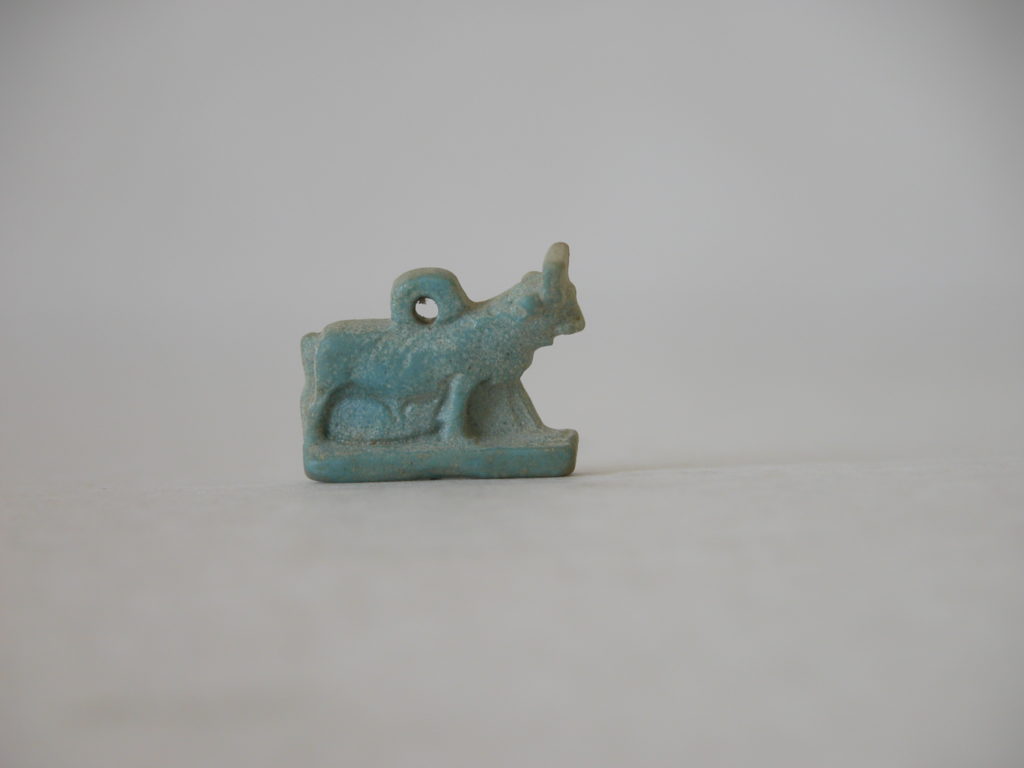

Bead
A blue bead in the shape of a bull.
Reference: E79
Can be found: Ancient EgyptMiddle Shelf in Explorers and Collectors Collection


Bead
Green bead in the form of a cat.
Reference: E50
Can be found: Ancient EgyptMiddle Shelf in Explorers and Collectors Collection


Bead
Amulet. Bast green bead in the form of cat goddess.
Reference: E59
Can be found: Ancient EgyptBottom Shelf in Explorers and Collectors Collection

















































































































Bead
5th – 8th Century AD
Glass
Glass Bead.
Reference: Found in Canterbury in 1979 by Mr A. Waters. No accession number
Can be found: The Anglo-Saxon Kingdom of KentTop Shelf in Explorers and Collectors Collection

















































































































Beads
Blue Egyptian beads strung on a modern string and clasp with a Roman lock.
Reference: E20
Can be found: Ancient EgyptMiddle Shelf in Explorers and Collectors Collection


Beads
Beads on modern string.
Reference: E195
Can be found: Ancient EgyptMiddle Shelf in Explorers and Collectors Collection

















































































































Beads
5th – 8th Century AD
Glass and Copper Alloy
Brass wire strung with two opaque yellow ‘annular’ beads and one unpolished cobalt blue ‘annular’ bead. This may have been a breast ornament – it would have been pinned onto a piece of clothing.
Reference: CANCM:1978.3.174
Can be found: The Anglo-Saxon Kingdom of KentTop Shelf in Explorers and Collectors Collection

















































































































Beads
5th – 8th Century AD
Glass and stone
String of beads.
Found at Westbere Anglo-Saxon cemetery, Kent. Bequeathed by Osborn Dan
Reference: CANCM:6425
Can be found: Middle ShelfThe Anglo-Saxon Kingdom of Kent in Explorers and Collectors Collection

















































































































Beads
5th – 8th Century AD
Glass and stone
String of 69 beads of various colours.
Found in a grave at field coll place, Grove Ferry, Kent.
Reference: CANCM:1976
Can be found: Middle ShelfThe Anglo-Saxon Kingdom of Kent in Explorers and Collectors Collection

















































































































Beads
5th – 8th Century AD
Glass and stone
Necklace containing four cylindrical (bugle) beads and what were originally quadruple pearl-like beads, some of which have since separated into single, double and triple beads.
Found at Eastry, Kent by Mr. Irby. Presented to the museum by Dr. W.G. Urry
Reference: CANCM:7511
Can be found: Bottom ShelfThe Anglo-Saxon Kingdom of Kent in Explorers and Collectors Collection

















































































































Bell Beaker
6th Century AD
Glass
Carinated glass Bell-Beaker with fine white trials below the rim, and on the base. As this glass has no base, it has been suggested it was used for toasts at feasts; the drink would have had to be downed in one go.
Found in Westbere (Anglo-Saxon cemetery) Kent, UK. Bequeathed by Osborn Dan.
Reference: CANCM:6430
Can be found: Middle ShelfThe Anglo-Saxon Kingdom of Kent in Explorers and Collectors Collection

















































































































Bird Brooch
5th – 8th Century AD
Silver Gilt
Bird brooch, silver gilt, garnet inset in eye and tail, niello inlay.
Found in Bekesbourne, Kent, UK. by Mr. P.G. Wilson.
Reference: CANCM:7523
Can be found: Middle ShelfThe Anglo-Saxon Kingdom of Kent in Explorers and Collectors Collection


Bird Brooch
5th – 8th Century AD
Silver Gilt
Bird brooch, silver gilt, garnet inset in eye and tail, niello inlay.
Found in Bekesbourne, Kent, UK. by Mr. P.G. Wilson.
Reference: CANCM:7524
Can be found: Middle ShelfThe Anglo-Saxon Kingdom of Kent in Explorers and Collectors Collection

















































































































Bird Brooch
5th-8th Century AD
Gilded Copper Alloy
Bird shaped brooch of a Frankish type, with traces of gilt on the exterior.
Found at Eastry, Kent in 1792. Presented to the museum by Dr. W.G. Urry after a loan from Mr Irby
Reference: CANCM:7496.
Can be found: Bottom ShelfThe Anglo-Saxon Kingdom of Kent in Explorers and Collectors Collection


Bird or seal
Terracotta
Reference: 4196
Can be found: Viscount Strangford in Explorers and Collectors Collection


Black and red glazed lamp
Earthenware
Reference: 4233
Can be found: Viscount Strangford in Explorers and Collectors Collection


Black bowl
Reference: 4160
Can be found: Viscount Strangford in Explorers and Collectors Collection

















































































































Black two-handled pottery
5th to 1st century BC; found in Greece and Turkey
Earthenware
Cups for drinking wine or water, of a type called a skyphos.
Presented by Viscount Strangford to Canterbury Philosophical and Literary Institution Museum, 1844, and acquired through purchase of the museum by Canterbury Corporation, 1846-47
Reference: CANCM:nn
Can be found: Viscount Strangford in Explorers and Collectors Collection


Black two-handled vase of unusual shape
Found 1821
Reference: 4090
Can be found: Viscount Strangford in Explorers and Collectors Collection


Blunt-ended sword
18th century; South India
Steel
This double-edged sword was used for cutting. The hilt (sword handle) has a bell-shaped pommel (end) and little protection for the knuckle.
Presented by Stephen Lushington to Canterbury Philosophical and Literary Institution Museum, 1825-68, and acquired through purchase of the Museum by Canterbury Corporation, 1846-47
Reference: CANCM:nn
Can be found: Stephen Lushington in Explorers and Collectors Collection


Body of vase with band of Greek key pattern
From Megara, 1821
Reference: 4094
Can be found: Viscount Strangford in Explorers and Collectors Collection

















































































































Bracteates
5th – 8th Century AD
Gold
Kentish bracteates. Bracteates, thin single-sided gold medals, were worn as pendants on a string around the neck. They may have been seen as a protective amulet.
Bequeathed by Mr. J. Brent.
Reference: CANCM:2159, 2160
Can be found: Middle ShelfThe Anglo-Saxon Kingdom of Kent in Explorers and Collectors Collection

















































































































Brigadier General Van Straubenzee and Officers of The Buffs
about 1855
Copy of photograph by Roger Fenton (1819-69)
This photograph shows soldiers of the Buffs in the Crimea with a Brigade commander: from left, an Officer, Major Maude, a Sergeant Major, Brigadier-General Charles Thomas Van Straubenzee (seated), a Corporal-Bugler and an Adjutant. Roger Fenton went to the Crimea as the first official war photographer. Cameras needed a long time to create a picture and he was only able to take posed group shots like this one, or landscapes. Despite the poor conditions he produced 350 photographs, which were published in the Illustrated London News.
Image courtesy of the National Army Museum, London
Reference: 1964-12-151-6-14
Can be found: The Buffs in Explorers and Collectors Collection


Bronze Cat Head
Bronze Sekhet.
Reference: E346
Can be found: Ancient EgyptMiddle Shelf in Explorers and Collectors Collection

















































































































Bronze Patera Bowl
7th Century AD
Copper Alloy
‘Coptic bowl’. Bowls of this type have been found in several other Anglo-Saxon cemetaries in Kent. They were made in Egypt, and probably were imported from Alexandria in the seventh century AD, arriving to Britain via the river Rhine.
Thought to be from Wickhambreaux (1886).
Bequeathed by Lt. Col Copeland.
Reference: CANCM:1107
Can be found: Bottom ShelfThe Anglo-Saxon Kingdom of Kent in Explorers and Collectors Collection

















































































































Brooch
5th – 8th Century AD
Copper Alloy
Equal arm brooch, set with garnets in gilt copper.
Found in Bourne Park, Kent, UK. by Mr. T. Sewell.
Reference: CANCM:1991.80.1
Can be found: The Anglo-Saxon Kingdom of KentTop Shelf in Explorers and Collectors Collection

















































































































Brooch
5th – 8th Century AD
Silver
Rare Kentish silver brooch of cruciform shape.
Found by Mr. J. Brent.
Reference: CANCM:2660
Can be found: Middle ShelfThe Anglo-Saxon Kingdom of Kent in Explorers and Collectors Collection


Brooch
5th – 8th Century AD
Copper Alloy
Bronze gilt brooch of Jutish type without a pin.
Reference: CANCM:2651
Can be found: Middle ShelfThe Anglo-Saxon Kingdom of Kent in Explorers and Collectors Collection

















































































































Brooch
Early 6th Century
Copper Alloy
Electroform copy of bronze gilt brooch - the original is at the British Museum. The earliest Saxons regularly used almost abstract animal designs on their jewellery.
Found in Martyr’s Field in 1900.
Reference: CANCM:nono
Can be found: Middle ShelfThe Anglo-Saxon Kingdom of Kent in Explorers and Collectors Collection

















































































































Brooch
5th – 8th Century AD
Copper Alloy, silver and garnet
Circular silver jewelled disc brooch of Kentish work set with garnets; cloisonee work and gold wire filigree.
Collected by Mr. J. Brent. Found in Anglo Saxon cemetery at Stouting, Faversham.
Reference: CANCM:2614
Can be found: Middle ShelfThe Anglo-Saxon Kingdom of Kent in Explorers and Collectors Collection


Brooch
5th – 8th Century AD
Copper Alloy
Bronze brooch of foreign type, possibly from Belgium or the Lower Rhine region of Germany.
Reference: CANCM:2634
Can be found: Middle ShelfThe Anglo-Saxon Kingdom of Kent in Explorers and Collectors Collection

















































































































Brooch
5th – 8th Century AD
Silver Gilt
Silver-gilt brooch with garnet and greenstone.
Found at Eastry, Kent in 1792. Presented to the museum by Dr. W.G. Urry after a loan from Mr Irby
Reference: CANCM:7497
Can be found: Bottom ShelfThe Anglo-Saxon Kingdom of Kent in Explorers and Collectors Collection

















































































































Brooch
5th – 8th Century AD
Copper-Alloy
Square brooch set with garnets at each corner.
Found at Mersham, Kent in 1828.
Reference: CANCM:2631
Can be found: Bottom ShelfThe Anglo-Saxon Kingdom of Kent in Explorers and Collectors Collection

















































































































Brooch
5th – 8th Century AD
Copper-Alloy
Jeweled brooch of Jutish type, set with garnets.
Found at Mersham, Kent in 1828.
Reference: CANCM:nn
Can be found: Bottom ShelfThe Anglo-Saxon Kingdom of Kent in Explorers and Collectors Collection

















































































































Brooch
5th – 8th Century AD
Copper-Alloy
Circular brooch set with garnets, one is missing.
Found at Merhsam, Kent in 1828
Reference: CANCM:2632
Can be found: Bottom ShelfThe Anglo-Saxon Kingdom of Kent in Explorers and Collectors Collection


Brooches
5th – 8th Century AD
Copper Alloy
Two radiate-headed brooches with five inlaid garnets.
Found by Mr. J. Brent.
Reference: CANCM:2192
Can be found: Middle ShelfThe Anglo-Saxon Kingdom of Kent in Explorers and Collectors Collection
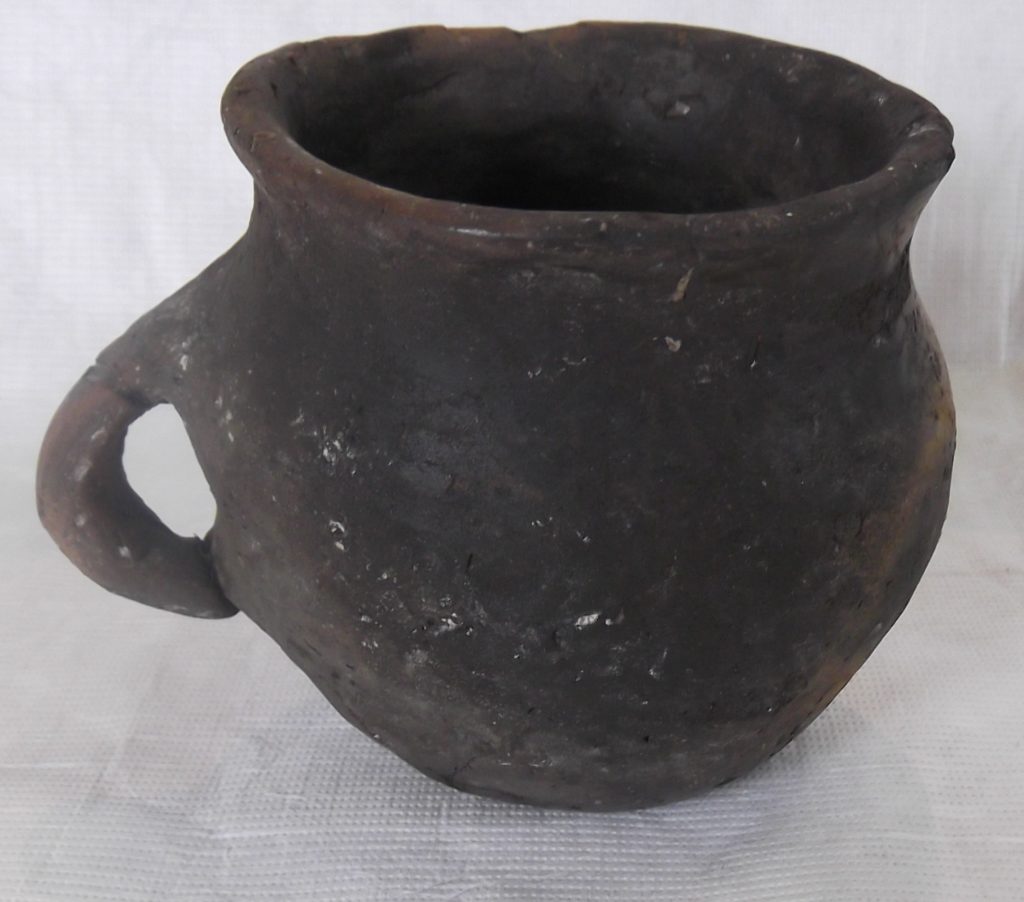

Brown Ware Mug
5th – 8th Century AD
Brown Ware
Handmade, burnished, handled pottery mug with round base, brownish ware. Found close to the head of a child. Burnishing (rubbing a pot with a leather cloth) would make the mug watertight and also a lot smoother to the touch.
Found in Bekesbourne, Kent, UK. by Mr. P.G. Wilson.
Reference: CANCM:7588
Can be found: Middle ShelfThe Anglo-Saxon Kingdom of Kent in Explorers and Collectors Collection


Bucket
5th – 8th Century AD
Copper Alloy
Bucket/vat with handle, fragments inside.
Reference: CANCM:1113
Can be found: Bottom ShelfThe Anglo-Saxon Kingdom of Kent in Explorers and Collectors Collection

















































































































Buckle
5th-8th Century AD
Copper Alloy
Oval copper alloy buckle with buckle plate and tongue complete.
Reference: CANCM:nn
Can be found: The Anglo-Saxon Kingdom of KentTop Shelf in Explorers and Collectors Collection

















































































































Buckle
5th – 8th Century AD
Copper Alloy
Jewelled buckle of Frankish type.
Bequeathed by Mr. J. Brent.
Reference: CANCM:2175
Can be found: Middle ShelfThe Anglo-Saxon Kingdom of Kent in Explorers and Collectors Collection

















































































































Buckle
5th – 8th Century AD
Copper Alloy
Small bronze buckle complete with tongue. The buckle loop is decorated with groups of incised lines and part of the buckle plate remains.
Found at Eastry, Kent in 1792. Presented to the museum by Dr. W.G. Urry after a loan from Mr Irby
Reference: CANCM:7501
Can be found: Bottom ShelfThe Anglo-Saxon Kingdom of Kent in Explorers and Collectors Collection

















































































































Buckle and Buckle Plate
5th – 8th Century AD
Silver gilt
Buckle, broken into two pieces, with triangular plate. Such buckles were normally found in graves of high status males and are often decorated with garnets. This is a slightly cheaper version, but would still have belonged to a rich man.
Found in Littlebourne; Long Meadow, Well Chapel, Kent, UK. by Mr. B. Riley.
Reference: CANCM:2003.389.1-3
Can be found: The Anglo-Saxon Kingdom of KentTop Shelf in Explorers and Collectors Collection


Buckle Plate
5th – 8th Century AD
Bronze
Bronze buckle and buckle plate inlaid with silver.
Found in Bekesbourne, Kent, UK. by Mr. P.G. Wilson.
Reference: CANCM:7537
Can be found: Middle ShelfThe Anglo-Saxon Kingdom of Kent in Explorers and Collectors Collection
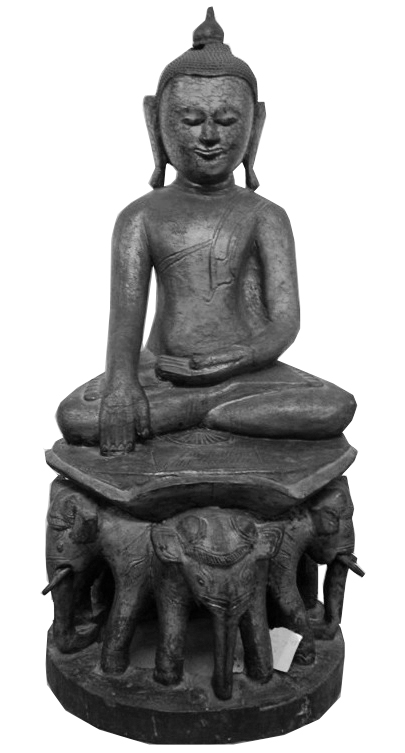

Buddha seated on elephants
19th century; Burma
Bronze-covered wood
In Buddhism the elephant symbolises strength of mind, embodying calm majesty and noble gentleness. This Buddha has the hands arranged in ‘touching the earth’ pose.
Presented by Miss Mona Sharp,1908
Reference: 4864
Can be found: Heroes and VillainsTravellers to the East in Explorers and Collectors Collection


Buddhas
19th century; Thailand
Silver-covered wax, Alabaster
The silver Buddhas are posed in the attitude of meditation. The carved alabaster Buddha, in ‘touching the earth’ pose, has small wings. All are probably from domestic shrines.
Reference: 1756, 126, 1751, 1752
Can be found: Heroes and VillainsTravellers to the East in Explorers and Collectors Collection


Canopic Jar
Marble canopic jar; human headed ape, wolf, owl.
During mummification, a dead person’s organs were embalmed separately from the body, and from about 2,000 BC were stored in stone or pottery containers called canopic jars. The organs in the jars were guarded by four gods known as the Sons of Horus who appear on the lids.
Reference: CANCM: 4276
Can be found: Ancient EgyptBottom Shelf in Explorers and Collectors Collection


Carved boot
19th century; collected in Russia
Wood
Presented by Mary Landsdell in memory of her late husband, 1922
Reference: 2006.56.7
Can be found: Henry Lansdell in Explorers and Collectors Collection


Carved escutcheon
19th century; collected in Agra, India,
1889 Soapstone
Presented by Mary Landsdell in memory of her late husband, 1922
Reference: 2006.56.49
Can be found: Henry Lansdell in Explorers and Collectors Collection


Carved foot
Found at Agrigentum, Sicily, in 1825 and bought by Strangford in St Petersburg.
Marble
Unknown date, probably Roman
Presented by Viscount Strangford to Canterbury Philosophical and Literary Institution Museum, 1844, and acquired through purchase of the museum by Canterbury Corporation, 1846-47
Reference: 4265
Can be found: Viscount Strangford in Explorers and Collectors Collection


Carved religious bookmark
19th century; collected in Russia
Wood
Decorated with a Russian Orthodox image of priests blessing a man.
Presented by Mary Landsdell in memory of her late husband, 1922
Reference: 2006.56.1-2
Can be found: Henry Lansdell in Explorers and Collectors Collection


Carved religious bookmark
19th century; collected in Russia
Wood
Decorated with a Russian Orthodox image of Christ with incense burner at a deathbed.
Presented by Mary Landsdell in memory of her late husband, 1922
Reference: 2006.56.1-2
Can be found: Henry Lansdell in Explorers and Collectors Collection


Cast of part of a Mastodon andium lower jaw
1845 copy of prehistoric original
Plaster
This is a cast of the fossilised jaw found in South America and given to Canterbury Philosophical and Literary Institution Museum in 1841 by General William Miller. The original was lent to the British Museum in 1845, when it was used to help establish the new species of elephant ancestor Mastodon andium. Canterbury Curator John Brent allowed the British Museum to keep the original in exchange for a cast and various other fossil specimens.
Presented by William Miller to Canterbury Philosophical and Literary Institution Museum and acquired through purchase of the Museum by Canterbury Corporation, 1846-47
Reference: A160
Can be found: Heroes and VillainsTravellers to the Pacific, Australasia and America in Explorers and Collectors Collection


Censer Cover
950 AD
Copper Alloy, Silver, Niello
Electroform copy of cover for an incense bowl. This is one of only three remaining from before the Norman Conquest. The original is in the British Museum. Cast in copper alloy, with applied silver plates engraved and filled with niello. It is also decorated with entwined animals and birds, and acanthus leaves.
Found in 1867 in Palace Street, Canterbury.
Reference: CANCM:nn
Can be found: The English and the Vikings in Explorers and Collectors Collection


Chinese balances
19th century; bought in Yining (Kuldja), China, 1888
Metal and wood
One miniature, the other comprising two needles and thread with a storage tube and weight.
Presented by Mary Landsdell in memory of her late husband, 1922
Reference: 2006.56.20, 22.1-4&23
Can be found: Henry Lansdell in Explorers and Collectors Collection
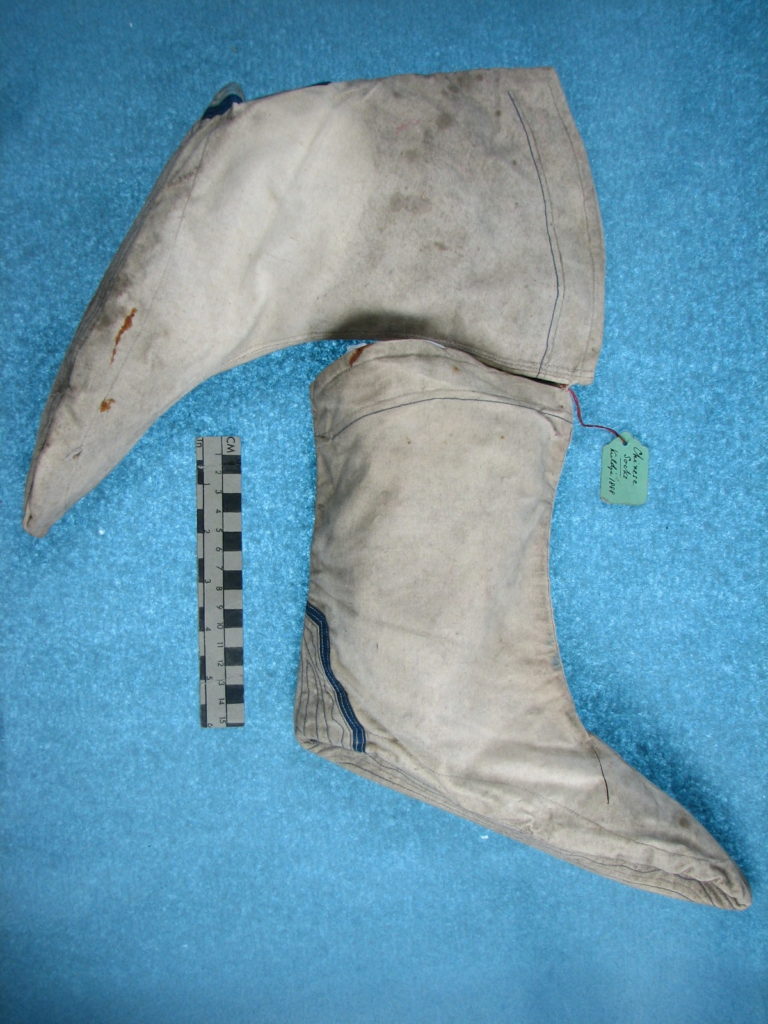

Chinese boots
19th century; collected in Yining, China
Cotton
Presented by Mary Landsdell in memory of her late husband, 1922, and conserved with grant-aid from the Kathy Callow Trust, 2012
Reference: 2006.56.19.1-2
Can be found: Henry Lansdell in Explorers and Collectors Collection


Chinese ceramic temple
19th century; Shiwan in Guangdong province, China
Glazed earthenware
This building is modelled on a Shenist folk temple to nature gods and patron gods. The Chinese text on the pillars can be translated as ‘Fiction or reality, we revisit our ancestors with these figures’.
It was probably made at a workshop called Rui Yuan in Shiwan, Fo Shan City, Guangdong province, a well-known centre for ceramics production of this type. The ceramic used is known as stoneware because of its durability. Shiwan was famous for making architectural ceramics and ceramic figures during the Ming and Qing dynasties (14th to early 20th centuries).
Presented by Mr W Welby, 1874
Reference: 125
Can be found: Heroes and VillainsTravellers to the East in Explorers and Collectors Collection


Chinese fan
19th century; acquired in China, 1888
Wood, paper
Presented to Lansdell by a Chinese dignitary, possibly the Tchyan of General Chang, on 19 June 1888.
Presented by Mary Landsdell in memory of her late husband, 1922
Reference: 2006.56.17
Can be found: Henry Lansdell in Explorers and Collectors Collection


Chinese pagoda model
19th to 20th century
Ivory
Pagodas are tiered buildings in Asia, originally with a religious function and often sited near temples. The word ‘pagoda’ comes from the Portuguese pagode, meaning ‘temple’.
Reference: 1750A
Can be found: Heroes and VillainsTravellers to the East in Explorers and Collectors Collection


Chinese shoes and purse 19th to 20th century
Silk and wood
The purse has a drawstring moneybag inside the eggshell-like segments, which are held together by tassels. The child’s shoe was given to the museum with a stone inside to keep its shape. Embroidered shoes displayed on the right have a raised sole to keep the embroidered fabric above dust and dirt on the ground.
Child’s shoe conserved with grant-aid from the Kathy Callow Trust, 2012; purse presented by Mrs F. Brewster, 1905
Reference: 4710, (nn), 4757
Can be found: Heroes and VillainsTravellers to the East in Explorers and Collectors Collection


Chinese waist pocket
19th century; collected in Yining (Kuldja), China
Cotton, velvet and linen
Decorated with embroidery in traditional patterns.
Presented by Mary Landsdell in memory of her late husband, 1922, and conserved with grant-aid from the Kathy Callow Trust, 2012
Reference: 2006.56.23
Can be found: Henry Lansdell in Explorers and Collectors Collection


Chowrie or Fly brush
19th century; bought in Yining (Kuldja), China, 1888
Wood and animal hair
For keeping away flies and carried as a mark of rank.
Presented by Mary Landsdell in memory of her late husband, 1922
Reference: 2006.56.18
Can be found: Henry Lansdell in Explorers and Collectors Collection

















































































































Cigar box commemorating the Relief of Chitral, 1895 and Indian Frontier Campaign, 1897
1898
Silver hallmarked London
Chitral was a remote outpost on India’s Northwest Frontier. In 1895 it was besieged by Pathan tribesmen. The Buffs and the rest of the relief force reached the fort after 26 days clambering over snow and ice of the Himalayas.
Donated to the National Army Museum, London, by the Trustees of the Buffs Regimental Trust, 2001
Reference: 2001.04-1039
Can be found: The Buffs in Explorers and Collectors Collection

















































































































Cloth Fragments
5th – 8th Century AD
Cloth
Fragments of cloth in glass slide.
Found adhering to the remains of an Anglo-Saxon in a grave at Sarre, Kent in 1863.
Reference: CANCM:7159
Can be found: Middle ShelfThe Anglo-Saxon Kingdom of Kent in Explorers and Collectors Collection


Clubs from Nootka Sound
Late 18th century; Nootka Sound, Vancouver Island, Canada
Whalebone
The form and decoration of these clubs is unique to people from Nootka Sound. One has a serpent-head handle unlike any other clubs so far recorded. They were collected during Captain Cook’s voyages in 1776-79.
Reference: 4476, 4477
Can be found: Heroes and VillainsTravellers to the Pacific, Australasia and America in Explorers and Collectors Collection


Coarse Cloth
Portion of coarse cloth/mummy cloth.
Reference: CANCM: 5157
Can be found: Ancient EgyptBottom Shelf in Explorers and Collectors Collection


Coconut cup
19th century; Polynesia
Coconut shell
The coconut cup would have been used for fermented drinks. It is a high status item with decorations linked to the Cook Islands.
Reference: CANCM:nn
Can be found: Heroes and VillainsTravellers to the Pacific, Australasia and America in Explorers and Collectors Collection

















































































































Coin
Eighth Century AD
Silver
Electroform copy of an Anglo-Saxon coin - the original is in the British Museum. This coin was minted in around 765AD for Ecgberht II, who ruled from 765 to 779. Not much is known about Ecgberht aside from his coins and the small number of charters in which he is mentioned; he was likely installed by Offa as a king. Offa then attempted to rule Kent more directly in 776, which prompted a rebellion under Ecgberht. Kent seems to have remained independent for several years afterwards, which suggests it was successful.
Reference: CANCM:10446
Can be found: Bottom ShelfThe Anglo-Saxon Kingdom of Kent in Explorers and Collectors Collection
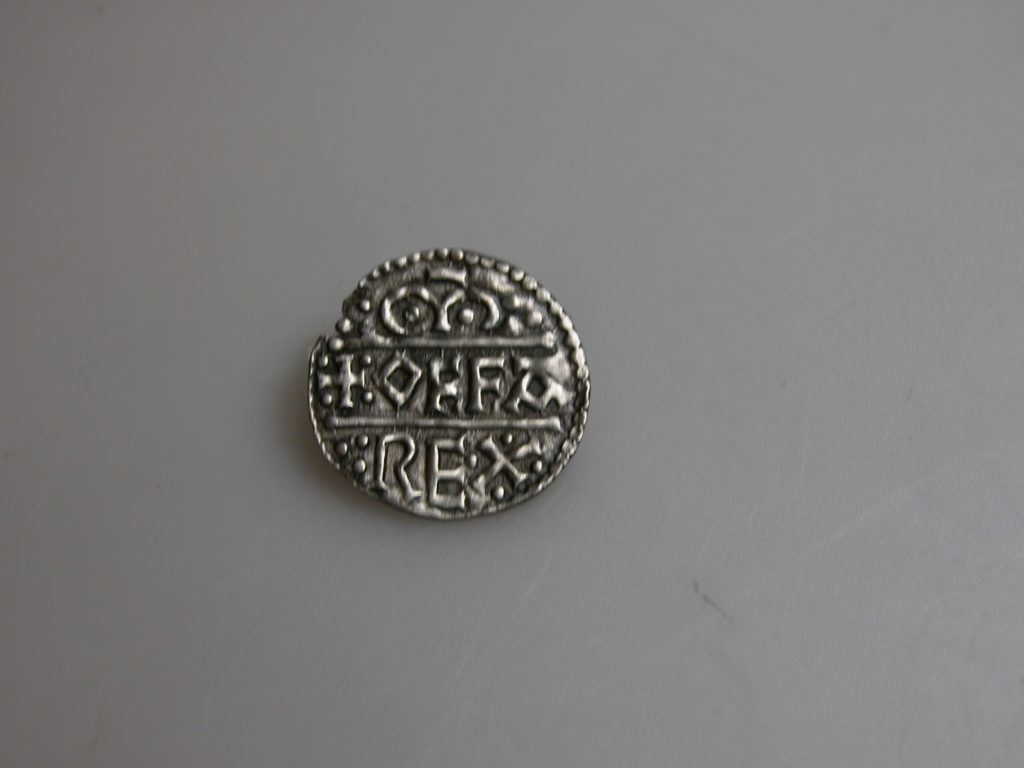

Coin
Silver
Coin minted for Archbishop Æthelheard, who was enthroned in 793. It bears the names of both the archbishop and the King. King Offa gave the Archbishops of Canterbury the right to mint their own coins, and this continued into the reign of King henry VIII.
Found by Mr David Hunt at Otford, Kent. Acquired by the Landowner with grant-aid from the MLA/V&A Purchase Grant fund, and generous contributions from Mr Hunt and from a Kent charitable trust through the friends of Canterbury Museums.
Reference: CANCM:2010.69
Can be found: Bottom ShelfThe Anglo-Saxon Kingdom of Kent in Explorers and Collectors Collection


Coir comb
18th to 19th century; Tonga, South Seas Coir
The decorative hair comb from Tonga is made of coir fibres.
Reference: 1763
Can be found: Heroes and VillainsTravellers to the Pacific, Australasia and America in Explorers and Collectors Collection

















































































































Comb
8th Century AD
Antler
Fragment of double-sided antler comb. The comb is decorated with a series of ring-and-dot motifs in a triangular arrangement at its end.
Presented by Canterbury Archaeological Trust
Reference: CANCM:1986.37.382
Can be found: The Anglo-Saxon Kingdom of KentTop Shelf in Explorers and Collectors Collection

















































































































Comb
8th Century AD
Antler, iron and bone
Single-sided comb with antler handle, iron nails and bone teeth.
Excavated from Christ Church College 1993. Presented by Canterbury Archaeological Trust
Reference: CANCM:1979.64.1331
Can be found: The Anglo-Saxon Kingdom of KentTop Shelf in Explorers and Collectors Collection

















































































































Comb
9th Century AD
Bone
Worked Bone single-sided comb.
Excavated from the Marlowe Car Park 1979. Presented by Canterbury Archaeological Trust
Reference: CANCM:1980.12.269
Can be found: The Anglo-Saxon Kingdom of KentTop Shelf in Explorers and Collectors Collection


Comb
Eleventh Century AD
Bone, Copper Alloy
Single sided composite comb. Though similar combs are known from across England, this comb is Scandinavian in design, and was produced at sites around the Baltic through the early medieval period. This particular comb may have been an import, or could be a locally made copy.
Excavated in Longmarket, Canterbury. Presented by Canterbury Archaeological Trust
Reference: CANCM:1990.11.2609
Can be found: The English and the Vikings in Explorers and Collectors Collection

















































































































Comb Case
6th Century AD
Antler
The Anglo-Saxons kept their combs in cases to stop the teeth from breaking.
Excavated in Stour Street in 1986. Presented by Canterbury Archaeological
Reference: CANCM:nn
Can be found: The Anglo-Saxon Kingdom of KentTop Shelf in Explorers and Collectors Collection


Cone Jar
5th – 8th Century AD
Glass
Glass tumbler.
Found in Westbere (Anglo-Saxon cemetery) Kent, UK. Bequeathed by Osborn Dan.
Reference: CANCM:6431
Can be found: Middle ShelfThe Anglo-Saxon Kingdom of Kent in Explorers and Collectors Collection


Cone Jar
5th – 8th Century AD
Glass
Conical glass vase.
Found in Westbere (Anglo-Saxon cemetery) Kent, UK. Bequeathed by Osborn Dan.
Reference: CANCM:6428
Can be found: Middle ShelfThe Anglo-Saxon Kingdom of Kent in Explorers and Collectors Collection


Copper Alloy Bindings from a bucket
5th – 8th Century AD
Copper Alloy
Bronze bindings and handle of an Anglo-Saxon bucket mounted on a modern wooden copy by the London Institute of Archaeology.
Reference: CANCM:8529
Can be found: Bottom ShelfThe Anglo-Saxon Kingdom of Kent in Explorers and Collectors Collection


Copper Alloy Buckle
5th – 8th Century AD
Copper Alloy
Bronze buckle of Frankish type.
Bequeathed by Mr. J. Brent.
Reference: CANCM:2174
Can be found: Middle ShelfThe Anglo-Saxon Kingdom of Kent in Explorers and Collectors Collection

















































































































Copper Alloy relic box
5th – 8th Century AD
Copper Alloy
Donated to the museum by John Brent this relic box appears to have been found in the grave of an Anglo Saxon male. It would originally have had a lid and base and may have been used to hold oil, or ink.
Bequeathed by Mr. J. Brent.
Reference: CANCM:2190
Can be found: Middle ShelfThe Anglo-Saxon Kingdom of Kent in Explorers and Collectors Collection


Cosmetic Container
Alabaster Kohl Jar, stone vessel.
Reference: 1999 (E334)
Can be found: Ancient EgyptMiddle Shelf in Explorers and Collectors Collection
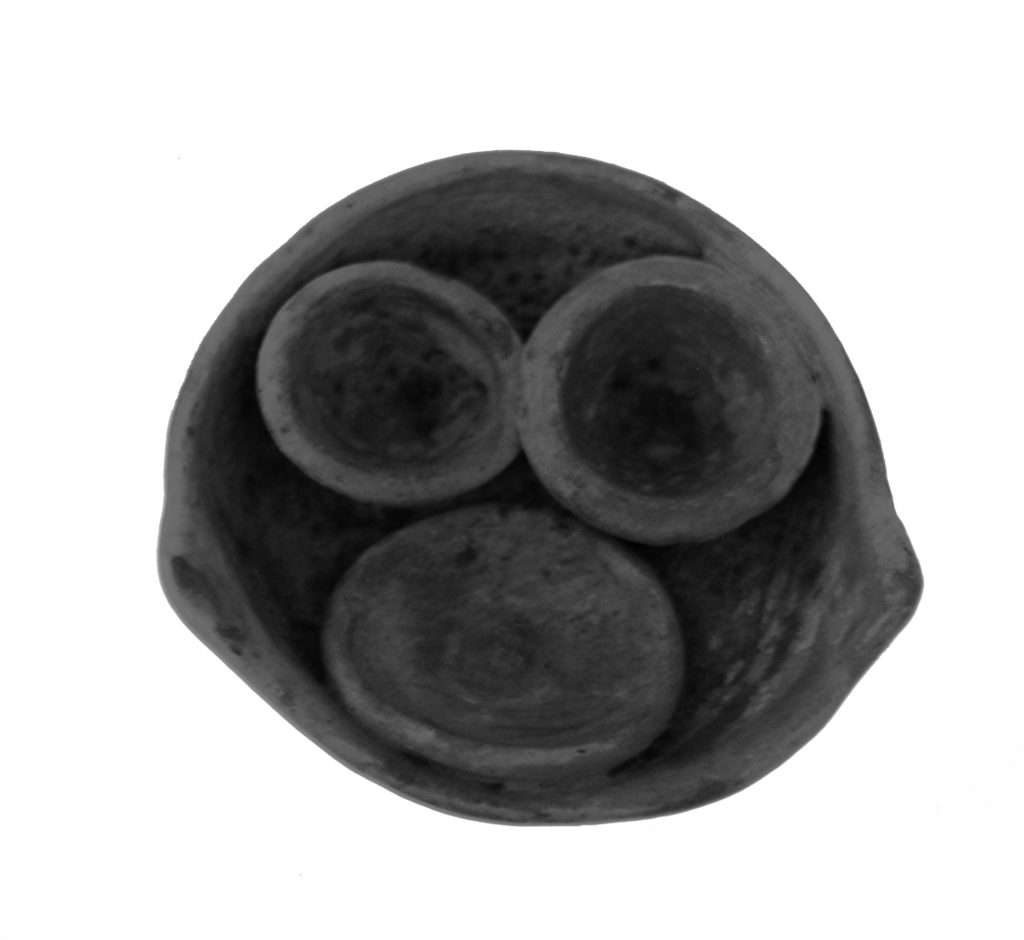

Cosmetics container
Earthenware
Unknown date and source
The small round dishes inside this container had red iron oxide or ochre clays and charcoal mixed with olive oil for lip, cheek and eyebrow make-up.
Presented by Viscount Strangford to Canterbury Philosophical and Literary Institution Museum, 1844, and acquired through purchase of the museum by Canterbury Corporation, 1846-47
Reference: 1005
Can be found: Viscount Strangford in Explorers and Collectors Collection


Cowroid
Faience cowroid. Hole for cord (second from the left) and a selection of blue and green glazed beads.
Reference: E257
Can be found: Ancient EgyptMiddle Shelf in Explorers and Collectors Collection
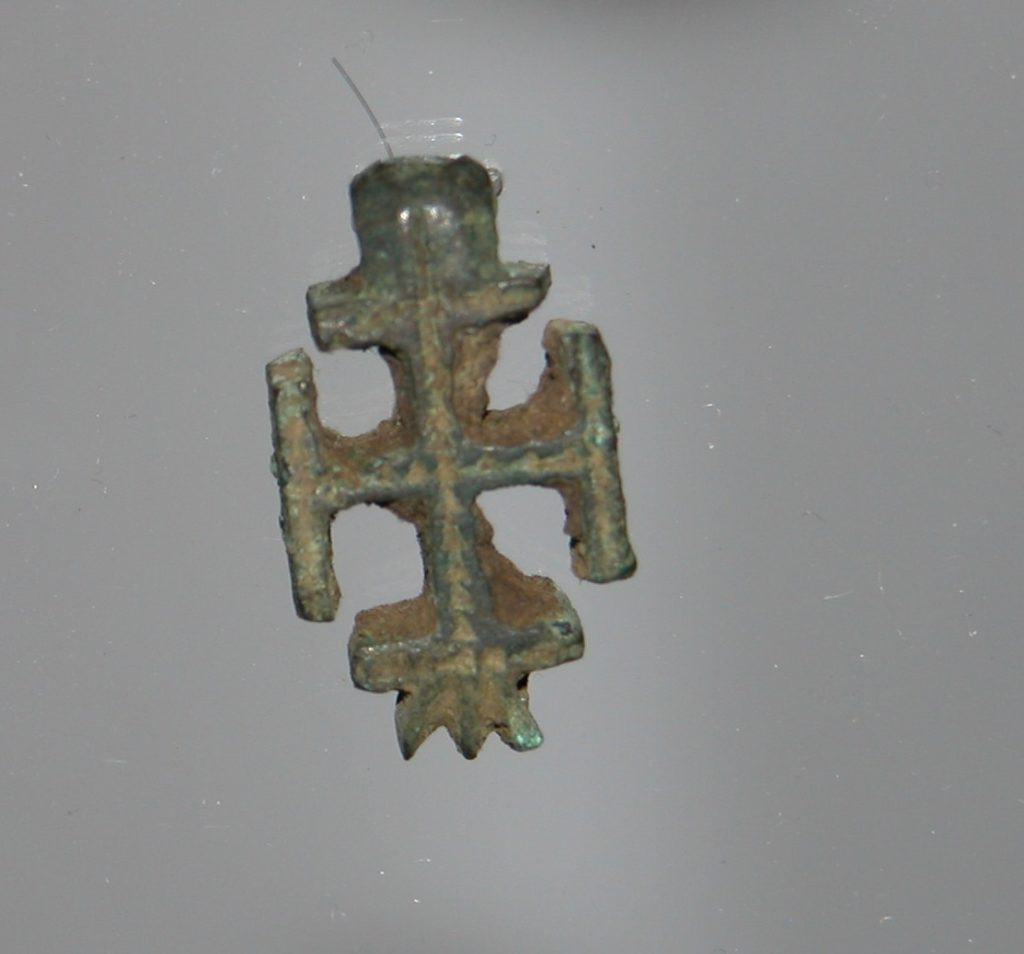

Cross
A coptic cross.
Reference: E117
Can be found: Ancient EgyptMiddle Shelf in Explorers and Collectors Collection


Cruciform Brooch
5th – 8th Century AD
Copper Alloy
Bronze gilt brooch of cruciform shape and foreign manufacture, probably from South West Germany. This type is very rarely found in England, and another example is known from Silton, Ash, Kent.
Found by Mr. J Brent.
Reference: CANCM:2678
Can be found: Middle ShelfThe Anglo-Saxon Kingdom of Kent in Explorers and Collectors Collection

















































































































Crystal Sphere
5th – 8th Century AD
Crystal
Crystal sphere in a silver sling. It is not known what these spheres were used for, but they are often found in the graves of women alongside silver spoons. It has been suggested that they may have been used to symbolically purify water.
Bequeathed by Mr. J. Brent.
Reference: CANCM:2144
Can be found: Middle ShelfThe Anglo-Saxon Kingdom of Kent in Explorers and Collectors Collection

















































































































Crystal Sphere
5th – 8th Century AD
Crystal
Crystal ball suspended in silver sling, with silver wire ring through the top of the sling.
Found in Bekesbourne, Kent, UK. by Mr. P.G. Wilson.
Reference: CANCM:7518
Can be found: Middle ShelfThe Anglo-Saxon Kingdom of Kent in Explorers and Collectors Collection
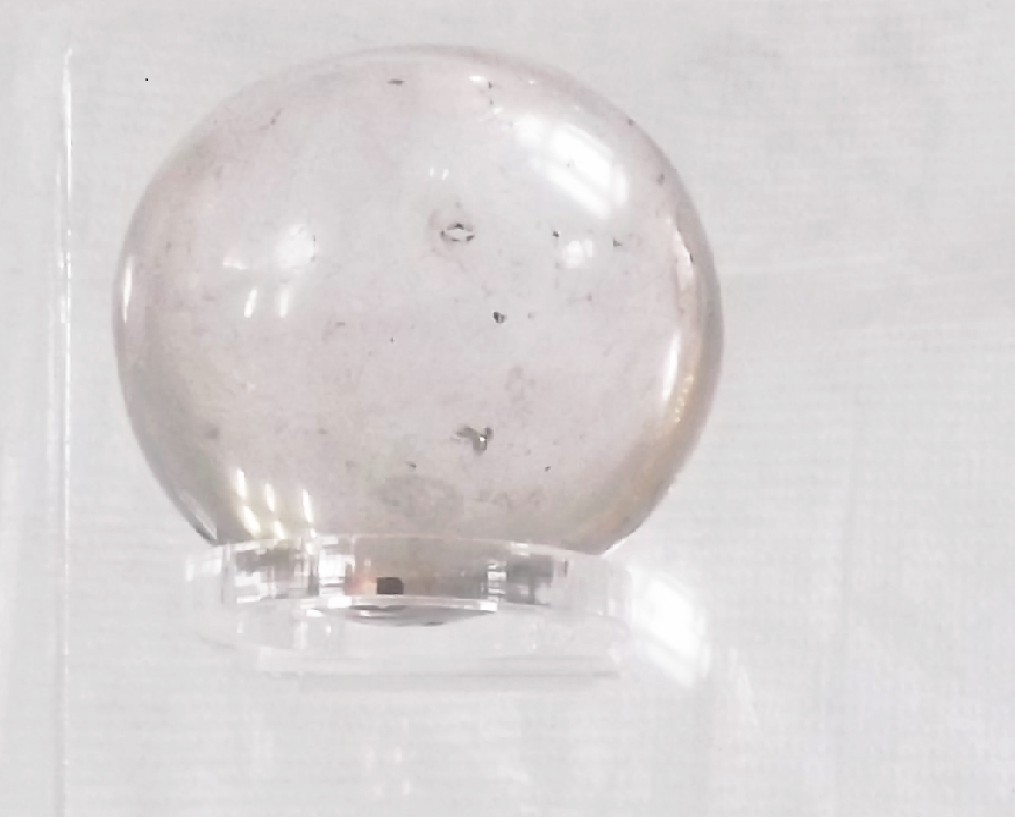


Crystal Sphere
5th – 8th Century AD
Crystal
Large crystal ball without the suspender. The purpose of Anglo Saxon crystal balls is unclear: they may have been used as a magnifying glass, or perhaps even had a magical or ritual use. They are often found in the graves of women next to silver spoons.
Reference: CANCM:2616
Can be found: Bottom ShelfThe Anglo-Saxon Kingdom of Kent in Explorers and Collectors Collection



Crystal Sphere
5th – 8th Century AD
Crystal
Large crystal ball without the suspender. The purpose of Anglo Saxon crystal balls is unclear: they may have been used as a magnifying glass, or perhaps even had a magical or ritual use. They are often found in the graves of women next to silver spoons.
Found at Mersham, Kent in 1828.
Reference: CANCM:2616
Can be found: Bottom ShelfThe Anglo-Saxon Kingdom of Kent in Explorers and Collectors Collection


Cup
Fifth to 6th Century AD
Ceramic
Ceramic mug in a brownish ware. This cup was handmade, and would have been burnished (rubbed at speed with a leather cloth) to made it more watertight.
Found in the Marlowe Car Park, 1982. Presented by Canterbury Archaeological Trust.
Reference: CANCM:nn
Can be found: Bottom ShelfThe Anglo-Saxon Kingdom of Kent in Explorers and Collectors Collection


Decorated spoons
19th century; collected in Russia
Painted wood
There is a Russian Orthodox image inside the bowl and a rose underneath.
Presented by Mary Landsdell in memory of her late husband, 1922
Reference: 2006.56.1.1-2
Can be found: Henry Lansdell in Explorers and Collectors Collection


Decoration from a Burmese building
19th century; probably Mandalay, Burma
Wood and gold leaf
19th century; probably Mandalay, Burma Wood and gold leaf
This is one of several souvenirs brought back from Burma after British forces overthrew King Thibaw in 1885. His palace in Mandalay was ransacked and its decorations, including this panel, dismantled.
Presented by Miss Mona Sharp, 1908
Reference: 4867
Can be found: Heroes and VillainsTravellers to the East in Explorers and Collectors Collection

















































































































Disc Brooch
Mid 5th-6th Century AD
Copper Alloy
Copper alloy disc brooch decorated with a quincunx (group of five) of cup-and-dot decorations, a favoured decorative motif in this period.
Reference: Excavated in 1978 from the Marlowe Car Park. Presented by Canterbury Archaeological Trust CANCM:1980.12.1160
Can be found: The Anglo-Saxon Kingdom of KentTop Shelf in Explorers and Collectors Collection

















































































































Disc Brooch
5th – 8th Century AD
Silver and garnet
Circular silver gilt disc brooch set with 3 square and 1 round garnet
Found in Faversham; King’s Field, Kent, by Mr. J. Brent.
Reference: CANCM:2659
Can be found: Middle ShelfThe Anglo-Saxon Kingdom of Kent in Explorers and Collectors Collection


Djed Pillar
Emblem of stability (connected with Osiris) with green glaze/faience.
Reference: CANCM: 2123
Can be found: Ancient EgyptBottom Shelf in Explorers and Collectors Collection


Doll, antidote to disease
19th century; collected in Tyr, Russian Far East Wood.
“The Gilyaks believe in wooden idols or charms as antidotes to disease,” wrote Lansdell. Plague had been raging across Russia in 1879. The Gilyaks lived near the border with China. At Tyr, on the rivers Amur and Amaun, Lansdell “wished to buy some of the little amulets belonging to the head of the household” of a Gilyak family, including “those of his baby, one of them a doll in a sitting posture”. But the man was unwilling to sell until offered “a silver piece”. Then he “sent after me a fish rudely cut in wood, and meant for a sturgeon [the fish famous for its roe, known as caviar], with a little god seated
on his back. This had been used, apparently, not long before, on a fishing expedition.”
Presented by Mary Landsdell in memory of her late husband, 1922
Reference: 2006.56.94
Can be found: Henry Lansdell in Explorers and Collectors Collection

















































































































Dragon sculptures
Carved wood
These two carved wooden dragons were looted from the personal railway carriage of the dowager Empress of China during the Boxer Rebellion in Peking (Beijing) in 1900. It is not known how they came into the possession of the Buffs, as the regiment did not take part in what was known as the 3rd China War.
Donated to the National Army Museum, London, by the Trustees of the Buffs Regimental Trust, 2001
Reference: 2001.04-778-1 & 2
Can be found: The Buffs in Explorers and Collectors Collection


Draped female figure holding round instrument in left hand
Delos, 1823
Terracotta
Reference: 4183
Can be found: Viscount Strangford in Explorers and Collectors Collection
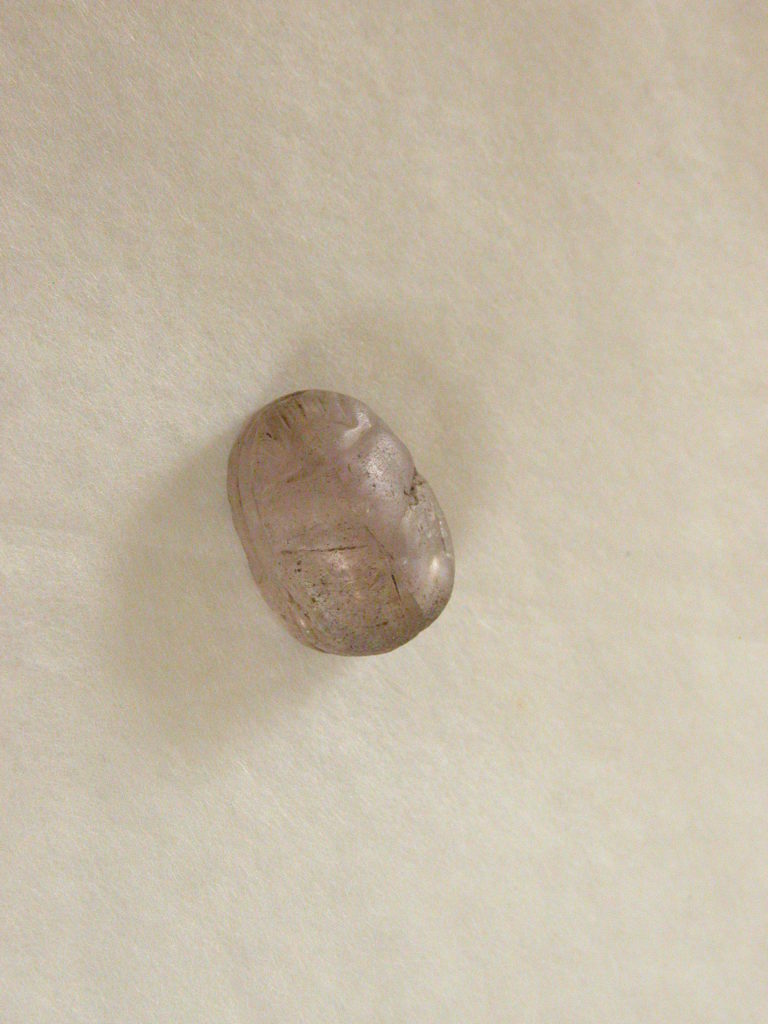

Early Egyptian (Pre-Dynastic) food and storage jars
Earlier than 3,000 BC.
Reference: CANCM:nn
Can be found: Ancient EgyptTop Shelf in Explorers and Collectors Collection


Egyptian Figurine
Bronze Egyptian figure of Buto, the nurse of Horus.
Reference: CANCM: 4130
Can be found: Ancient EgyptMiddle Shelf in Explorers and Collectors Collection


Egyptian Figurine
Small faience Egyptian deity amulet perforated for suspension.
Reference: CANCM: 4407
Can be found: Ancient EgyptMiddle Shelf in Explorers and Collectors Collection


Egyptian Figurine
Bronze Egyptian figure of Isis or Hathor bearing a disc or moon on her head.
Reference: CANCM: 4122
Can be found: Ancient EgyptMiddle Shelf in Explorers and Collectors Collection

















































































































Enamelled Disc
5th – 8th Century AD Copper Alloy
Enamelled disc, possibly from side of a hanging bowl and used to suspend it. Design is of celtic origin thrown up by red champleve enamel. It probably comes from Western England, or Wales.
Found in Greenwich; Tilting Yard, Kent, UK. by Mr. J. Brent
Reference: CANCM:2157
Can be found: Middle ShelfThe Anglo-Saxon Kingdom of Kent in Explorers and Collectors Collection

















































































































Enamelled Disc
5th – 8th Century AD
Copper Alloy
Enamelled disc, similar to above.
Found in Greenwich; Tilting Yard, Kent, UK. by Mr. J. Brent
Reference: CANCM:2158
Can be found: Middle ShelfThe Anglo-Saxon Kingdom of Kent in Explorers and Collectors Collection


Ewer
19th century; made in Kokand, acquired in Bukhara
Brass
Container for water or wine, a gift from the Emir of Bukhara.
Presented by Mary Landsdell in memory of her late husband, 1922
Reference: 2006.56.41.1
Can be found: Henry Lansdell in Explorers and Collectors Collection


Face slapper
19th century; acquired at Kashgar prison, China, 1888
Leather
Described by Lansdell as “for slapping naughty women’s faces”. It was used in one of the prisons he visited.
Presented by Mary Landsdell in memory of her late husband, 1922
Reference: 2006.56.26
Can be found: Henry Lansdell in Explorers and Collectors Collection
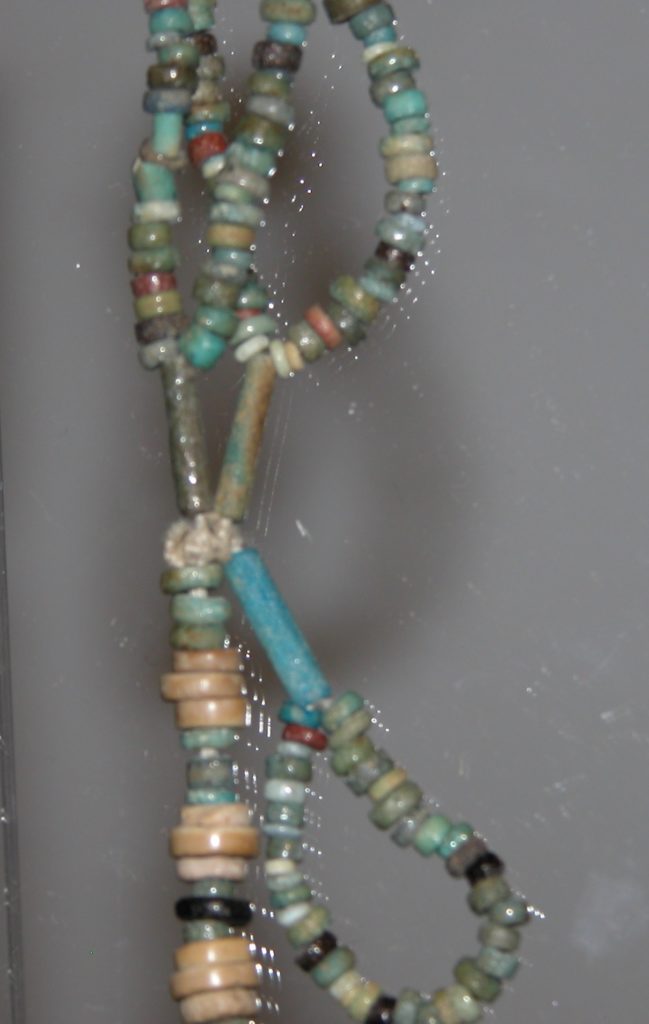

Faience Necklace
A necklace of small faience beads in blue and white with modern stringing.
Reference: 1979
Can be found: Ancient EgyptMiddle Shelf in Explorers and Collectors Collection


Faience Scarab
Small green glazed scarab with seal/faience scarab, possibly fake.
Reference: CANCM: 2020
Can be found: Ancient EgyptBottom ShelfCollection of scarabs in Explorers and Collectors Collection


Female figure with flowing robe From Delos
Terracotta
Reference: 4178
Can be found: Viscount Strangford in Explorers and Collectors Collection


Female head
Terracotta
Reference: 4184
Can be found: Viscount Strangford in Explorers and Collectors Collection


Figure
Shabti worker figurine. Bluish colour Shabtin figure/ faience worker Shabti.
Reference: CANCM: 2033
Can be found: Ancient EgyptBottom Shelf in Explorers and Collectors Collection


Figurine
Bronze figurine of Osiris.
Reference: E397
Can be found: Ancient EgyptMiddle Shelf in Explorers and Collectors Collection


Figurine
Bronze Egyptian Amun-re statuette with hook for suspension.
Reference: CANCM:4206
Can be found: Ancient EgyptMiddle Shelf in Explorers and Collectors Collection


Figurine
Stone statuette, possibly depicting Nilus.
Reference: CANCM: 4127
Can be found: Ancient EgyptMiddle Shelf in Explorers and Collectors Collection


Figurine
Harpocrates (The child Horus); bronze Egyptian figure, minus legs.
Reference: CANCM: 4134
Can be found: Ancient EgyptMiddle Shelf in Explorers and Collectors Collection


Finger ring
9th -11th Century AD
Gold
A gold finger ring made of two strands of gold twisted together and flattened at the ends. Found in Canterbury during the late Victorian period, possibly in Dane John Gardens. Originally part of the Trimnell Collection.
Reference: CANCM:9934.1
Can be found: The English and the Vikings in Explorers and Collectors Collection


Fish Brooch
5th – 8th Century AD
Copper Alloy and garnets
Cast silver fish brooch with geometric decoration and garnet set eye, fins and tail.
Found in Westbere (Anglo-Saxon cemetery) Kent, UK. Bequeathed by Osborne Dan.
Reference: CANCM:6422
Can be found: Middle ShelfThe Anglo-Saxon Kingdom of Kent in Explorers and Collectors Collection


Foot with sandal strap
Found at Athens
Partial foot of a marble sculpture, with sandal thongs imitating creepers.
Reference: 4215
Can be found: Viscount Strangford in Explorers and Collectors Collection


Fragment of a sculptured frieze Unknown date and source
Stone
Probably formed part of architectural decoration. The drilled holes create lines of shadow.
Presented by Viscount Strangford to Canterbury Philosophical and Literary Institution Museum, 1844, and acquired through purchase of the museum by Canterbury Corporation, 1846-47
Reference: 4250
Can be found: Viscount Strangford in Explorers and Collectors Collection


Fragment of a votive dedication 3rd to 1st century BC; from a shrine in Mysia, north west Turkey
Marble
Inscribed with a Greek dedication to local god Zeus Olbios.
Presented by Viscount Strangford to Canterbury Philosophical and Literary Institution Museum, 1844, and acquired through purchase of the museum by Canterbury Corporation, 1846-47
Reference: 4218
Can be found: Viscount Strangford in Explorers and Collectors Collection


Fragmentary relief
Unknown date; found at Buyukdere, Istanbul, Turkey Stone
This fragment probably relates to the labours of Hercules.
Presented by Viscount Strangford to Canterbury Philosophical and Literary Institution Museum, 1844, and acquired through purchase of the museum by Canterbury Corporation, 1846-47
Reference: 4266
Can be found: Viscount Strangford in Explorers and Collectors Collection


Funerary monument
Unknown date; found at Brusa (now Bursa) Turkey, 1823
Stone
The marble with a woman holding a lyre or harp is inscribed ‘Farewell to grieve no more, loved young and worthy Zosime’, a Greek female name.
Presented by Viscount Strangford to Canterbury Philosophical and Literary Institution Museum, 1844, and acquired through purchase of the museum by Canterbury Corporation, 1846-47
Reference: 4269
Can be found: Viscount Strangford in Explorers and Collectors Collection
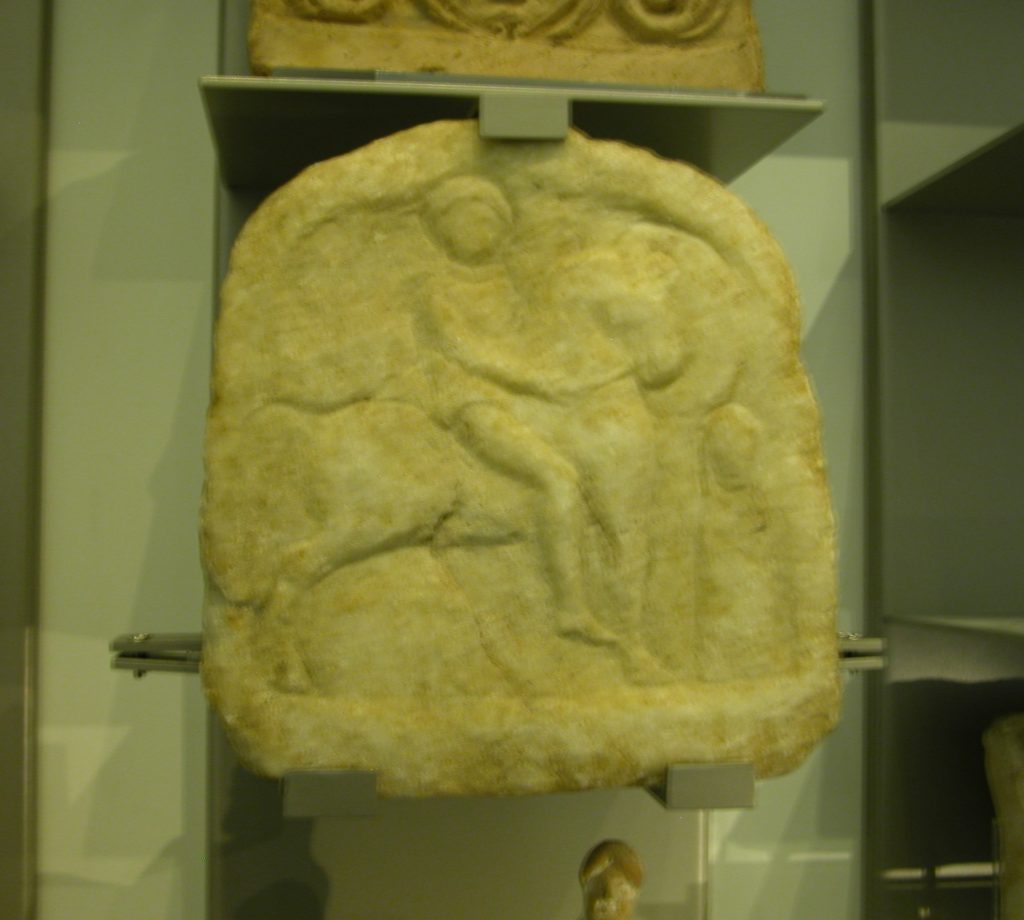

Funerary monument
Unknown date; probably found in Turkey
Stone
The fragment of votive stone with horse and rider is unidentified.
Presented by Viscount Strangford to Canterbury Philosophical and Literary Institution Museum, 1844, and acquired through purchase of the museum by Canterbury Corporation, 1846-47
Reference: 4219
Can be found: Viscount Strangford in Explorers and Collectors Collection


Funerary monument
Unknown date; found at Adrianople (modern Edirne), Turkey
Stone
The family scene shows a seated man and woman with attendants or family, including children, and a horse visible through a window.
Presented by Viscount Strangford to Canterbury Philosophical and Literary Institution Museum, 1844, and acquired through purchase of the museum by Canterbury Corporation, 1846-47
Reference: 4192
Can be found: Viscount Strangford in Explorers and Collectors Collection


Funerary monument
Unknown date; probably found in Turkey
Stone
The gravestone with two figures reclining, a tripod table and servant in front of them, is inscribed ‘Farewell, worthy Nicotyche’.
Presented by Viscount Strangford to Canterbury Philosophical and Literary Institution Museum, 1844, and acquired through purchase of the museum by Canterbury Corporation, 1846-47
Reference: 4268
Can be found: Viscount Strangford in Explorers and Collectors Collection


Funnel-Shaped Vase
5th – 8th Century AD
Glass
Cone beaker, with vertical fluting and horizontal thread of opaque white glass below the rim. Cone beakers may have been used at feasts where, because they had no bases, the drinkers would have had to down the contents in one go, perhaps as a toast.
Found in Westbere (Anglo-Saxon cemetery) Kent, UK. Bequeathed by Osborn Dan.
Reference: CANCM:6429
Can be found: Middle ShelfThe Anglo-Saxon Kingdom of Kent in Explorers and Collectors Collection


Furniture Fitting
Buckle of tin girdle hook/wooden tyet (the buckle of Isis) emblem furniture fitting.
Reference: CANCM:2108
Can be found: Ancient EgyptMiddle Shelf in Explorers and Collectors Collection


Furniture Fitting
Emblem of stability. Assonan/Djed emblem wooden furniture.
Reference: CANCM: 2115
Can be found: Ancient EgyptBottom Shelf in Explorers and Collectors Collection


Gilt Brooch or Mount
Late 6th – Early 7th Century AD
Copper alloy and gold
Gilded copper alloy small-long brooch or mount in four pieces.
Presented by Canterbury Archaeological Trust
Reference: CANCM:1988.57.3
Can be found: The Anglo-Saxon Kingdom of KentTop Shelf in Explorers and Collectors Collection



Gilt Pin1
5th – 8th Century AD
Copper Alloy
A highly ornamented, fine gilded, bronze pin.
Found at Guilton, Ash, Kent by Mr. Kingsford. Given to the museum by Mr J. Brent.
Reference: CANCM: 2714
Can be found: Bottom ShelfThe Anglo-Saxon Kingdom of Kent in Explorers and Collectors Collection



Gilt Pin1
5th – 8th Century AD
Copper Alloy
A highly ornamented, fine gilded, bronze pin.
Found at Guilton, Ash, Kent by Mr. Kingsford. Given to the museum by Mr J. Brent.
Reference: CANCM: 2714
Can be found: Bottom ShelfThe Anglo-Saxon Kingdom of Kent in Explorers and Collectors Collection


Girdle-Hanger
5th – 8th Century AD
Copper Alloy
Bronze girdle-hanger. This type of object, often found in Anglo Saxon women’s graves, imitates a key. It has been suggested that girdle-hangers symbolise that women controlled access to the home.
Found at Eastry, Kent in 1792. Presented to the museum by Dr. W.G. Urry after a loan from Mr Irby
Reference: CANCM:7500
Can be found: Bottom ShelfThe Anglo-Saxon Kingdom of Kent in Explorers and Collectors Collection

















































































































Glass Jar
5th – 8th Century AD
Glass
Green glass vessel, repaired.
Faversham, Kent, UK. Brent, J., Mr.
Reference: CANCM:2149
Can be found: Middle ShelfThe Anglo-Saxon Kingdom of Kent in Explorers and Collectors Collection


Glass jar
5th – 8th Century AD
Glass
Reference: CANCM:nn
Can be found: Bottom ShelfThe Anglo-Saxon Kingdom of Kent in Explorers and Collectors Collection


Globular vase with arabesque pattern
Reference: 4116
Can be found: Viscount Strangford in Explorers and Collectors Collection


Goblets
19th century; acquired in Srinagar, Kashmir, India, 1888
Copper
Presented by Mary Landsdell in memory of her late husband, 1922
Reference: 2006.56.38.1-2
Can be found: Henry Lansdell in Explorers and Collectors Collection


Gold Pendant
6th – 7th Century AD
Gold
Pendant. The central swastika, or Tetraskele, was used on many items in the Early Anglo-Saxon period.
Found by a metal detectorist near Manston in Kent. Acquired for the museum through the Portable Antiquities scheme.
Reference: CANCM:2014.8
Can be found: The Anglo-Saxon Kingdom of KentTop Shelf in Explorers and Collectors Collection

















































































































Gold Pendant
5th – 8th Century AD
Gold
Small gold pendant set with cross in centre.
Bequeathed by Mr. J. Brent.
Reference: CANCM:2162
Can be found: Middle ShelfThe Anglo-Saxon Kingdom of Kent in Explorers and Collectors Collection

















































































































Gold Pendant
5th – 8th Century AD
Gold
Small gold pendant set with garnets, may have been used as a sword bead.
Found in Anglo Saxon cemetery at Stouting, Faversham. Collected by Mr. J. Brent.
Found in Anglo Saxon cemetery at Stouting, Faversham. Collected by Mr. J. Brent.
Reference: CANCM:2161
Can be found: Middle ShelfThe Anglo-Saxon Kingdom of Kent in Explorers and Collectors Collection


Gravestone
Unknown date; probably from Turkey
Stone
A tall gravestone inscribed ‘Farewell having received these delights, Pollothemis’. The deceased is shown sitting beside her husband, with servants, laid table, and oxen pulling a plough.
Presented by Viscount Strangford to Canterbury Philosophical and Literary Institution Museum, 1844, and acquired through purchase of the museum by Canterbury Corporation, 1846-47
Reference: 4270
Can be found: Viscount Strangford in Explorers and Collectors Collection


Hand with a scroll
Found at Adrianople (modern Edirne), Turkey
Marble
Reference: 4197
Can be found: Viscount Strangford in Explorers and Collectors Collection


Head of a woman with a garland
Marble
Reference: 4208
Can be found: Viscount Strangford in Explorers and Collectors Collection


Headless statue of a male
Unknown date, probably Roman
Stone
Presented by Viscount Strangford to Canterbury Philosophical and Literary Institution Museum, 1844, and acquired through purchase of the museum by Canterbury Corporation, 1846-47
Reference: 4261
Can be found: Viscount Strangford in Explorers and Collectors Collection


Hindu shrine
19th century; collected in Varanasi, Utter Pradesh, India
Metal
Presented by Mary Landsdell in memory of her late husband, 1922
Reference: 2006.56.55
Can be found: Henry Lansdell in Explorers and Collectors Collection
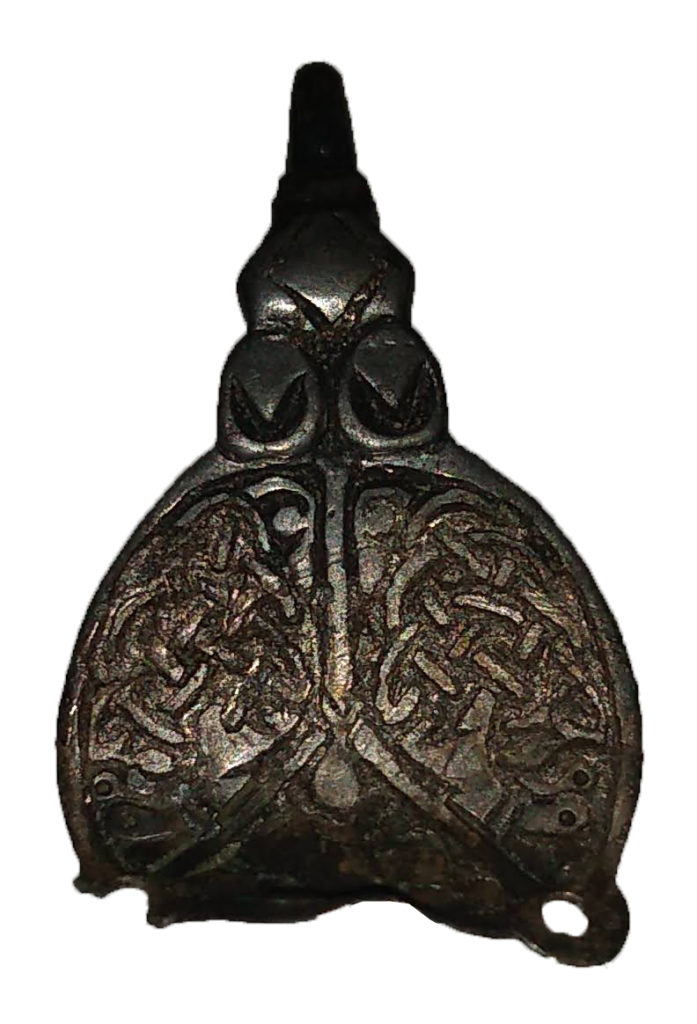

Hooked Tag
9th-10th Century AD
Silver
Hooked tags were used for a variety of functions, but primarily they were used to secure garments and purses. They would have been sewn to the cloth through the pierced lugs at the top of the tag (one of which is now broken). This tag is very ornately decorated, with each of the three areas containing a stylised depiction of an animal.
Presented by Canterbury Archaeological Trust.
Reference: CANCM:1980.12.805
Can be found: The English and the Vikings in Explorers and Collectors Collection


Idol wreaths
19th century; collected in Bindraban, India
Paper
Presented by Mary Landsdell in memory of her late husband, 1922
Reference: 2006.56.52.1-2
Can be found: Henry Lansdell in Explorers and Collectors Collection


Islamic green shawl
19th century
Embroidered silk
Green relates to paradise and is the traditional colour of Islam.
Presented by Mary Landsdell in memory of her late husband, 1922, and conserved with grant-aid from the Kathy Callow Trust, 2012
Reference: 2006.56.47
Can be found: Henry Lansdell in Explorers and Collectors Collection


Ivy-crowned head of Bacchus Marble
Reference: 4194
Can be found: Viscount Strangford in Explorers and Collectors Collection


Jail stamps
19th century; collected in Bindraban, India
Iron
Lansdell visited a number of prisons on his travels across Asia.
Presented by Mary Landsdell in memory of her late husband, 1922
Reference: 2006.56.51.1-3
Can be found: Henry Lansdell in Explorers and Collectors Collection


Jar
Small stone jar.
Reference: E9
Can be found: Ancient EgyptMiddle Shelf in Explorers and Collectors Collection
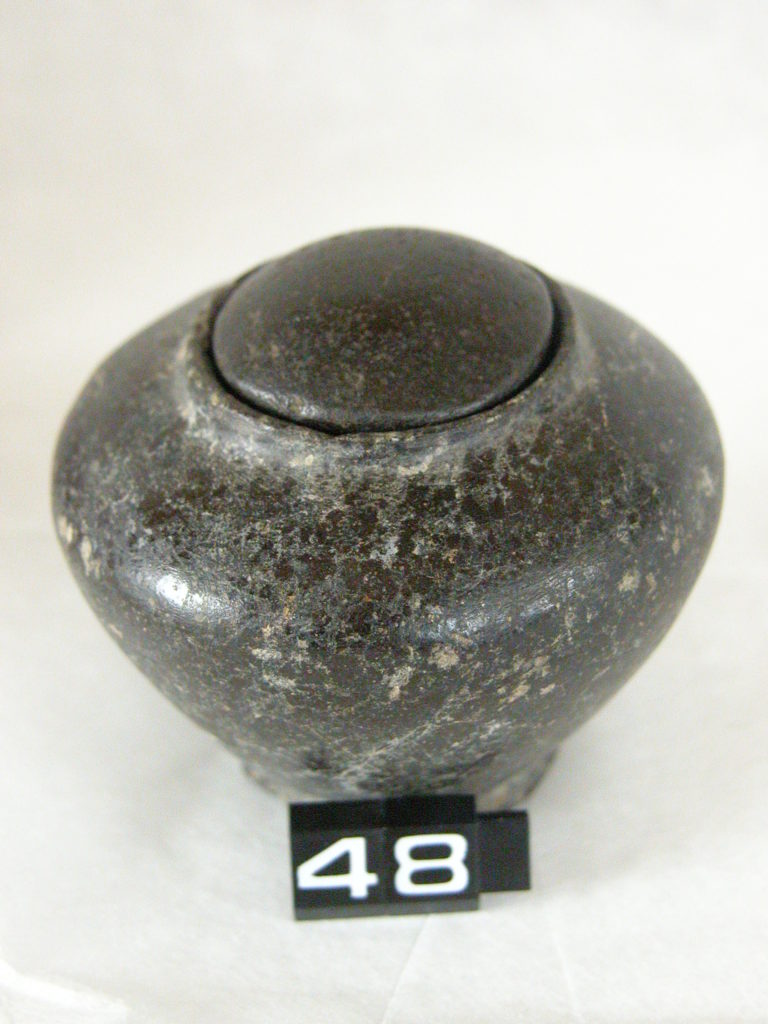

Jar
Egyptian cosmetic container in stone, maybe a kohl pot (front row 3rd from left).
Reference: CANCM:6145
Can be found: Ancient EgyptMiddle Shelf in Explorers and Collectors Collection


Jar
Small stone jar for eye paint.
Reference: E338
Can be found: Ancient EgyptMiddle Shelf in Explorers and Collectors Collection


Jar
Small stone jar for eye paint.
Reference: E337
Can be found: Ancient EgyptMiddle Shelf in Explorers and Collectors Collection


Jasper Earring
Circular red stone bead.
Reference: 2120
Can be found: Ancient EgyptMiddle Shelf in Explorers and Collectors Collection


Jewish scroll
19th century; bought in Bukhara, 1888
Paper and wood
Hebrew text from the Book of Esther, sold to Lansdell by a Rabbi.
Presented by Mary Landsdell in memory of her late husband, 1922
Reference: 2006.56.39
Can be found: Henry Lansdell in Explorers and Collectors Collection


Kazakh girdle
19th century; bought in Tashkent Leather
Kazakhs live in Turkestan, southern Asia, which was annexed by Russia in 1864.
Lansdell is wearing this girdle in the photograph of himself in Kokand armour and Afghan embroidered trousers.
Presented by Mary Landsdell in memory of her late husband, 1922
Reference: 2006.56.13
Can be found: Henry Lansdell in Explorers and Collectors Collection


Kazakh purse
19th century; bought in Tashkent
Leather
Kazakhs live in Turkestan, southern Asia, which was annexed by Russia in 1864.
Lansdell is wearing this purse in the photograph of himself in Kokand armour and Afghan embroidered trousers.
Presented by Mary Landsdell in memory of her late husband, 1922
Reference: 2006.56.14
Can be found: Henry Lansdell in Explorers and Collectors Collection

















































































































Key
6th-7th Century AD
Copper Alloy
Key with shepherd’s crook suspension loop. It was cast in bronze and finished by hand with deeply cut out carving.
Excavated in 1978 from the Marlowe Car Park. Presented by Canterbury Archaeological Trust
Reference: CANCM:1978.3.1278
Can be found: The Anglo-Saxon Kingdom of KentTop Shelf in Explorers and Collectors Collection


Knife
Around 950 AD
Iron, Bone
Iron knife with worked bone handle carved with serpents. Each bone piece is decorated with a pattern in an oblong box, both ends of which end in stylised animal masks. The two sides have slightly different designs. This is typical of Northern English work of the 10th Century. It is likely that it was made in the Danish Kingdom of York, known as the Danelaw. The side with the knife point at the bottom has a chain-like design. This is a well known Scandinavian design known as Borre style.
The short, wide blade is unusual amongst knives discovered from this era. It is most likely a craftsman’s knife which would, rather like a modern craft knife, allow a lot of pressure to be exerted onto its point for carving. It may have been a bone carver’s tool.
Excavated in Castle Street, Canterbury, in 1976. Presented by Canterbury Archaeological Trust.
Reference: CANCM:1976.2.97
Can be found: The English and the Vikings in Explorers and Collectors Collection


Kohl Jar
Alabaster kohl jar (middle row 1st on left).
Reference: CANCM: 2005
Can be found: Ancient EgyptMiddle Shelf in Explorers and Collectors Collection


Kohl Jar
Alabaster Kohl Jar (back row 1st on left).
Reference: CANCM: 2007
Can be found: Ancient EgyptMiddle Shelf in Explorers and Collectors Collection


Kohl Jar
Alabaster kohl jar with lid/stone cosmetic container or Kohl pot.
Reference: CANCM: 2003.1-2
Can be found: Ancient EgyptMiddle Shelf in Explorers and Collectors Collection
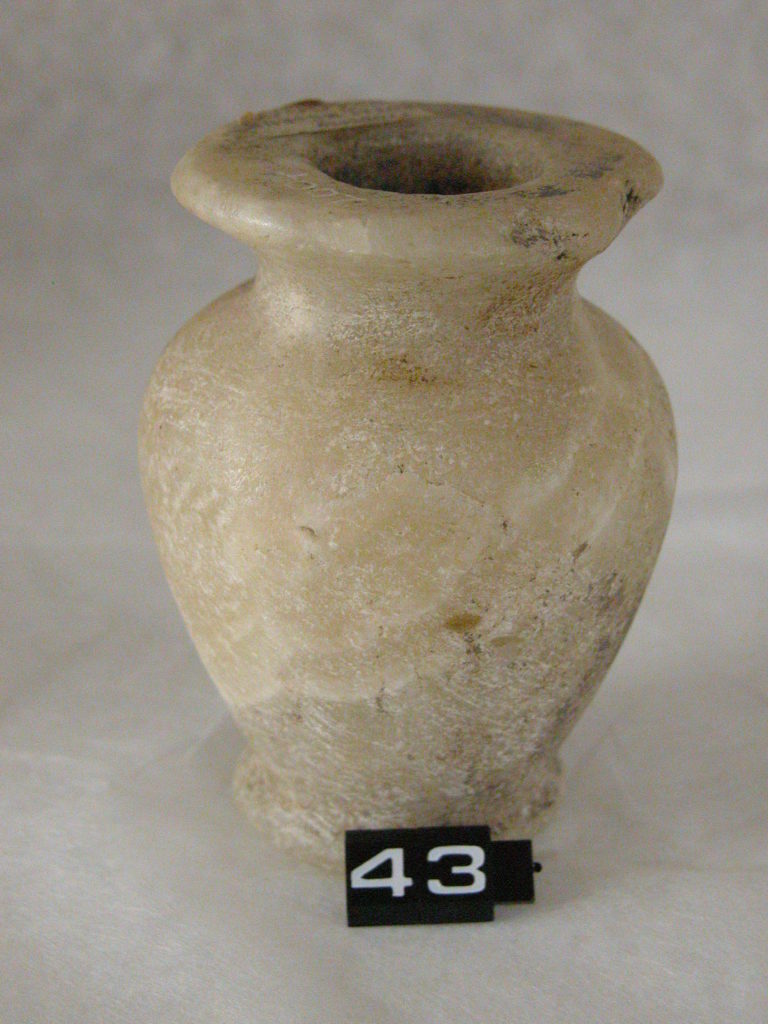

Kohl Jar
Alabaster kohl jar card, stone jar containing piece of cloth.
Reference: CANCM: 2004
Can be found: Ancient EgyptMiddle Shelf in Explorers and Collectors Collection


Kohl jar
Alabaster kohl jar with lid (back row last on right).
Reference: CANCM:2001
Can be found: Ancient EgyptMiddle Shelf in Explorers and Collectors Collection


Lamp
4th to 2nd century BC Greek and 1st to 2nd century AD Roman
Earthenware
The round oil lamps were mass-produced in moulds with a variety of decoration. Oil was poured in through a central hole and wicks for light placed in the corner spouts.
Presented by Viscount Strangford to Canterbury Philosophical and Literary Institution Museum, 1844, and acquired through purchase of the museum by Canterbury Corporation, 1846-47
Reference: 993
Can be found: Viscount Strangford in Explorers and Collectors Collection


Lamp shaft in the form of a female holding her robe
Reference: 4193
Can be found: Viscount Strangford in Explorers and Collectors Collection


Lekythos
Black figure with a four-horse chariot with a draped female figure
Reference: 4153
Can be found: Viscount Strangford in Explorers and Collectors Collection


Lekythos
Red figure with Nike pouring at an altar [bits missng]
Reference: 4152
Can be found: Viscount Strangford in Explorers and Collectors Collection


Lekythos
Design very worn
Reference: 4114
Can be found: Viscount Strangford in Explorers and Collectors Collection


Lekythos
Reference: 4108
Can be found: Viscount Strangford in Explorers and Collectors Collection


Lekythos
Reference: 4107
Can be found: Viscount Strangford in Explorers and Collectors Collection


Lekythos
Charioteer driving a four-horse chariot
Reference: 4154
Can be found: Viscount Strangford in Explorers and Collectors Collection

















































































































Letter written in blood
1810
Photograph of original
In November 1810, during the Peninsular War, Captain Joseph Fenwick was wounded in action with a French foraging party at Chamusca, Portugal. He had no ink with which to write a message so he wrote in his own blood: “I am shot through the body and arm for God sake send me a surgeon English if possible. If I do not recover God Bless you all.” Fenwick died of his wounds. In reporting his death the Duke of Wellington wrote: “he is lamented by all that had any knowledge of his gallantry.”
Image courtesy of the National Army Museum, London
Reference: CANCM:nn
Can be found: The Buffs in Explorers and Collectors Collection


Lime gourd
19th century; Solomon Islands
Gourd rind
The gourd was used for burning coral to create lime, which was chewed with beetle leaves.
Reference: CANCM:nn
Can be found: Heroes and VillainsTravellers to the Pacific, Australasia and America in Explorers and Collectors Collection


Linen Cloth
Specimen of linen cloth with wide purple border with pattern/Coptic textile.
Reference: CANCM: 5161
Can be found: Ancient EgyptBottom Shelf in Explorers and Collectors Collection


Linen Cloth
Short length of linen cloth with edge of fringe/ mummy cloth.
Reference: CANCM: 5158
Can be found: Ancient EgyptBottom Shelf in Explorers and Collectors Collection


Linen Cloth
Fragment of torn linen cloth with decanter shaped pattern, Coptic textile.
Reference: CANCM: 5163
Can be found: Ancient EgyptBottom Shelf in Explorers and Collectors Collection


Mace
18th to 19th century; South India
Steel
A weapon for close combat, with flanged head.
Presented by Stephen Lushington to Canterbury Philosophical and Literary Institution Museum, 1825-68, and acquired through purchase of the Museum by Canterbury Corporation, 1846-47
Reference: CANCM:nn
Can be found: Stephen Lushington in Explorers and Collectors Collection


Mace
17th century; South India
Steel
This mace is for close combat. The bottom part of it is hollow and conceals a second weapon: the shaft unscrews and becomes the grip of a slim, sharply pointed double-edged knife. The warrior using the mace thereby has a weapon for each hand.
At the top of the mace-head is a covered opening with a model cobra mounted on a spring. Removal of the cover releases the spring and the cobra pops up. It may have been intended as a decorative hook for hanging the mace.
Presented by Stephen Lushington to Canterbury Philosophical and Literary Institution Museum, 1825-68, and acquired through purchase of the Museum by Canterbury Corporation, 1846-47
Reference: 1267
Can be found: Stephen Lushington in Explorers and Collectors Collection


Mace
17th to 18th century; Mysore, South India
Steel with silver and gold inlay
A royal symbol of power with ‘chocolate orange’-style head, this mace may have been made for Khrshnaraja Wodeyar I (1714– 1732) or an earlier ruler of Mysore. The metal craftsmanship of the shaft is outstanding, with fine decoration of foliage and flowers in gold and silver koftgari inlay. The koftgari technique begins by incising or hatching pattern into the metal surface, then pressing gold or silver wire into the pattern.
The bottom section of the shaft unscrews to become the grip of a slim, sharply pointed double-edged knife concealed in the hollow shaft of the mace.
Presented by Stephen Lushington to Canterbury Philosophical and Literary Institution Museum, 1825-68, and acquired through purchase of the Museum by Canterbury Corporation, 1846-47
Reference: 1266
Can be found: Stephen Lushington in Explorers and Collectors Collection

















































































































Mahratta flag in a case
Cloth, wood and glass
The Mahratta (Maratha) Empire was the most powerful in India until conquered by the British in the early 19th century. Mahratta warriors continued to fight the British. At the Battle of Punniar on 29 December 1843, during the British invasion of Gwalior, Mahratta fighters attacked the British forces but were driven off by the Buffs. During the fighting the Mahratta flag was defended bravely by a young warrior, like Lieutenant Latham at Albuhera, until he was killed. The flag was carried by the Buffs as a trophy until 1875, when it was place in this case at Fort William, Calcutta, India.
Donated to the National Army Museum, London, by the Trustees of the Buffs Regimental Trust, 2001
Reference: CANCM:nn
Can be found: The Buffs in Explorers and Collectors Collection


Man’s comb
19th century; collected in Khotan, China, 1888
Wood
Presented by Mary Landsdell in memory of her late husband, 1922
Reference: 2006.56
Can be found: Henry Lansdell in Explorers and Collectors Collection

















































































































Mirror
Bronze round mirror from Thebes.
Reference: 2012/E355
Can be found: Ancient EgyptMiddle Shelf in Explorers and Collectors Collection


Model of a Chinese junk
19th century; China
Wood and textile
The junk is a traditional South-East Asian boat. Each shipyard builds junks in a slightly different way so there are many varied types. Models like this were made for international exhibition.
Presented by Major C Lefevre, OBE, 1945
Reference: CANCM:nn
Can be found: Heroes and VillainsTravellers to the East in Explorers and Collectors Collection


Model of a Malay house
19th-20th century; Malaysia
Wood
This is a faithful model of a house built on stilts, near water or in areas subject to flooding. The roof tiles are of finely split wood planks.
Presented by Rev. F. Payler Woodward, 1914
Reference: L239
Can be found: Heroes and VillainsTravellers to the East in Explorers and Collectors Collection
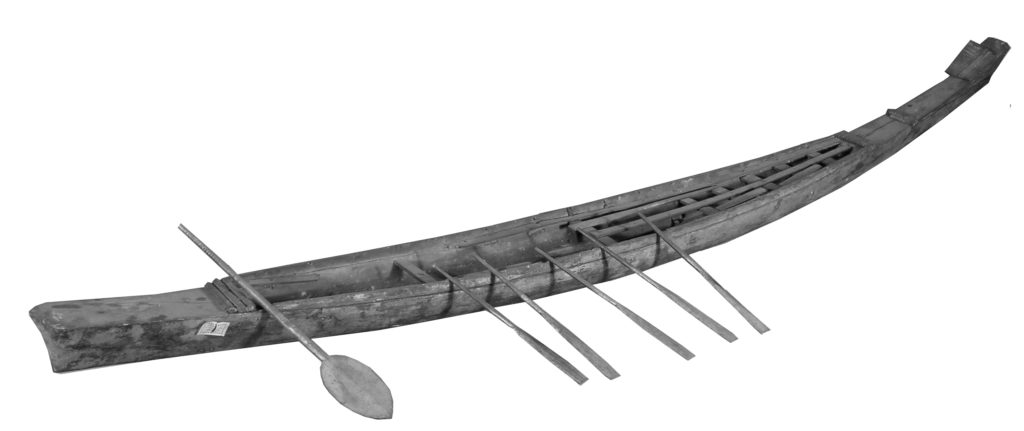

Model of a South-East Asian canoe
19th to 20th century; probably from Burma Wood
Like the Chinese junk, this model of a canoe is made with care to detail of the oars, planks and construction of the full-size equivalent.
Reference: 4522
Can be found: Heroes and VillainsTravellers to the East in Explorers and Collectors Collection


Models of ‘Kangri’ or portable fire-baskets
Fire-baskets were carried inside the Kashmiri Ph’aran or cloak for warmth.
Presented by Mary Landsdell in memory of her late husband, 1922
Reference: 2006.56.37.1-2
Can be found: Henry Lansdell in Explorers and Collectors Collection

















































































































Mount
5th – 8th Century AD
Copper Alloy
Bronze mount, partly gilded, with an animal design.
Found at Guilton, Kent. 1771
Reference: CANCM:2637
Can be found: Bottom ShelfThe Anglo-Saxon Kingdom of Kent in Explorers and Collectors Collection
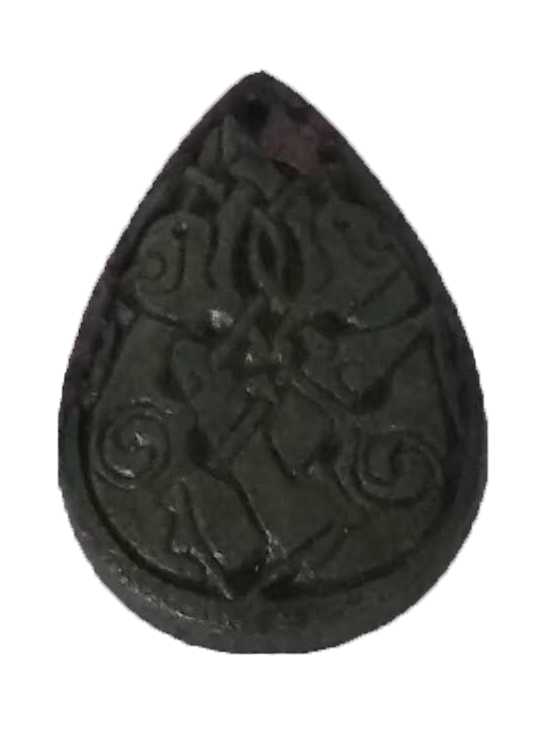

Mount
9th-10th Century AD
Copper Alloy
Teardrop shaped decorated plaque. The piece is decorated with a pair of confronting and interfaced animals. The style of the decoration is closely paralleled in Canterbury manuscript illustrations of the period. It has been tentatively suggested that it may have been part of a book clasp.
Presented by Canterbury Archaeological Trust
Reference: CANCM:1978.1.456
Can be found: The English and the Vikings in Explorers and Collectors Collection


Mummified Cat
This mummified cat, whose face can still be seen, would have had its insides removed and filled with earth or sand before being wrapped in bandages soaked in natron (salt) or resin. The cat’s front...
This mummified cat, whose face can still be seen, would have had its insides removed and filled with earth or sand before being wrapped in bandages soaked in natron (salt) or resin. The cat’s front legs were laid by its side, and its back legs tucked up against its tummy. Bandages have been removed from the cat’s nose and mouth, but you can still see its sharp teeth, fur and whiskers.
Listen here for audio and insights Reference: CANCM:nn
Can be found: Ancient EgyptMiddle Shelf in Explorers and Collectors Collection

















































































































Necklace
5th – 8th Century AD
Glass and Stone
String of 68 beads, of various colours.
Found in a grave in Grove Ferry, Kent. Bequeathed by Lt. Col. Copeland.
Reference: CANCM: 1975
Can be found: Middle ShelfThe Anglo-Saxon Kingdom of Kent in Explorers and Collectors Collection
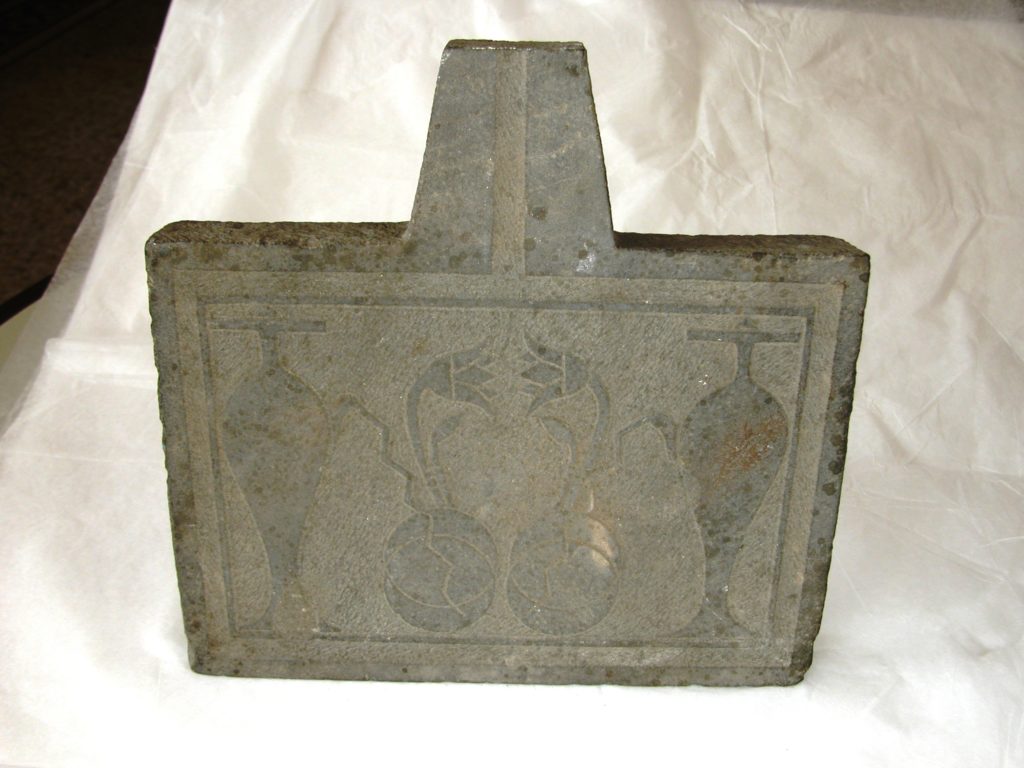

Offering Table
Small libation altar.
It shows two libation vessels pouring an offering to the gods over two seeds which are beginning to bloom.
Reference: CANCM:nn
Can be found: Ancient EgyptBottom Shelf in Explorers and Collectors Collection


Oil lamp with four burners
2nd century AD Roman, by a central Italian maker
Earthenware
By the same maker as the Odysseus lamp (both stamped CIVNBIT). The helmeted head surrounded by stars may represent Night.
Presented by Viscount Strangford to Canterbury Philosophical and Literary Institution Museum, 1844, and acquired through purchase of the museum by Canterbury Corporation, 1846-47
Reference: 993
Can be found: Viscount Strangford in Explorers and Collectors Collection
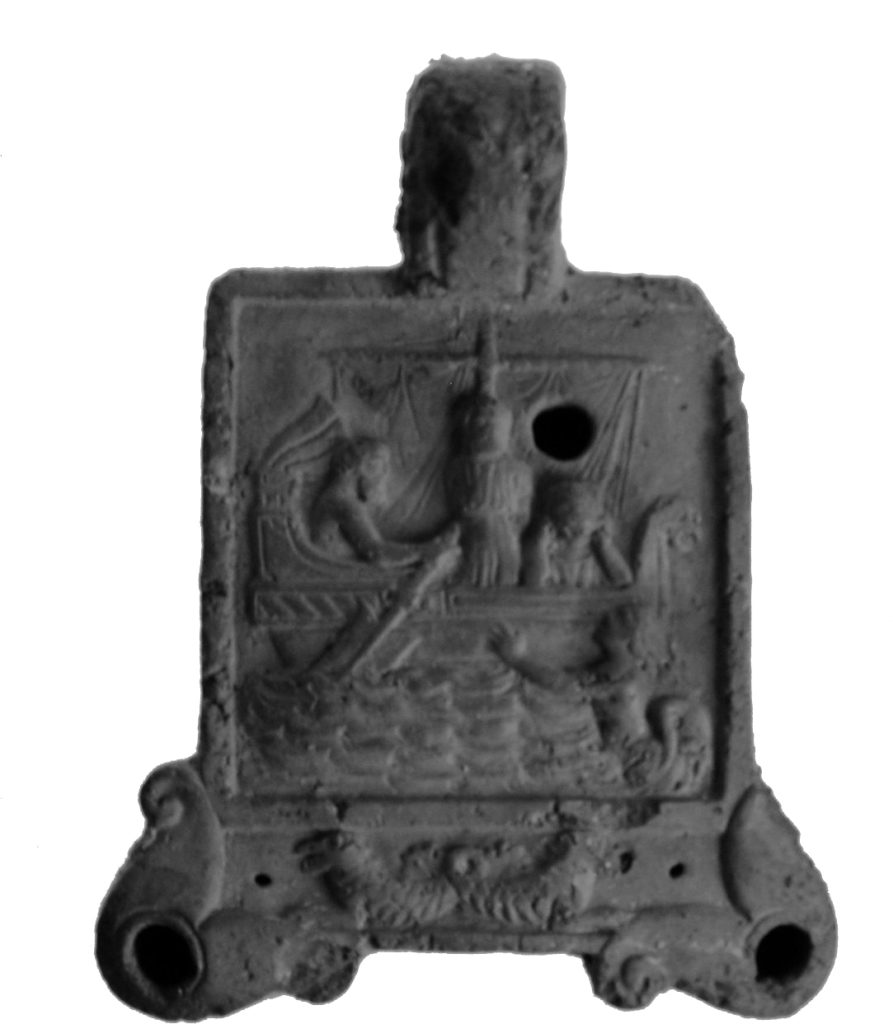

Oil lamp with image from the Odyssey Late 2nd century AD Roman, by a central Italian maker
Earthenware
An oil lamp of unusual square shape, made by Caius Innius Bitus, who stamped his initials, CIVNBIT, on the back.
The image shows a scene from the Odyssey, the Greek epic poem by Homer. Odysseus (whom Romans called Ulysses) is sailing through dangerous waters off the coast of Ithaca, where Sirens lure mariners to their deaths on the rocks. He has put wax in the ears of his crew, so they don’t hear the Sirens, and has tied himself to the ship’s mast, to prevent the Sirens’ call from making him throw himself into the sea.
Presented by Viscount Strangford to Canterbury Philosophical and Literary Institution Museum, 1844, and acquired through purchase of the museum by Canterbury Corporation, 1846-47
Reference: 994
Can be found: Viscount Strangford in Explorers and Collectors Collection

















































































































On the knoll at the Battle of Inyezane 22nd January 1879, Lloyds Guns and the Buffs in Actin
1879
Photograph of watercolour by an unknown artist
During the invasion of Zululand in 1879, the Buffs were in the right of three widely separated columns. They were attacked by Zulus but managed to beat off the attack and push on to their target, the missionary station at Eshowe. The central invasion column was wiped out at the Battle of Isandlwhana and the Buffs were besieged at Eshowe. The Zulus did not attack but surrounded the station and the Buffs were not relieved for 67 days.
Courtesy of the National Army Museum, London
Reference: 2001.04-365
Can be found: The Buffs in Explorers and Collectors Collection

















































































































Ornamental screen, taken from the Summer Palace in 1860
Brass, glass, wood, velvet
One of the items taken from the Summer Palace at Peking (Beijing) was this ornamental screen. Its use in the palace, other than as decoration, is unknown.
Donated to the National Army Museum, London, by the Trustees of the Buffs Regimental Trust, 2001
Reference: 2001.04-1033
Can be found: The Buffs in Explorers and Collectors Collection

















































































































Owl Pendant
5th – 8th Century AD
Copper Alloy
Fragment with gilt front; chip carved decoration showing a stylised owl.
Found in Barham, Kent, UK. by Mr. M. Rundle.
Reference: CANCM:1993.28
Can be found: The Anglo-Saxon Kingdom of KentTop Shelf in Explorers and Collectors Collection

















































































































Paternoster Bay, South Africa
1876
Photograph of watercolour by an unknown artist
The 2nd Battalion of the Buffs was sent to South Africa in 1876. They sailed from Dublin for Capetown in the St Lawrence. At 3am one morning the ship hit rocks in Paternoster Bay on the west coast of South Africa and began to sink. There were only four lifeboats and all the passengers, soldiers and baggage had to be rowed ashore. An officer found a horse and rode to Capetown, 100 miles away, to fetch help. Three days after the wreck he returned with rescue ships. The watercolour shows the camp of the Buffs on the beach.
Courtesy of the National Army Museum, London
Reference: 2001.04-364
Can be found: The Buffs in Explorers and Collectors Collection


Pedestal with a relief of a boy leaning against a tree
Reference: 4187
Can be found: Viscount Strangford in Explorers and Collectors Collection


Pendant
5th – 8th Century AD
Gold
Triangular gold pendant.
Found in Westbere (Anglo-Saxon cemetery) Kent, UK. Bequeathed by Osborne Dan.
Reference: CANCM:6426.3
Can be found: Middle ShelfThe Anglo-Saxon Kingdom of Kent in Explorers and Collectors Collection
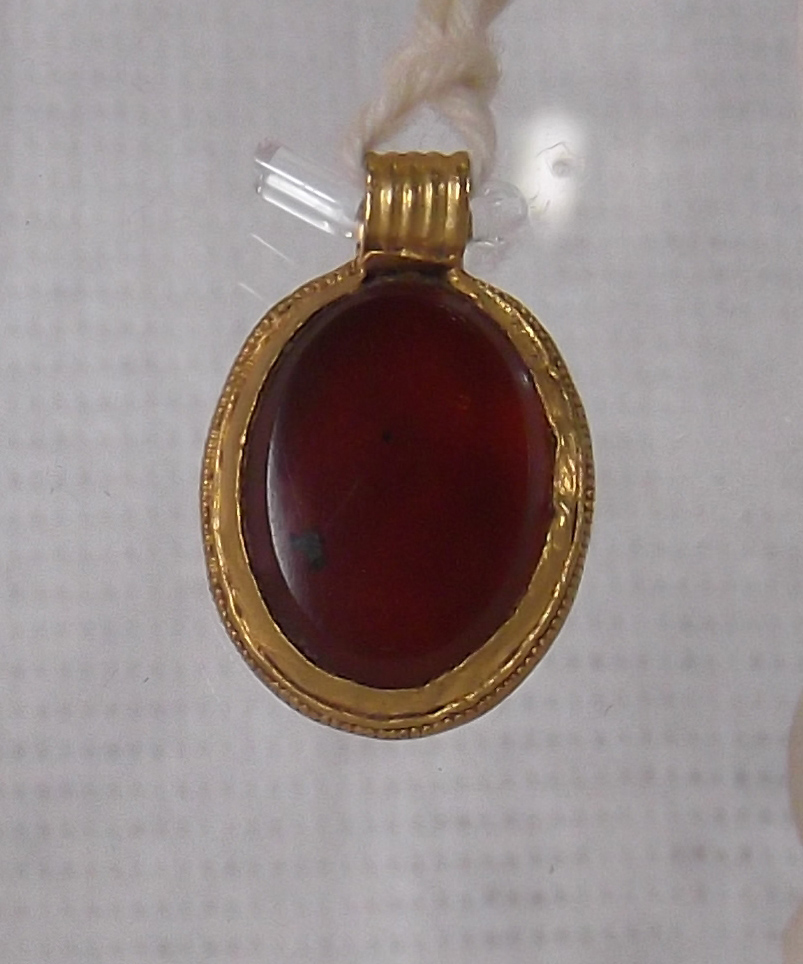

Pendant
5th – 8th Century AD
Gold
Oval gold pendant.
Found in Westbere (Anglo-Saxon cemetery) Kent, UK. Bequeathed by Osborne Dan.
Reference: CANCM:6426.2
Can be found: Middle ShelfThe Anglo-Saxon Kingdom of Kent in Explorers and Collectors Collection


Pendants
5th – 8th Century AD
Gold
Bracteate. Bracteates, thin single-sided gold medals, were worn as pendants on a string around the neck. They may have been seen as a protective amulet.
Found in Westbere (Anglo-Saxon cemetery) Kent, UK. Bequeathed by Osborne Dan.
Reference: CANCM:6426.4-6
Can be found: Middle ShelfThe Anglo-Saxon Kingdom of Kent in Explorers and Collectors Collection


Penny of King Offa
c794 AD
Silver
Coin. Minted in Canterbury for Archbishop Aethelheard during the reign of King Offa. We can date the coin to within just a few years, as Aethelheard became Archbishop in 793 and Offa died in 796.
Found by Mr D. Hunt. Purchased with the assistance of the Victoria and Albert Museum, Mr D. Hunt and Henry Moorhead and Company.
Reference: CANCM:2010.69
Can be found: The Anglo-Saxon Kingdom of KentTop Shelf in Explorers and Collectors Collection


Pewter Medallion Brooch Late Tenth Century AD
Pewter
Electroform copy of brooch. At the centre is the diademed head of King Eagar (reigned AD 959-975) the same as his portrait on coins. The inscription around the edge bears the name of the maker- Wydeman, a minter working in Shrewsbury in AD 970-980.This brooch was found in Canterbury, but the original is at the Ashmolean Museum, Oxford.
Reference: CANCM:10412
Can be found: The English and the Vikings in Explorers and Collectors Collection


Pig or other animal
Terracotta
Reference: 1007
Can be found: Viscount Strangford in Explorers and Collectors Collection


Pin
A bone pin.
Reference: E174
Can be found: Ancient EgyptMiddle Shelf in Explorers and Collectors Collection
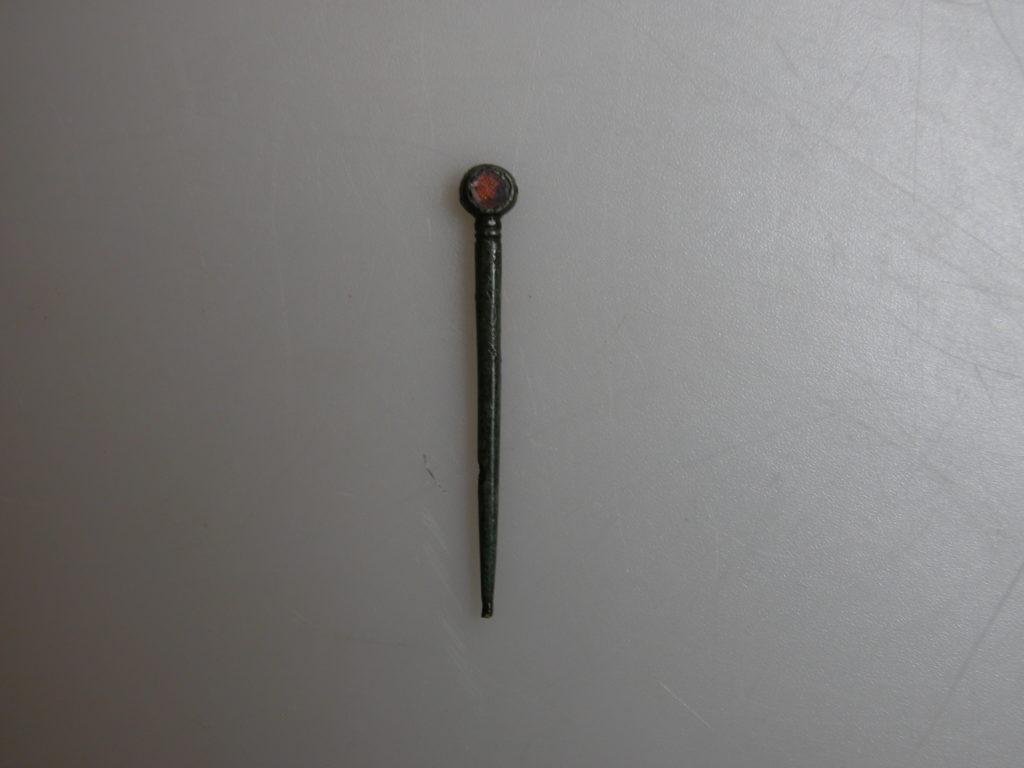

Pin
Early 7th Century AD
Copper Alloy with gold and garnet
Copper Alloy pin with a garnet set into the head. There is a piece of gold foil behind the garnet to enhance the colour of the stone.
Reference: Excavated in 1960 in Gravel Walk, Canterbury. Presented by Canterbury Archaeological Trust No accession number
Can be found: The Anglo-Saxon Kingdom of KentTop Shelf in Explorers and Collectors Collection

















































































































Pinbeaters
7th and 8th Century AD
Bone
Five worked bone double-ended pinbeaters. Pinbeaters were used while weaving to adjust the placement of threads on the loom.
Reference: CANCM:nn
Can be found: The Anglo-Saxon Kingdom of KentTop Shelf in Explorers and Collectors Collection

















































































































Pins
5th-8th Century AD
Bone
Three worked bone pins. These may have been used to hold a hair style, or perhaps to secure an item of clothing.
Reference: CANCM:nn
Can be found: The Anglo-Saxon Kingdom of KentTop Shelf in Explorers and Collectors Collection


Plaque
A bronze plaque possibly depicting the goddess Hathor.
Reference: E304
Can be found: Ancient EgyptMiddle Shelf in Explorers and Collectors Collection


Plaque
10th Century AD
Copper Alloy
Plaque with interlaced ‘Scandinavian style’ decoration. It may have been part of applique decoration on a chest or other piece of furniture.
Discovered on Mercery Lane during building works. Presented by Mr I. Collar.
Reference: CANCM:8494
Can be found: The English and the Vikings in Explorers and Collectors Collection


Pomegranate
Terracotta
Cut to show the interior
Reference: 4182
Can be found: Viscount Strangford in Explorers and Collectors Collection


Portable Sundial
Around 950 AD
Silver Gilt
Electroform copy of portable sundial. The original is in the Canterbury Cathedral Archives. Abbreviated month names are written on each side of the sundial corresponding to the hole a peg should be placed into during that month. If dangled from its chain facing the sun, it would give an approximation of the time. Around its edges, an inscription reads ‘[SA]LVS FACTORI [PA]X POSSESSOR[I]’: ‘Health to my maker, peace to my owner.’
Found in Canterbury Cathedral’s cloister garth during alterations in 1938.
Reference: CANCM:10417
Can be found: The English and the Vikings in Explorers and Collectors Collection
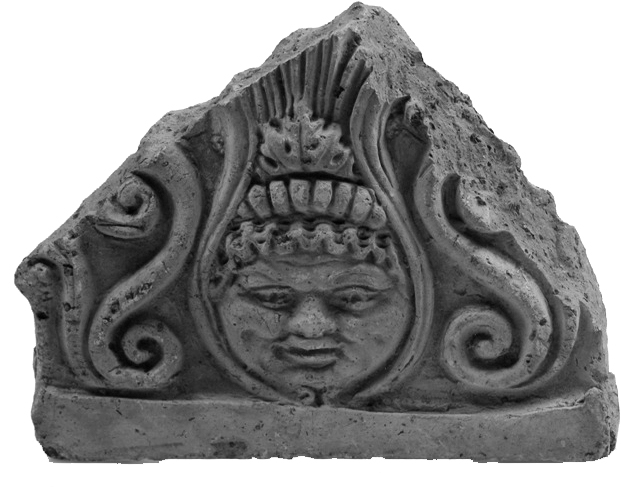

Portion of a terracotta cornice 4th to 1st century BC; found in Rhodes
Earthenware
Building decoration fragment with Grecian honeysuckle and a face.
Presented by Viscount Strangford to Canterbury Philosophical and Literary Institution Museum, 1844, and acquired through purchase of the museum by Canterbury Corporation, 1846-47
Reference: 959
Can be found: Viscount Strangford in Explorers and Collectors Collection

















































































































Private John Moyse, the 3rd (East Kent, The Buffs) Regiment of Foot, refusing to kow-tow before the Tartar Mandarin Tsan-koo-lin-sin in 1860 about 1910
Photograph of a painting by William R Scott
An Anglo French army invaded China in 1860 to enforce trade treaties on the Chinese Emperor. A landing was made at the Pei Ho river and the Taku forts, which guarded the river mouth, were captured.
John Moyse was a Private in the Buffs, having been demoted from Sergeant for insurbordination. He was captured by Tartar cavalry near the Taku forts on 12 August and after refusing to kow-tow (bow) to a Mandarin was executed. His defiant action was later immortalised by Sir Francis Hastings Doyle in his poem A Private of the Buffs.
Donated to the National Army Museum, London, by the Trustees of the Buffs Regimental Trust, 2001
Reference: 2001.04-329-1
Can be found: The Buffs in Explorers and Collectors Collection
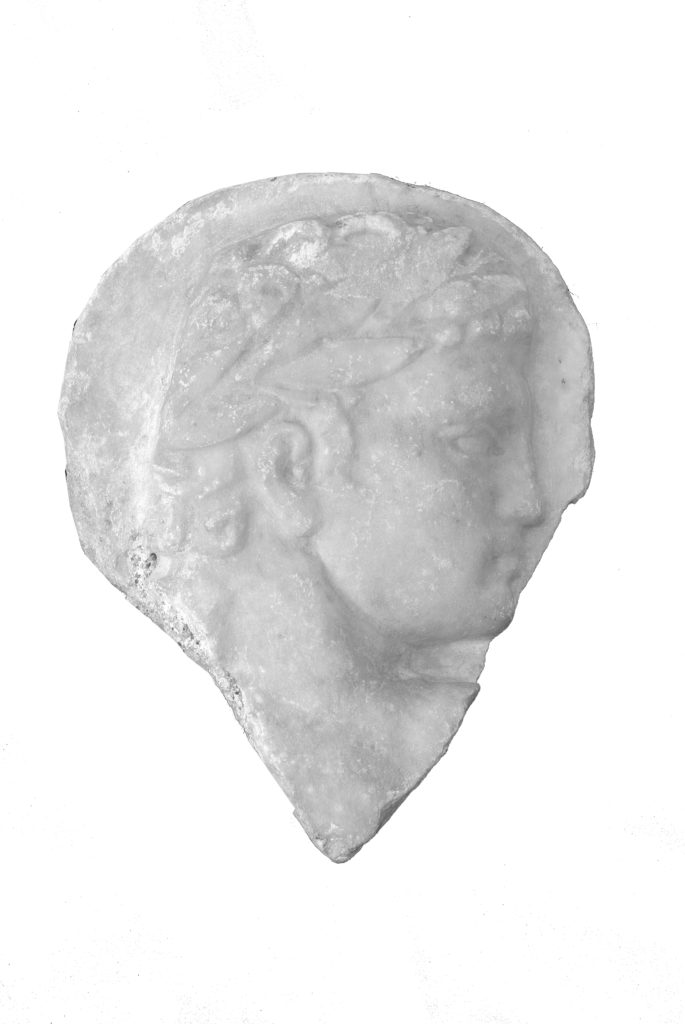

Profile head crowned with laurel Perhaps 5th to 4th century BC; found in Rhodes, 1824
Marble
Laurel leaves are symbolic of victory.
Presented by Viscount Strangford to Canterbury Philosophical and Literary Institution Museum, 1844, and acquired through purchase of the museum by Canterbury Corporation, 1846-47
Reference: 4191
Can be found: Viscount Strangford in Explorers and Collectors Collection

















































































































Pyramidal Ornaments
5th – 8th Century AD
Copper Alloy
Bequeathed by Mr. J. Brent.
Reference: CANCM:2180, 2181
Can be found: Middle ShelfThe Anglo-Saxon Kingdom of Kent in Explorers and Collectors Collection


Radiate Brooch
5th – 8th Century AD
Copper Alloy
Radiate brooch, cast bronze.
Found in Bekesbourne, Kent, UK. by Mr. P.G. Wilson.
Reference: CANCM:7530
Can be found: Middle ShelfThe Anglo-Saxon Kingdom of Kent in Explorers and Collectors Collection

















































































































Radiate Brooch
5th – 8th Century AD
Copper Alloy
Radiate brooch, cast bronze, ring and dot and chevron decoration on bow and foot.
Found in Bekesbourne, Kent, UK. by Mr. P.G. Wilson.
Reference: CANCM:7529
Can be found: Middle ShelfThe Anglo-Saxon Kingdom of Kent in Explorers and Collectors Collection

















































































































Red glazed vase with silver rim and stand
Chinese hard paste porcelain, silver
After capturing the Taku forts the army moved on to Peking (Beijing), leaving the Buffs to garrison the forts. However, one officer of the Buffs, Colonel Mark Walker, was attached to the General’s staff and went to Peking, where the Emperor’s Summer Palace was looted and destroyed. Many beautiful items were lost, or destroyed, but some were auctioned and Colonel Walker bought this vase, and possibly the Arabic box also on display. The silver rim and stand were made in Calcutta in 1860.
Donated to the National Army Museum, London, by the Trustees of the Buffs Regimental Trust, 2001
Reference: 2002-10-8
Can be found: The Buffs in Explorers and Collectors Collection


Relief of a woman
Terracotta
Reference: 4190
Can be found: Viscount Strangford in Explorers and Collectors Collection

















































































































Replica Victoria Cross and original Crimean War medals of Private John Connors
1855
Metal, cloth ribbon
During the Crimean War the Buffs took part in the siege of Sebastopol and were heavily involved in the assault on the largest of the city’s defences, the fort known as the Redan. During the attack Private John Connors rescued a wounded officer under heavy fire. He was awarded the Victoria Cross for his bravery. The men of the Buffs gave him a specially made medal in admiration of his actions, inscribed: ‘A token of admiration and esteem from his comrades to Pte J. Connors in recognition of his remarkable gallantry during the assault on the Redan Sept 8th 1855’.
Donated to the National Army Museum, London, by the Trustees of the Buffs Regimental Trust, 2001
Reference: 2001.04-210
Can be found: The Buffs in Explorers and Collectors Collection

















































































































Replica Victoria Cross awarded to Corporal (later Sergeant) James Smith, 1st Battalion, The Buffs (East Kent Regiment)
1897
Metal, ribbon
Corporal Smith won this Victoria Cross during the Mohmand Campaign, an expedition against the Northwest Frontier tribes, in September 1897. One of a group answering a call for volunteers, he followed two Royal Engineers officers to the village of Bilot, Mamund Valley, in an attempt to dislodge the enemy. In a night lit by thunderstorms, and despite being wounded, Smith continued to fight and held the position until the return of an officer who had gone for help.
Donated to the National Army Museum, London, by the Trustees of the Buffs Regimental Trust, 2001
Reference: 2001.04-432-1
Can be found: The Buffs in Explorers and Collectors Collection

















































































































Replica Victoria Cross of Major Francis Maude
1855
Metal, cloth ribbon
Major Maude was the commanding officer of the Buffs in the Crimea. He led the regiment in the attack on the Redan fort and was awarded the Victoria Cross for his bravery. The Buffs and other attackers managed to break into the fort, but were driven out under heavy fire losing 32 killed and 106 wounded from an original strength of 260 men. Despite having held the fort the Russian withdrew from Sevastapol that night. The Buffs were the only British Regiment to enter the ruined city.
Courtesy of the National Army Museum, London
Reference: 2001.04-251
Can be found: The Buffs in Explorers and Collectors Collection


Ring
A blue cartouche bearing the name ‘Amenhotep’ set in a modern ring.
Reference: E234
Can be found: Ancient EgyptMiddle Shelf in Explorers and Collectors Collection


Ring
A blue faience ring in the shape of the Wadjet Eye.
Reference: E126
Can be found: Ancient EgyptMiddle Shelf in Explorers and Collectors Collection


Rosary bag
19th century; collected in Bindrabon,
India Silk
Presented by Mary Landsdell in memory of her late husband, 1922
Reference: 2006.56.50
Can be found: Henry Lansdell in Explorers and Collectors Collection


Round tablet with inscription Terracotta
Reference: 4189
Can be found: Viscount Strangford in Explorers and Collectors Collection


Rune Stone
5th – 6th Century AD
Stone
Rune stone. One of the only two surviving pagan grave markers from the period. (The other is to the left of the case). They may have been made by invading Scandinavian warriors to commemorate comrades who fell in battle.
Found in Sandwich, Kent, UK. by Mr. W.H. Rolfe.
Reference: CANCM:1141
Can be found: Bottom ShelfThe Anglo-Saxon Kingdom of Kent in Explorers and Collectors Collection

















































































































Russian icon
Oil on wood panel
Inscribed ‘At the taking of Sebastopol, on the 9th September, 1855, this was found Enshrined on the Altar of a large Church’, this religious painting was brought back to England by J. N. Sargent, an officer of the 95th rifle regiment, who transferred to the Buffs in 1860. In Russian Othodox churches the nave is generally separated from the sanctuary by a screen wall of icons with double doors in the centre. Icons usually
Donated to the National Army Museum, London, by the Trustees of the Buffs Regimental Trust, 2001
Reference: 2001.04-328
Can be found: The Buffs in Explorers and Collectors Collection
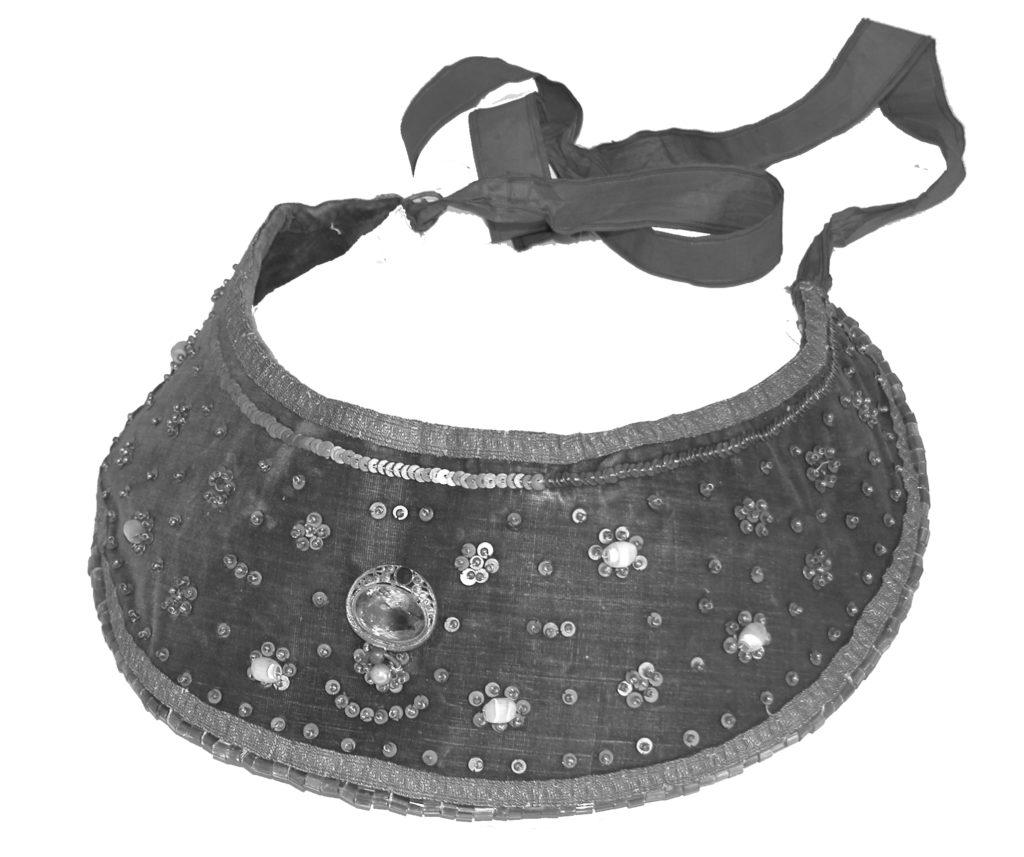

Russian ‘kokoshnik’ head-dress 19th century; collected in Russia
Textile
Given by a young Cossak schoolmistress when Lansdell ‘fell in love with it’ and asked to buy it.
Presented by Mary Landsdell in memory of her late husband, 1922, and conserved with grant-aid from the Kathy Callow Trust, 2012
Reference: 2006.56.93
Can be found: Henry Lansdell in Explorers and Collectors Collection


Sabre with ‘Yatagan’-style blade 18th century; South India
Steel with brass hilt
This curved sword was used by Nair warriors from Travancore. It has a single-edged blade re-curving towards the end known as Yatagan-style. The hilt (handle) extensions onto the blade are decorated with lotus scrolls.
Presented by Stephen Lushington to Canterbury Philosophical and Literary Institution Museum, 1825-68, and acquired through purchase of the Museum by Canterbury Corporation, 1846-47
Reference: (WG 312)
Can be found: Stephen Lushington in Explorers and Collectors Collection

















































































































Saucer Brooch
6th Century AD
Copper Alloy
Rare gilded bronze saucer brooch of West Saxon type, one of a pair.
Found in Faversham, Kent by Mr. J. Brent.
Reference: CANCM:2166
Can be found: Middle ShelfThe Anglo-Saxon Kingdom of Kent in Explorers and Collectors Collection


Scarab
An un-inscribed faience scarab with a hole for cord.
Reference: E189
Can be found: Ancient EgyptCollection of scarabsMiddle Shelf in Explorers and Collectors Collection


Scarab
A steatite stone scarab.
The scarab beetle was often carved on top of stamp seals. The underside could include names, titles, or other important information that the owner could stamp on clay or papyrus.
Reference: E233
Can be found: Ancient EgyptCollection of scarabsMiddle Shelf in Explorers and Collectors Collection


Scarab
A faience scarab with a hole for cord.
Reference: E230
Can be found: Ancient EgyptCollection of scarabsMiddle Shelf in Explorers and Collectors Collection

















































































































Scarab
A faience scarab with a hole for cord.
Reference: E247
Can be found: Ancient EgyptCollection of scarabsMiddle Shelf in Explorers and Collectors Collection


Scarab
Scarab.
Reference: E225
Can be found: Ancient EgyptCollection of scarabsMiddle Shelf in Explorers and Collectors Collection
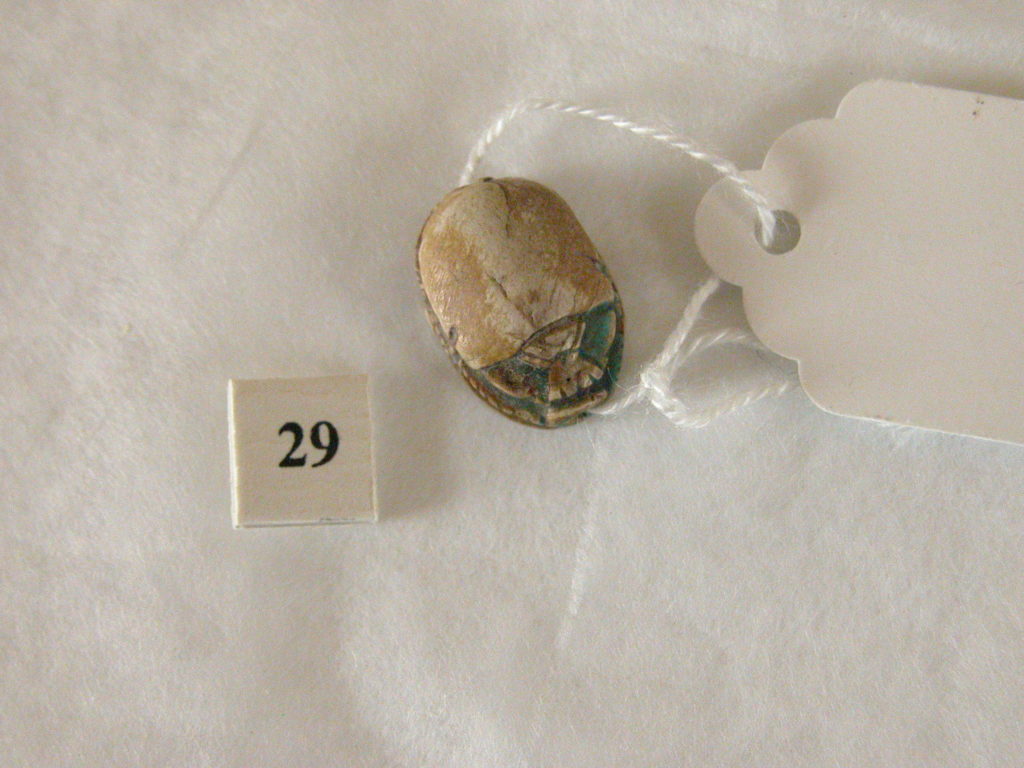

Scarab
Scarab.
Reference: E259
Can be found: Ancient EgyptCollection of scarabsMiddle Shelf in Explorers and Collectors Collection


Scarab
Faience scarab in the shape of Amun Re Cartouche.
Reference: E245
Can be found: Ancient EgyptCollection of scarabsMiddle Shelf in Explorers and Collectors Collection


Scarab
Stone scarab in the shape of a jackal base. Hole for cord.
Reference: E110
Can be found: Ancient EgyptCollection of scarabsMiddle Shelf in Explorers and Collectors Collection


Scarab
Stone with some turquoise patches scarab in the shape of a jackal base. Hole for cord.
Reference: E111
Can be found: Ancient EgyptCollection of scarabsMiddle Shelf in Explorers and Collectors Collection


Scarab
Soapstone scarab with two cobras on cartouche. Hole for cord.
Reference: E114
Can be found: Ancient EgyptCollection of scarabsMiddle Shelf in Explorers and Collectors Collection
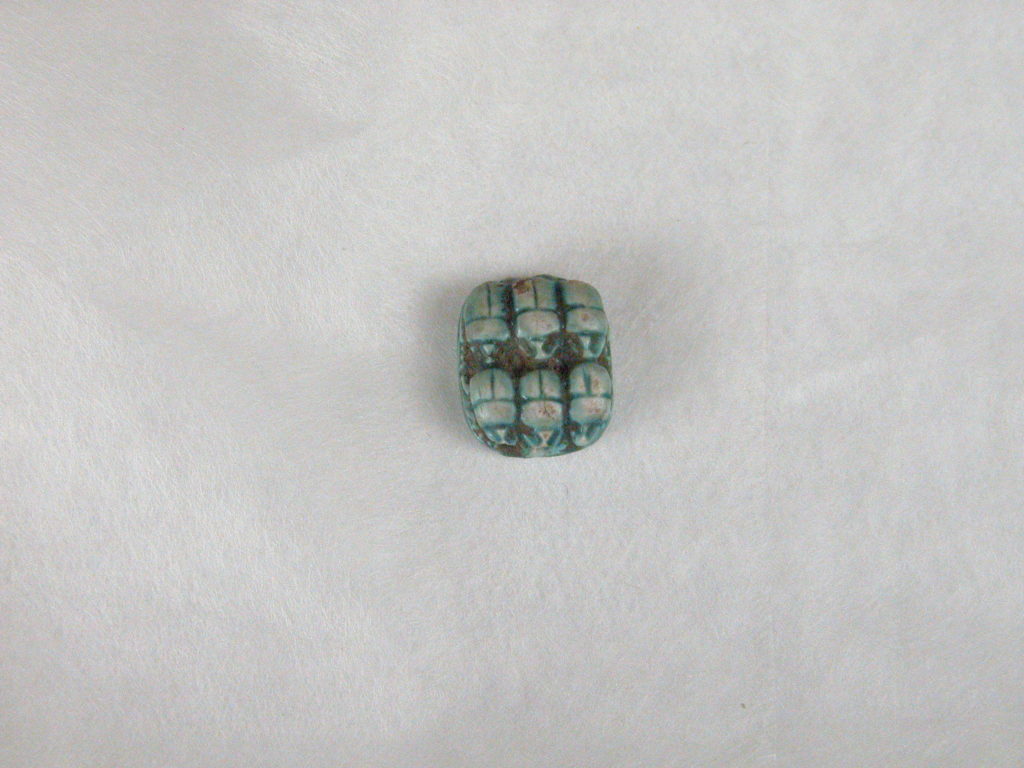

Scarab
Faience scarab. Hole for cord.
Reference: E265
Can be found: Ancient EgyptCollection of scarabsMiddle Shelf in Explorers and Collectors Collection


Scarab
Soapstone scarab with cartouche of god and goddess. Hole for cord.
Reference: E269
Can be found: Ancient EgyptCollection of scarabsMiddle Shelf in Explorers and Collectors Collection


Scarab
Soapstone scarab - possibly fake. Hole for cord.
Reference: E274
Can be found: Ancient EgyptCollection of scarabsMiddle Shelf in Explorers and Collectors Collection

















































































































Scarab
Faience scarab. Hole for cord.
Reference: E263
Can be found: Ancient EgyptCollection of scarabsMiddle Shelf in Explorers and Collectors Collection


Scarab
Blue scarab bead.
Reference: E108
Can be found: Ancient EgyptCollection of scarabsMiddle Shelf in Explorers and Collectors Collection


Scarab
Green glazed scarab bead.
Reference: E147
Can be found: Ancient EgyptCollection of scarabsMiddle Shelf in Explorers and Collectors Collection


Scarab
Blue scarab bead.
Reference: E148
Can be found: Ancient EgyptCollection of scarabsMiddle Shelf in Explorers and Collectors Collection
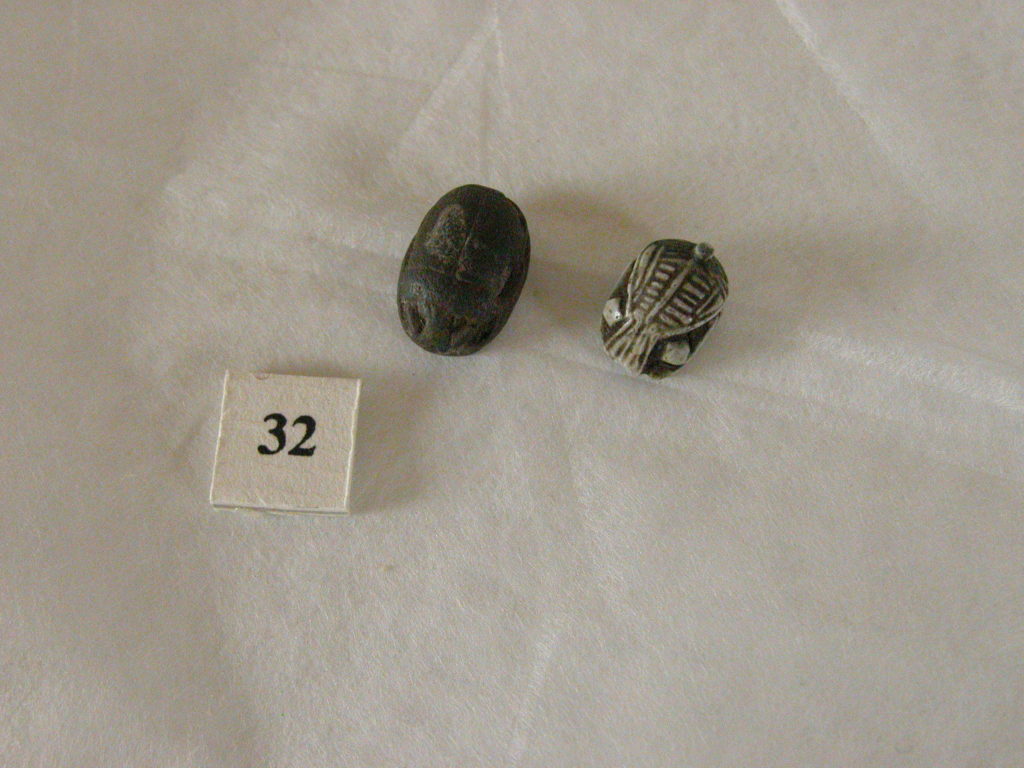

Scarab
Two scarab beads in the shape of Tutmosis III and Dyn. Stone and bone.
Reference: E221
Can be found: Ancient EgyptCollection of scarabsMiddle Shelf in Explorers and Collectors Collection


Scarab
Green scarab bead.
Reference: E226
Can be found: Ancient EgyptCollection of scarabsMiddle Shelf in Explorers and Collectors Collection


Scarab
Green double scarab bead.
Reference: E251
Can be found: Ancient EgyptCollection of scarabsMiddle Shelf in Explorers and Collectors Collection


Scarab
Blue scarab bead.
Reference: E252
Can be found: Ancient EgyptCollection of scarabsMiddle Shelf in Explorers and Collectors Collection
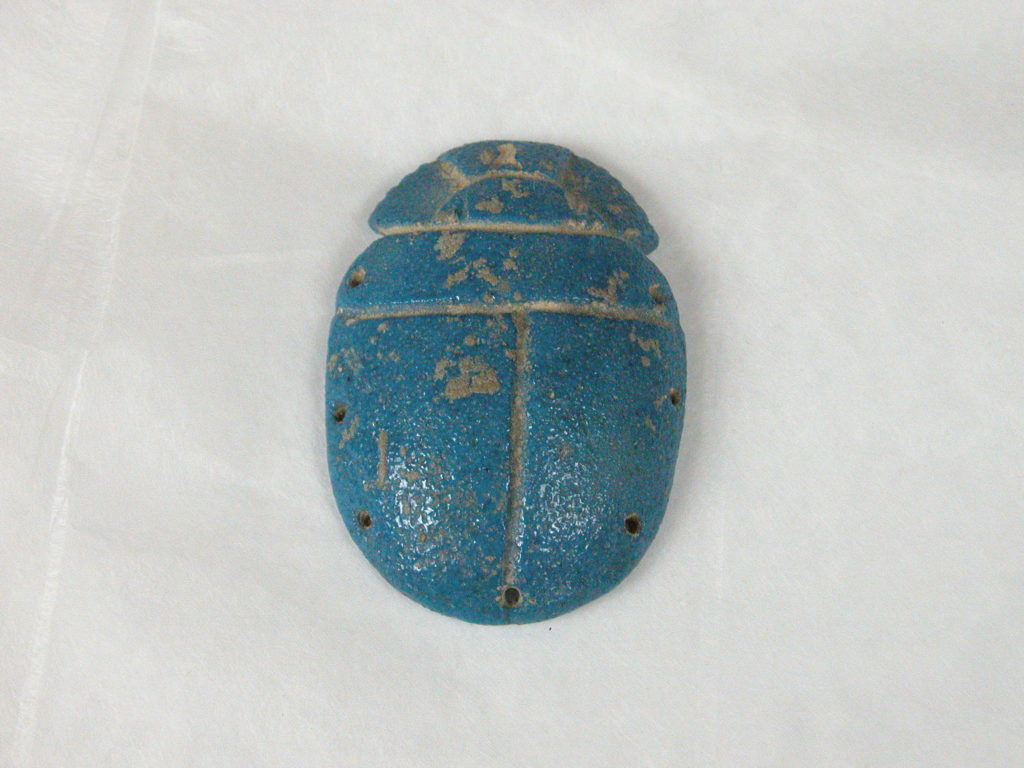

Scarab
Faience scarab with missing wings; would have been sewn on mummy netting.
Reference: E313
Can be found: Ancient EgyptCollection of scarabsMiddle Shelf in Explorers and Collectors Collection


Scarab
Dark green scarab bead.
Reference: E100
Can be found: Ancient EgyptCollection of scarabsMiddle Shelf in Explorers and Collectors Collection
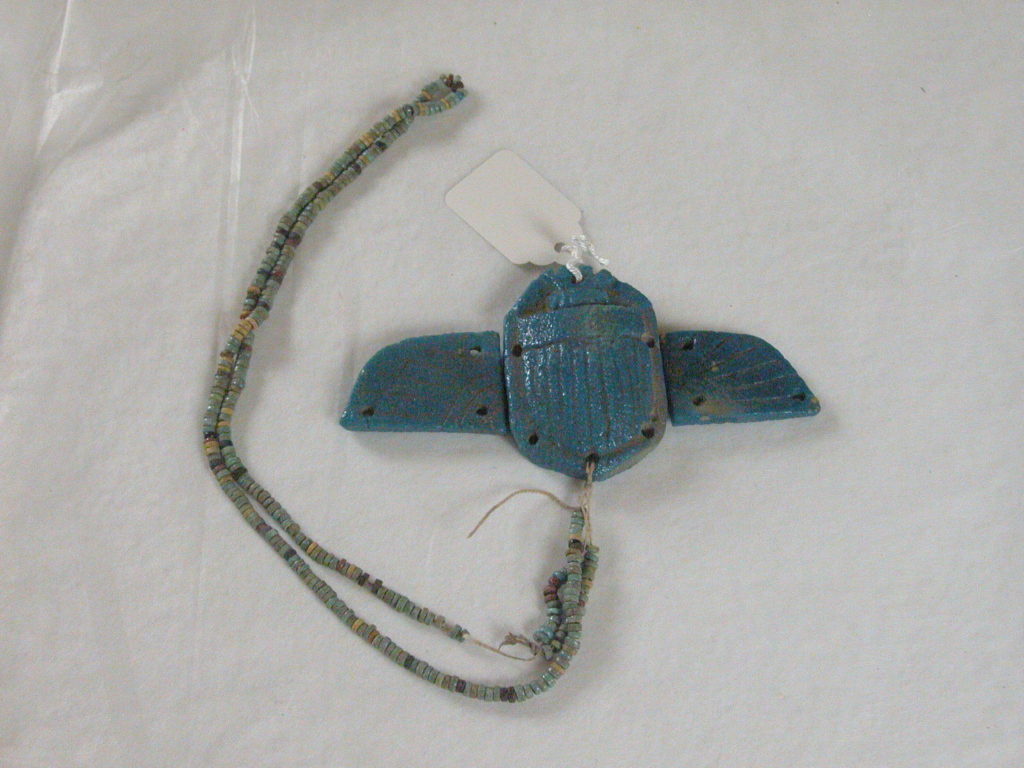

Scarab
Flat blue faience scarab and wings and string of plain green beads.
Reference: E315
Can be found: Ancient EgyptBottom ShelfCollection of scarabs in Explorers and Collectors Collection


Scarab
Semi precious stone: amethyst - either a fake or middle intermediate period. Hole for cord.
Reference: E98
Can be found: Ancient EgyptBottom ShelfCollection of scarabs in Explorers and Collectors Collection


Scaraboid
Faience scaraboid with a hole for cord.
Reference: E239
Can be found: Ancient EgyptMiddle Shelf in Explorers and Collectors Collection

















































































































Scaraboid
A soapstone scaraboid in the shape of ankh car.
Reference: E241
Can be found: Ancient EgyptMiddle Shelf in Explorers and Collectors Collection

















































































































Scaraboid
Bone scaraboid with a hole for cord.
Reference: E106
Can be found: Ancient EgyptMiddle Shelf in Explorers and Collectors Collection


Scaraboid
Faience scaraboid with inscription ‘the good god Tutmosis’ on base. Hole for cord.
Reference: E115
Can be found: Ancient EgyptMiddle Shelf in Explorers and Collectors Collection


Scaraboid
Stone scaraboid with a hawk and cobra cartouche. Hole for cord.
Reference: E136
Can be found: Ancient EgyptMiddle Shelf in Explorers and Collectors Collection


Scaraboid
Stone scaraboid in the shape of fish with Amun Re on base. Hole for cord.
Reference: E141
Can be found: Ancient EgyptBottom Shelf in Explorers and Collectors Collection


Sceat
5th – 8th Century AD
Silver
Coin. Probably known as ‘pennies’ when they were in use, these coins were minted in Kent, Frisia and Jutland. The earliest sceatta in Britain were minted in Kent and the Thames estuary.
Found in Elham; Henbury Manor, Kent, UK. by Mr. G.T. Hall.
Reference: CANCM:1993.44.1
Can be found: The Anglo-Saxon Kingdom of KentTop Shelf in Explorers and Collectors Collection


Sceat
5th – 8th Century AD
Silver
Coin. Probably known as ‘pennies’ when they were in use, these coins were minted in Kent, Frisia and Jutland. The earliest sceatta in Britain were minted in Kent and the Thames estuary.
Found in Elham; Henbury Manor, Kent, UK. by Mr. G.T. Hall.
Reference: CANCM:1993.44.2
Can be found: The Anglo-Saxon Kingdom of KentTop Shelf in Explorers and Collectors Collection


Sculptural fragment with hands holding a disc
Perhaps 5th to 4th century BC; source unknown
Marble
Finely carved and probably from a discus-thrower sculpture.
Presented by Viscount Strangford to Canterbury Philosophical and Literary Institution Museum, 1844, and acquired through purchase of the museum by Canterbury Corporation, 1846-47
Reference: 4264
Can be found: Viscount Strangford in Explorers and Collectors Collection


Seal Ring
Bronze ring with cartouche bearing a hieroglyphic inscription.
Reference: 2052
Can be found: Ancient EgyptMiddle Shelf in Explorers and Collectors Collection


Seated Bacchus
Naxos, 1822
Terracotta
Reference: 4186
Can be found: Viscount Strangford in Explorers and Collectors Collection


Seated bull ornament
19th century; collected in Khotan, China, 1888
Jade
Presented by Mary Landsdell in memory of her late husband, 1922
Reference: 2006.56.29
Can be found: Henry Lansdell in Explorers and Collectors Collection


Seated figure
Terracotta
Reference: 4181
Can be found: Viscount Strangford in Explorers and Collectors Collection


Seated figure Terracotta
Reference: 4174
Can be found: Viscount Strangford in Explorers and Collectors Collection


Seated figure with headdress Terracotta
Reference: 960
Can be found: Viscount Strangford in Explorers and Collectors Collection


Seated male Terracotta
Reference: 4199
Can be found: Viscount Strangford in Explorers and Collectors Collection



Shabti
Blue faience Shabti.
Reference: E293
Can be found: Ancient EgyptBottom Shelf in Explorers and Collectors Collection



Shabti
Blue faience Shabti.
Reference: E293
Can be found: Ancient EgyptBottom Shelf in Explorers and Collectors Collection

















































































































Shabti
Shabti.
Reference: E291
Can be found: Ancient EgyptBottom Shelf in Explorers and Collectors Collection

















































































































Shabti
Blue faience uShabti.
Reference: E248
Can be found: Ancient EgyptBottom Shelf in Explorers and Collectors Collection


Shabti Figure
Dark green glazed Shabtin figure/faience worker Shabti.
Reference: CANCM: 2038
Can be found: Ancient EgyptBottom Shelf in Explorers and Collectors Collection


Shabti Figure
Faience Shabti.
Reference: CANCM: 2028
Can be found: Ancient EgyptBottom Shelf in Explorers and Collectors Collection

















































































































Shabti Figure
Dark green faience Shabti
Reference: CANCM:nn
Can be found: Ancient EgyptBottom Shelf in Explorers and Collectors Collection

















































































































Shabti figurine
Shabtis were included in Egyptian burials to work for the tomb owner in the afterlife. They were believed by the Ancient Egyptians to spring to life and do all the hard work for the dead in their heaven, the Kingdom of Osiris. This particular Shabti has been finished with green faience.
Reference: CANCM:4204 / E27
Can be found: Ancient EgyptBottom Shelf in Explorers and Collectors Collection
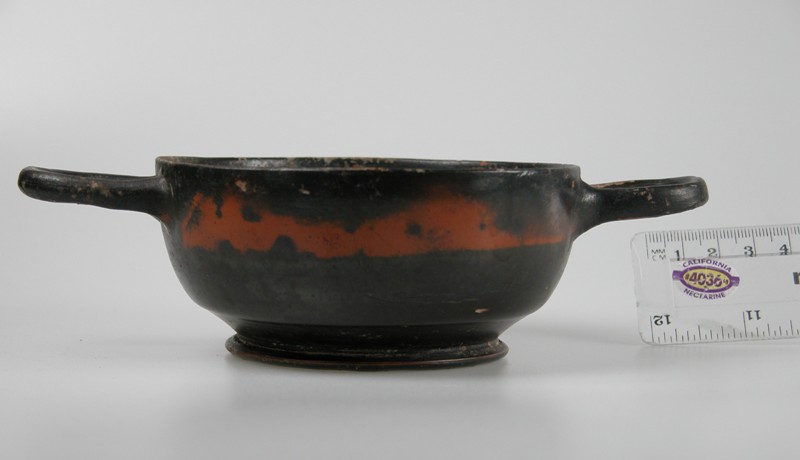

Shallow black and red bowl
Reference: 4157
Can be found: Viscount Strangford in Explorers and Collectors Collection
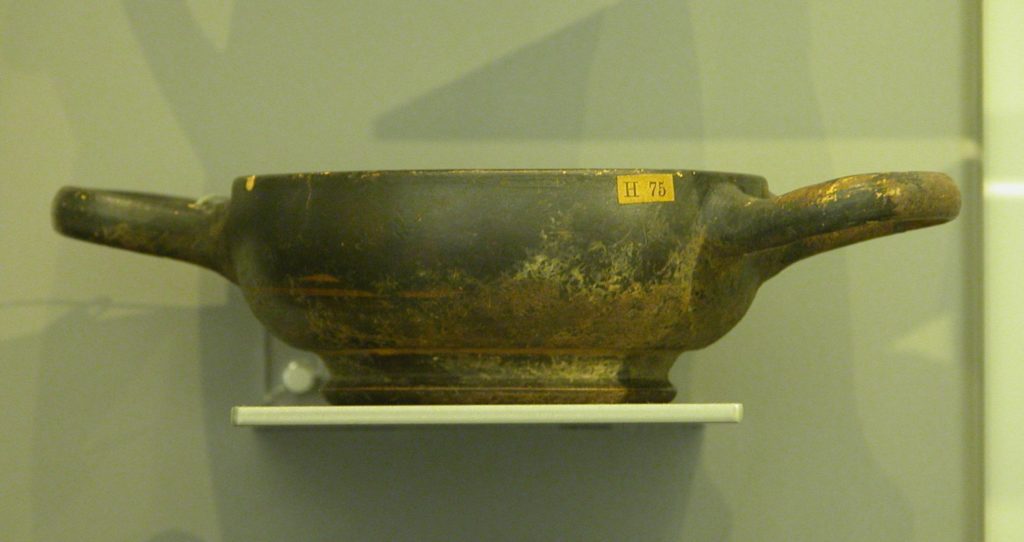

Shallow black bowl
Pattern inside of circular radiations including the branches of a palm or yew.
Reference: 4161
Can be found: Viscount Strangford in Explorers and Collectors Collection
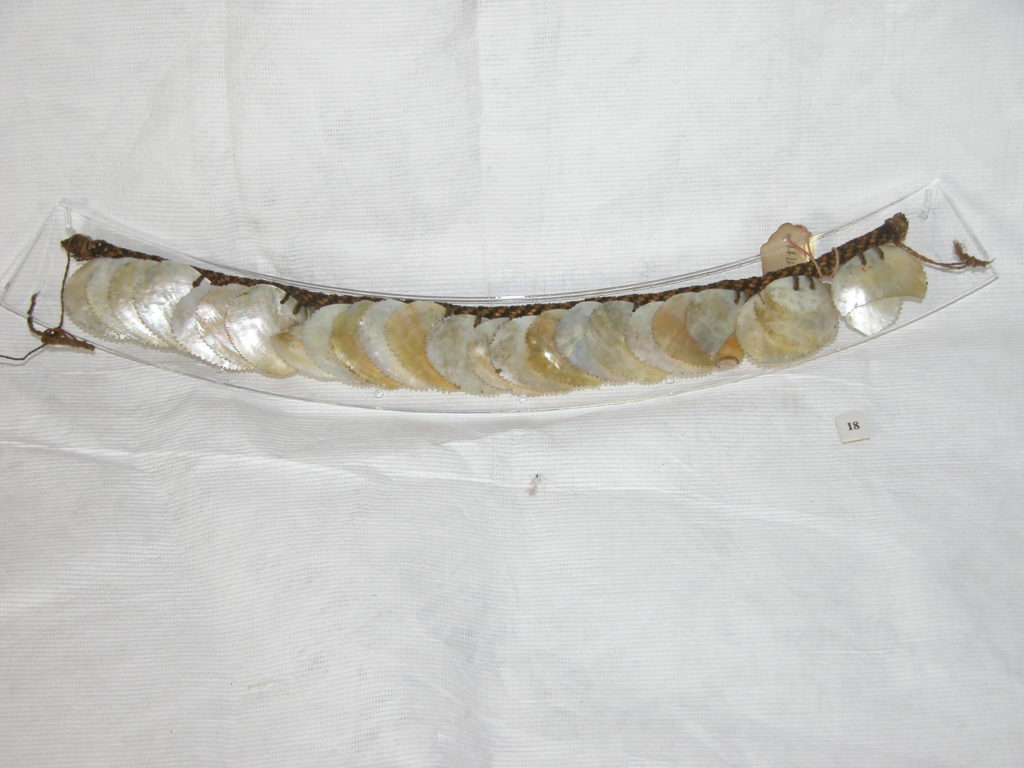

Shell necklace
18th to 19th century; Tahiti, South Seas
Shells and fibres
Pearl shells for the necklace have been carefully serrated round the edges and bound with pandanus (aromatic plant) leaves, hibiscus string and dyed black fibres.
Reference: 4451
Can be found: Heroes and VillainsTravellers to the Pacific, Australasia and America in Explorers and Collectors Collection

















































































































Shield Boss
5th – 8th Century AD
Iron
Iron shield boss. Found 9” from the grave floor and 15” from the head of the grave, suggesting that the width of shield was not more than 30”.
Found in Bekesbourne, Kent, UK. by Mr. P.G. Wilson.
Reference: CANCM:7586
Can be found: Middle ShelfThe Anglo-Saxon Kingdom of Kent in Explorers and Collectors Collection


Shield from Borneo
19th to 20th century; Borneo
Wood and cane
A shield carved with an integral handle on the reverse from the same piece of wood. Split cane has been added during construction for strength.
Presented by Lady Mitchell, 1907
Reference: 4843
Can be found: Heroes and VillainsTravellers to the East in Explorers and Collectors Collection


Short ‘Firangi’ sword
18th century; South India
Steel
Firangi means ‘foreigner’ and this type of sword originally incorporated European blades, or ones made locally in European style. It has a typical South Indian disc-shaped pommel (handle end).
Presented by Stephen Lushington to Canterbury Philosophical and Literary Institution Museum, 1825-68, and acquired through purchase of the Museum by Canterbury Corporation, 1846-47
Reference: (10)
Can be found: Stephen Lushington in Explorers and Collectors Collection


Signed 3rd edition of “Through Siberia” by Henry Lansdell
Lansdell signed this book to Mrs James Hill on 24th July 1885. He was staying in Riga, Latvia at the time probably in preparation for another journey, this time through Russian Central Asia.
The donor bought the book in 2000 in a second hand bookshop in Riga.
Donated by Mr J. Camp 2017
Reference: Cancm:2017.16
Can be found: Henry Lansdell in Explorers and Collectors Collection


Sikkin dorje or Thunderbolt
19th century; collected in Darjeeling, India
Metal
Ritual object representing firmness of spirit – combining diamond (which cuts anything but can’t itself be cut) and thunderbolt (irresistible force).
Presented by Mary Landsdell in memory of her late husband, 1922
Reference: 2006.56.56
Can be found: Henry Lansdell in Explorers and Collectors Collection



Silver Penny
Mid-Eleventh Century AD
Silver
Silver Penny of Edward the Confessor (1042-1066 AD). Edward was the last king of the House of Wessex, and the son of Æthelred the Unready. Traditionally thought to be unworldly and pious, Edward died without an heir. He promised William of Normandy the throne before his death, but then seemed to offer it to Harold Godwinson on his deathbed, asking him to protect Edward’s wife. This uncertainty and indecision caused the Norman conquest of England.
Reference: CANCM:nn
Can be found: The English and the Vikings in Explorers and Collectors Collection


Silver Penny
Late Ninth Century AD
Silver
Penny depicting King Alfred the Great. The fifth son of the King Aelthelwulf, Alfred ruled from 871-899AD – the royal succession passed along the line of brothers rather than risk falling to a child in the face of Viking aggression. Alfred successfully fended off the Vikings from his kingdom and at the time of his death was known as King of the English.
Reference: CANCM:nn
Can be found: The English and the Vikings in Explorers and Collectors Collection
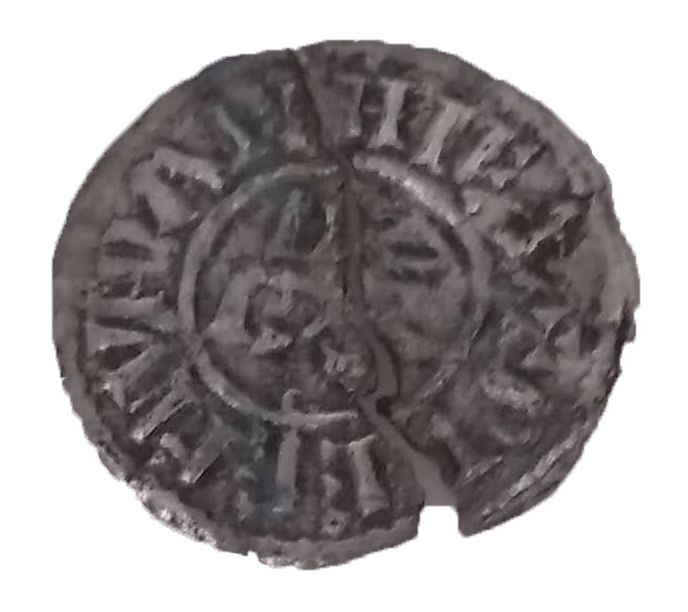

Silver penny
Late Ninth to Early Tenth Century AD
Silver
Penny depicting Archbishop Plegmund. Plegmund was from Mercia, and possibly lived as a hermit in a Cheshire marsh until he was summoned by King Alfred first to his court and then to become the Archbishop of Canterbury. This coin was minted in Canterbury, where the Archbishop had the right to mint his own coins.
Reference: CANCM:8529
Can be found: The English and the Vikings in Explorers and Collectors Collection



Silver Penny
Late Tenth - Early Eleventh Century AD
Silver
Coin depicting Æthelred II, also known as ‘Æthelred the Unready’. Æthelred was king twice. He came to the throne first at the age of ten in 978 and ruled until 1013, at which point a Viking invasion led him to flee to France. The Vikings retreated the next year, and Æthelred returned to the throne from 1014 to 1016. His title ‘Unready’ comes from an old English word which means ‘badly advised’. The moneyer Leofstan made this coin.
Reference: CANCM:nn
Can be found: The English and the Vikings in Explorers and Collectors Collection


Silver Penny
Early Eleventh Century AD
Silver
Silver Penny of Cnut, who ruled in England from 1016- 1035AD. Cnut was born in modern Denmark and was at by the end of his life, in his own words, “King of all England and Denmark and the Norwegians and of some of the Swedes”. After conquering England after a bloody 14 month campaign from 1015-1016, his reign restored the prosperity England had largely lost due to the threat of Viking raiders. The moneyer Wulstan made this coin.
Reference: CANCM:nn
Can be found: The English and the Vikings in Explorers and Collectors Collection

















































































































Silver Ring
5th – 8th Century AD
Silver
Portion of silver twisted ring.
Found by Mr J. Brent.
Reference: CANCM:2229
Can be found: Bottom ShelfThe Anglo-Saxon Kingdom of Kent in Explorers and Collectors Collection

















































































































Silver Spoon
5th – 8th Century AD
Silver Gilt
Silver gilt spoon with swastika in niello on junction of bowl and handle. Found between knees of skeleton.
Found in Bekesbourne, Kent, UK. by Mr. P.G. Wilson.
Reference: CANCM:7519
Can be found: Middle ShelfThe Anglo-Saxon Kingdom of Kent in Explorers and Collectors Collection


Small black vase
Reference: 4091
Can be found: Viscount Strangford in Explorers and Collectors Collection


Small red and black globular vase
Reference: 4168
Can be found: Viscount Strangford in Explorers and Collectors Collection


Small urn with arabesque patterns
Reference: 4163
Can be found: Viscount Strangford in Explorers and Collectors Collection


Small vase
1st to 4th century Greek
Earthenware
With heads and birds on the bowl, and the faces of a man and woman across a swan.
Reference: 4162
Can be found: Viscount Strangford in Explorers and Collectors Collection


Small vase
Foliated pattern in red and black
Reference: 4107
Can be found: Viscount Strangford in Explorers and Collectors Collection


Small vase
Gladiator holding a shield
Reference: 4103
Can be found: Viscount Strangford in Explorers and Collectors Collection


Small vase
Reference: 4170
Can be found: Viscount Strangford in Explorers and Collectors Collection


Small vase with honeysuckle design
Reference: 4122
Can be found: Viscount Strangford in Explorers and Collectors Collection
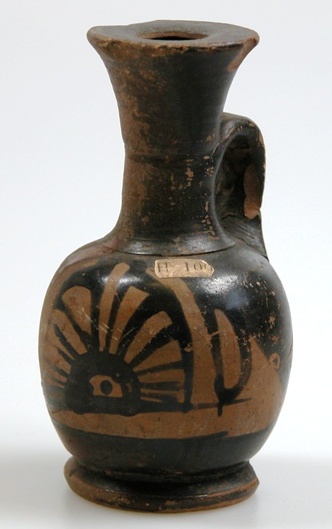

Small vase with honeysuckle design
Reference: 4166
Can be found: Viscount Strangford in Explorers and Collectors Collection


Small vase with horizontal grooves
Reference: 4169
Can be found: Viscount Strangford in Explorers and Collectors Collection

















































































































Small vessels
4th to 2nd century BC Greek and 1st to 2nd century AD Roman
Earthenware
Small flasks and jugs used for toilet oil, perfume and condiments. The colours were achieved by covering parts of the clay pots with slip (diluted clay solution). The iron oxide naturally present in the clay turned from red to black, or back to red, depending on fi ring conditions. Further pigments could be added to the slip.
Presented by Viscount Strangford to Canterbury Philosophical and Literary Institution Museum, 1844, and acquired through purchase of the museum by Canterbury Corporation, 1846-47
Reference: CANCM:nn
Can be found: Viscount Strangford in Explorers and Collectors Collection
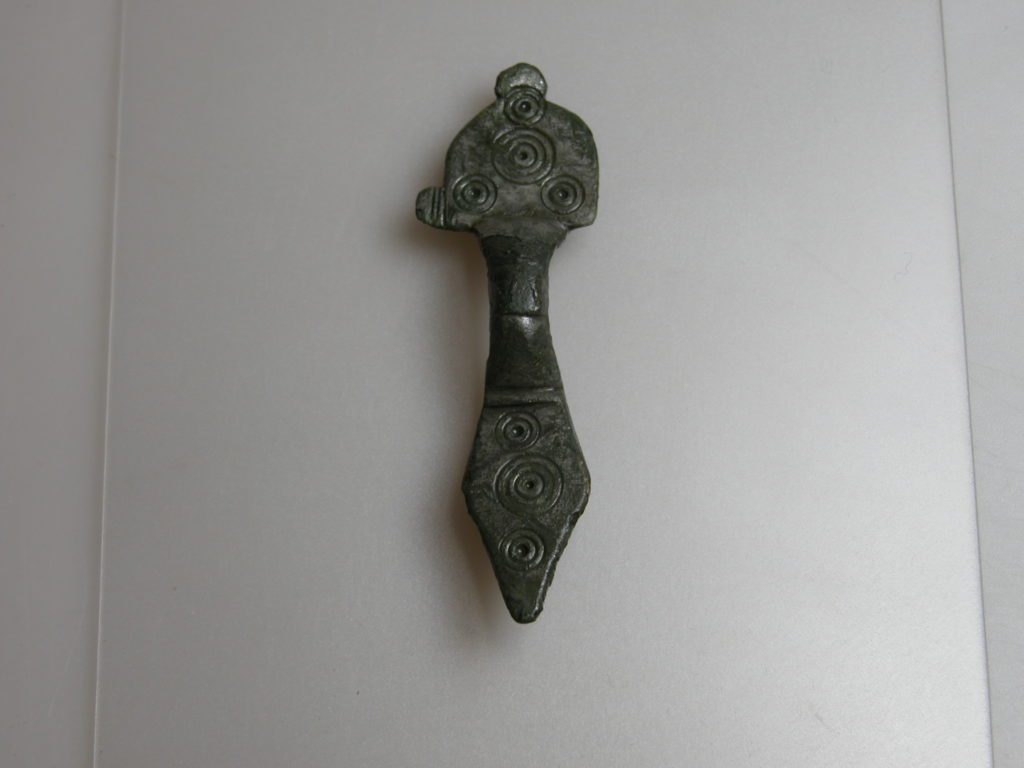

Small-Long Type Brooch
5th-6th Century AD
Copper Alloy
Copper alloy brooch with cup and dot decoration at head and foot. This type of brooch was generally worn in a pair.
Reference: CANCM:nn
Can be found: Bottom ShelfThe Anglo-Saxon Kingdom of Kent in Explorers and Collectors Collection


Small-Long Type Brooch
5th-6th Century AD
Copper Alloy
Copper alloy brooch. This type of brooch was generally worn in a pair.
Reference: CANCM:nn
Can be found: Bottom ShelfThe Anglo-Saxon Kingdom of Kent in Explorers and Collectors Collection


Snowshoe
Early to mid-19th century; Central North Canada
Wood, animal gut, cloth
One of a pair of snowshoes used by animal trappers and made from local materials except for the cloth, which probably came from Stroud in Gloucestershire, which had trading links with Canadian trappers.
Reference: 4513
Can be found: Heroes and VillainsTravellers to the Pacific, Australasia and America in Explorers and Collectors Collection


South Indian birds
1830; Neelgherry Mountains, South India
At first glance these look like British birds: partridges, cuckoo, woodpecker, pigeon and dove, all familiar in our cities and countryside. But the birds come from southern India.
The Canterbury Philosophical and Literary Institution reported in 1830 the gift from ‘Stephen Lushington of many birds from a mountainous region in Madras at an elevation of between eight and nine thousand feet from the level of the Sea’. Many were very similar to birds found in Britain and showed that high altitude in a warm southern climate provides similar conditions to lower altitude in a cooler northern climate. Among the birds were the sparrow hawk, henharrier, hoopoe and woodcock.
The cases of birds in the museum of Canterbury Philosophical and Literary Institution were ‘so peculiarly attractive to visitors’, according to the Institution’s annual report, that ‘the Curators … felt themselves bound to increase the Collection of Birds by every means in their power.’
In this original case are seven woodpeckers, two Indian ring necked parakeets, a plum-headed and a Malabar parakeet, two nightjars (birds that hunt at night, with pointed wings and long tails), a needle-tailed swift (the fastest bird in flapping flight), a hoopoe (with distinctive crown of feathers), three partridges, five cuckoos, four different plovers, various quail, a necklace dove and Indian green-winged dove, a black-winged stilt (long-legged wader), two pigeons, and various other birds.
Presented by Stephen Lushington to Canterbury Philosophical and Literary Institution Museum, 1830, and acquired through purchase of the Museum by Canterbury Corporation, 1846-47
Reference: 1999.173
Can be found: Stephen Lushington in Explorers and Collectors Collection


South Indian birds
1830; South India
The Canterbury Philosophical and Literary Institution reported in 1830 the ‘valuable presentations made by His Excellency the present Governor of Madras,’ Stephen Lushington, ‘which comprise specimens of several of the noble Mammalia of that Country, as the Bengal Tiger…, Leopard…, Panther…, Ounce…, Elk… &c, &c.; also a magnificent Skull of a large domesticated Elephant with tusks; as well as upwards of 150 species of the feathered race, some of which as the Vulture, Hornbill, Roller, Barbet, Nuthatch, and Ibis, have enabled the Curators to fill up Genera which were before wholly wanting in the [museum] cases.’
The largest of the birds in this original ‘Phil and Lit’ museum case is the giant hornbill. It can eat seeds as large as avocado stones but is omnivorous, like the three other hornbills, eating small animals as well as fruit.
The rest of the birds in this case are waders or shallow-water feeders, living where there is plentiful food along shorelines or on lakes. The ibis, to the right of the giant hornbill, is a wader with a long down-curved bill, which it prods in the mud to find shellfish. In ancient Egypt the African ibis was sacred and associated with the moon god Thoth. It can be found on several artefacts in the Ancient Egypt showcase to the right of this case.
Presented by Stephen Lushington to Canterbury Philosophical and Literary Institution Museum, 1830, and acquired through purchase of the Museum by Canterbury Corporation, 1846-47
Reference: 1999. 172
Can be found: Stephen Lushington in Explorers and Collectors Collection


South Seas clubs
Late 18th to mid 19th century; New Zealand and Fiji
Stone, Root ball
A Maori stone club and a throwing club from Fiji, both of them for use, not decoration.
Reference: 4473, 4490
Can be found: Heroes and VillainsTravellers to the Pacific, Australasia and America in Explorers and Collectors Collection


South Seas fishhooks and cloak pins
19th century; New Zealand, Tahiti and Hawaii
Bone, shell and twine
People living in the South Seas have created a large range of different fishhooks, each suited to catching a particular type of fish.
Reference: 4462, 4463k
Can be found: Heroes and VillainsTravellers to the Pacific, Australasia and America in Explorers and Collectors Collection


South Seas paddles and scoop
19th century; Ra’ivavae, Austral Islands
Wood
These paddles and scoop date from about 1815 to 1840. They are for decoration rather than practical use and were originally made for local trade. As the South Seas opened up to visitors from the west, the decorative paddles became much sought-after collectors’ items among Europeans.
They were made on one island, Ra’ivavae, but some were traded to Taluh, another island, and acquired from there. The carvings were made with sharks’ teeth or European tools. One paddle is decorated with heads and dancing girls. The scoop has an unusual squared handle.
Reference: 4844
Can be found: Heroes and VillainsTravellers to the Pacific, Australasia and America in Explorers and Collectors Collection


Spears and sheaths
18th century; South India
Gilded steel
These battle or ceremonial spears are made in two sections that screw together; one is displayed in two parts, unscrewed. The shafts are richly decorated and show elaborate workmanship; some of the gilding has worn away with use. The spearheads are also engraved with scrolling foliage and gilded.
Each spearhead has a velvet-covered wooden sheath, decorated with gilded mounts.
Presented by Stephen Lushington to Canterbury Philosophical and Literary Institution Museum, 1825-68, and acquired through purchase of the Museum by Canterbury Corporation, 1846-47
Reference: 4775, 4776
Can be found: Stephen Lushington in Explorers and Collectors Collection

















































































































Spears or ceremonial swatter sticks
19th to 20th century; Torres Strait, Australia
Wood
These long spears are particular to people living in the Torres Strait. They are richly decorated status symbols and have hollow bottoms.
Reference: CANCM:nn
Can be found: Heroes and VillainsTravellers to the Pacific, Australasia and America in Explorers and Collectors Collection
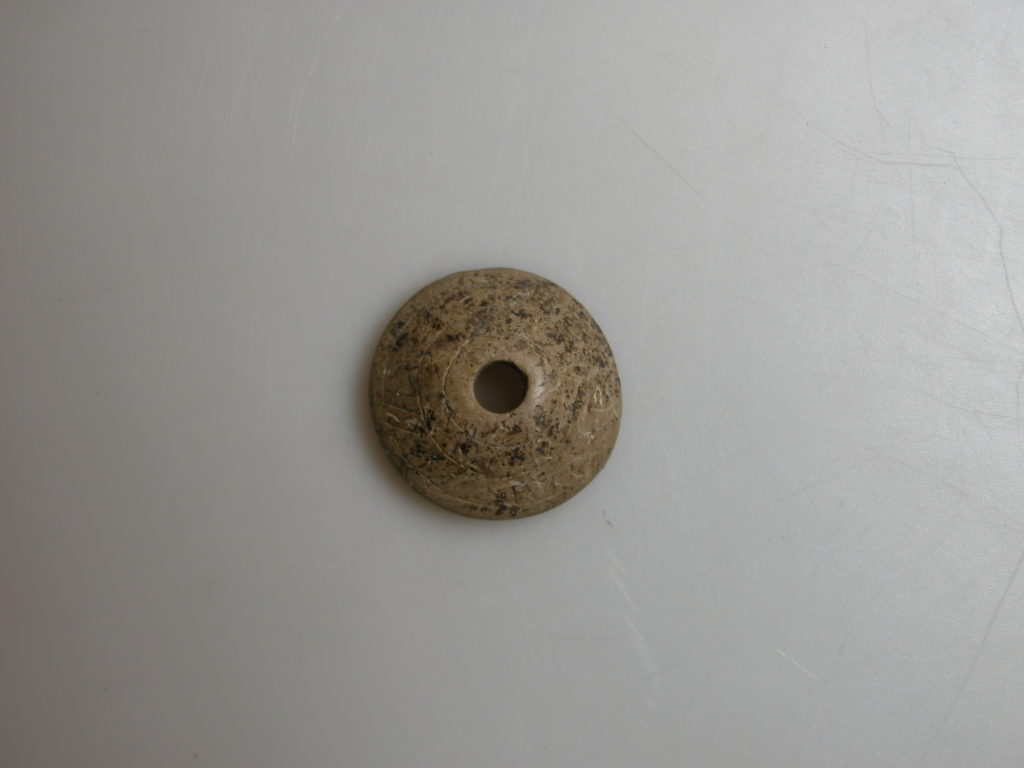

Spindle Whorl
8th Century AD
Bone
Bone spindle whorl with incised decoration. Spindle whorls were used when spinning wool into yarn. Attached to the spindle, they helped maintain the speed of the spin used to twist the raw wool into a long thread. Using a spindle whorl helped maintain the same thickness of the wool as it was spun.
Reference: CANCM:nn
Can be found: The Anglo-Saxon Kingdom of KentTop Shelf in Explorers and Collectors Collection


Spindle Whorl
8th Century AD
Bone
Two bone Spindle whorl.
Reference: CANCM:nn
Can be found: The Anglo-Saxon Kingdom of KentTop Shelf in Explorers and Collectors Collection


Spindle Whorl
5th – 8th Century AD
Glass
Spindle whorl of very dark blue or green glass with inlaid white glass decoration. Anglo-Saxon Eastry appears to have been a place of some size and much importance. The Kings of Kent had a palace, and often held court there.
Found at Eastry, Kent by Mr. Irby. Presented to the museum by Dr.W.G. Urry.
Reference: CANCM:7503
Can be found: Bottom ShelfThe Anglo-Saxon Kingdom of Kent in Explorers and Collectors Collection


Spindle Whorls
8th Century AD
Ceramic
Two Ceramic spindle whorls.
Reference: CANCM:nn
Can be found: The Anglo-Saxon Kingdom of KentTop Shelf in Explorers and Collectors Collection


Spouted black vessel
May be a child’s feeding pot.
Reference: 4093
Can be found: Viscount Strangford in Explorers and Collectors Collection

















































































































Square Headed Brooch
Mid 6th Century AD
Copper Alloy
Square headed brooch decorated with the ring-and-dot motifs popular in the early Saxon period. This type of brooch is one of the most common worn by the Anglo-Saxons, and was used to secure clothing.
Reference: Excavated in 1978 from the Marlowe Car Park. Presented by Canterbury Archaeological Trust CANCM:1978.3.1124
Can be found: The Anglo-Saxon Kingdom of KentTop Shelf in Explorers and Collectors Collection

















































































































Square Headed Brooch
5th – 8th Century AD
Copper Alloy
Square-headed brooch fragment with gilding
Found in Chartham, Kent, by Mr. N. Austin.
Reference: CANCM:1996.6
Can be found: The Anglo-Saxon Kingdom of KentTop Shelf in Explorers and Collectors Collection

















































































































Square Headed Brooch
5th – 8th Century AD
Silver Gilt
Small square headed brooch, silver gilt.
Found in Bekesbourne, Kent, UK. by Mr. P.G. Wilson.
Reference: CANCM:7526
Can be found: Middle ShelfThe Anglo-Saxon Kingdom of Kent in Explorers and Collectors Collection
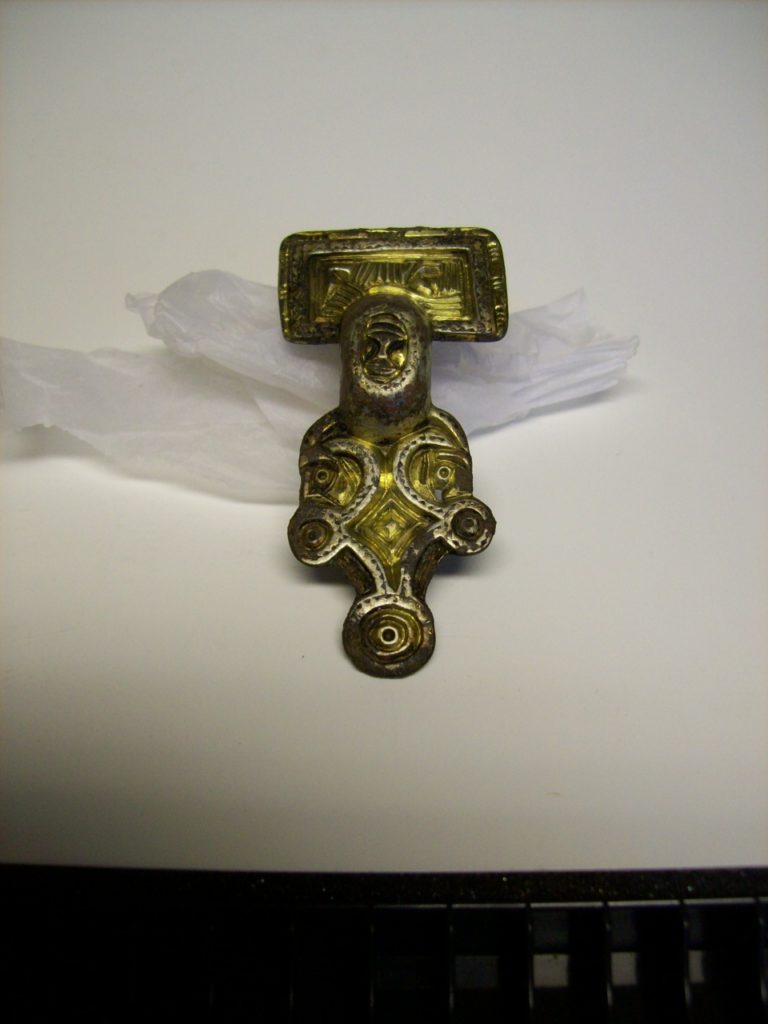

Square Headed Brooch
5th – 8th Century AD
Silver Gilt
Small square headed brooch, silver gilt.
Found in Bekesbourne, Kent, UK. by Mr. P.G. Wilson.
Reference: CANCM:7525
Can be found: Middle ShelfThe Anglo-Saxon Kingdom of Kent in Explorers and Collectors Collection

















































































































Square-Headed Brooch
6th Century AD
Silver Gilt
Silver-gilt square-headed brooch of a cruciform shape, jeweled and set with 9 garnets.
Found at Stowting, Kent by Mr. J. Brent.
Reference: CANCM:2677
Can be found: Middle ShelfThe Anglo-Saxon Kingdom of Kent in Explorers and Collectors Collection

















































































































Square-Headed Brooch
Silver
Square-headed silver-gilt brooch.
Found at Eastry, Kent in 1792. Presented to the museum by Dr. W.G. Urry after a loan from Mr Irby
Reference: CANCM:7495
Can be found: Bottom ShelfThe Anglo-Saxon Kingdom of Kent in Explorers and Collectors Collection

















































































































Square-Headed Brooch
5th – 8th Century AD
Silver Gilt
Square-headed silver-gilt brooch with an undivided foot and a motif decorating footplate which shows rampant animals either side of the foot reaching up to the bow.
Found at Eastry, Kent in 1792. Presented to the museum by Dr. W.G. Urry after a loan from Mr Irby
Reference: CANCM:7494
Can be found: Bottom ShelfThe Anglo-Saxon Kingdom of Kent in Explorers and Collectors Collection

















































































































Squat Jar
5th – 8th Century AD
Glass
Glass Vessel.
Bequeathed by Mr. J. Brent.
Reference: CANCM:2150
Can be found: Middle ShelfThe Anglo-Saxon Kingdom of Kent in Explorers and Collectors Collection

















































































































Squat Jar
5th – 8th Century AD Glass
Glass vessel.
Found in Faversham, Kent, UK. by Mr. J. Brent.
Reference: CANCM:2151
Can be found: Middle ShelfThe Anglo-Saxon Kingdom of Kent in Explorers and Collectors Collection


Staff head with Ibis and Snake
This head of a military standard was found during digging of docks for Nelson’s fleet at the Battle of the Nile in 1798. Standards identified particular branches of the Egyptian army and were readily visible to help rally troops.
Reference: CANCM:nn
Can be found: Ancient EgyptMiddle Shelf in Explorers and Collectors Collection


Statuette
Statuette head, depicting Osiris.
A small painted bronze head of Osiris wearing the white crown of Upper Egypt. This conical shaped headpiece was worn as early as 3000BC. The White Crown may actually have been green because it is believed to be have been made from reeds.
Reference: CANCM:5892
Can be found: Ancient EgyptMiddle Shelf in Explorers and Collectors Collection


Statuette
Bronze cobra’s head statuette, Uraeus Cobra.
Reference: E393
Can be found: Ancient EgyptMiddle Shelf in Explorers and Collectors Collection


Statuette of Hindu elephant god, Ganesh
19th century; collected in Jaipur, India, 1889
Carved and painted stone
Ganesh is the lord of success and destroyer of vanity, selfishness and pride. The god’s pot belly signifies the bounty of nature.
Presented by Mary Landsdell in memory of her late husband, 1922
Reference: 2006.56.42
Can be found: Henry Lansdell in Explorers and Collectors Collection


Statuette of Hindu god
19th century; collected in Jaipur, India, 1889
Carved and painted stone
The Hindu idol of a woman was acquired by Lansdell at the same time as that of Ganesh.
Presented by Mary Landsdell in memory of her late husband, 1922
Reference: 2006.56.43
Can be found: Henry Lansdell in Explorers and Collectors Collection


Stephen Rumbold Lushington, MP 1835
M O’Connor (active as an artist 1830s)
Lithograph
Twenty years before this original of this engraved portrait was painted, the writer Jane Austen described meeting Lushington at Godmersham, near Canterbury, while visiting her niece, Fanny Knight: “I like him very much,” she wrote to her sister, Cassandra (October 1813). “I am sure he is clever, and a man of taste. He got a volume of Milton last night, and spoke of it with warmth. He is quite an MP, very smiling, with an exceeding good address and readiness of language. I am rather in love with him. I dare say he is ambitious and insincere. ... He has a wide smiling mouth, and very good teeth.”
Fanny Knight noted in her pocket book: “Mr Lushington sang. He has a lovely voice, and is quite delightful.”
Reference: 2002.237
Can be found: Stephen Lushington in Explorers and Collectors Collection


Stirrup
11th Century AD
Iron and copper
Decorated stirrup. The foot tread has been repaired. Metal stirrups changed warfare because they allowed horsemen to fight standing up, with greater control of their weapons.
The 11th century was a period of Viking raids on Kent. Canterbury was besieged and ransacked by a Danish army in 1011-12. This is probably when the stirrup was introduced into England for the first time. Horses and equipment were expensive, so few people owned them. The repair to the foot tread shows that the stirrup was highly valued.
Found in East Kent in the 19th century.
Reference: CANCM 1091
Can be found: The English and the Vikings in Explorers and Collectors Collection


Stirrup Strap Mount
9th-11th Century AD
Copper Alloy
Stirrup strap mount depicting standing figure surrounded by snakes.
Mounts like these were used to join the stirrup to its leather strap. The strap was passed through the loop at the top of the stirrup, and was then held in place by one of these mounts fixed to it with rivets. The serpent decoration is characteristic of Viking art.
Found by S. Hall and G.T. Hall while metal detecting at Barham Court Farms, Barham.
Reference: CANCM:2003.489.1
Can be found: The English and the Vikings in Explorers and Collectors Collection


Stirrup Strap Mount
9th- 11th Century AD
Copper Alloy
Stirrup strap mount depicting two rampant beasts. Decoration featuring animals is characteristic of Viking art.
Found by S. Hall and G.T. Hall while metal detecting at Barham Court Farms, Barham.
Reference: CANCM:2003.489.2
Can be found: The English and the Vikings in Explorers and Collectors Collection

















































































































Stirrup Strap Mount
9th -11th Century AD
Copper Alloy
Stirrup strap mount depicting a bird.
Found by S. Hall and G.T. Hall while metal detecting at Barham Court Farms, Barham.
Reference: CANCM:2003.489.3
Can be found: The English and the Vikings in Explorers and Collectors Collection


Stone Amulet
Small object in red stone/fruit amulet in carnelian or haematite.
Reference: CANCM: 2119
Can be found: Ancient EgyptMiddle Shelf in Explorers and Collectors Collection

















































































































Stone Scarab
Reference: CANCM: 539
Can be found: Ancient EgyptBottom Shelf in Explorers and Collectors Collection


Strap End
5th-8th Century AD
Copper Alloy
A strap end would have been affixed to the end of a belt or strap of a harness as decoration. They would protect the leather end of the strap and make it easier to thread, but despite this very functional purpose they were still considered jewellery in their own right.
Found in Martyr’s Field, Canterbury, in around 1900.
Reference: CANCM:7162
Can be found: Middle ShelfThe Anglo-Saxon Kingdom of Kent in Explorers and Collectors Collection


Strap End
9th Century AD
Copper Alloy
Strap end. A strap end would have been attached to the end of a belt or strap of a harness as decoration. They would protect the leather end of the strap and make it easier to thread, but despite this very functional purpose they were still considered jewellery in their own right.
Excavated in 1993 from Canterbury Christ Church College. Presented by Canterbury Archaeological Trust.
Reference: CANCM:1993.5.45
Can be found: The English and the Vikings in Explorers and Collectors Collection
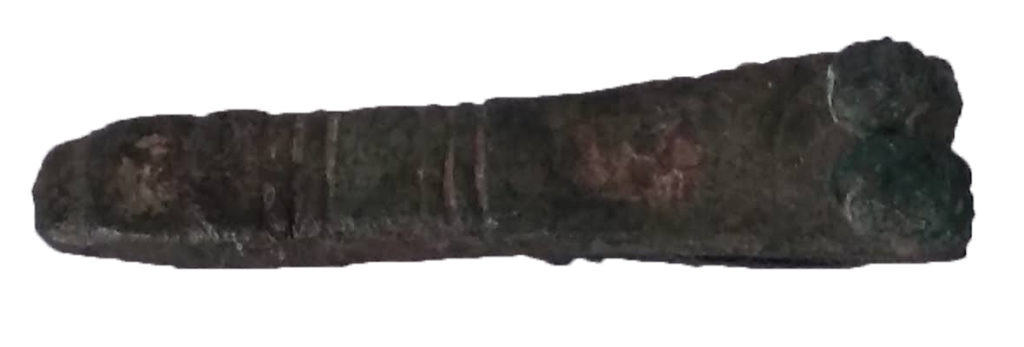

Strap End
11th Century AD
Copper Alloy
Strap end.
Presented by Canterbury Archaeological Trust.
Reference: CANCM:1983.10.859
Can be found: The English and the Vikings in Explorers and Collectors Collection


Strap End
9th-11th Century AD
Copper Alloy
Strap end.
Presented by Canterbury Archaeological Trust.
Reference: CANCM:1990.11.2229
Can be found: The English and the Vikings in Explorers and Collectors Collection


Sturgeon, antidote to disease 19th century; collected in Tyr, Russian Far East Wood
“The Gilyaks believe in wooden idols or charms as antidotes to disease,” wrote Lansdell. Plague had been raging across Russia in 1879.
The Gilyaks lived near the border with China. At Tyr, on the rivers Amur and Amaun, Lansdell “wished to buy some of the little amulets belonging to the head of the household” of a Gilyak family, including “those of his baby, one of them a doll in a sitting posture”. But the man was unwilling to sell until offered “a silver piece”. Then he “sent after me a fish rudely cut in wood, and meant for a sturgeon [the fish famous for its roe, known as caviar], with a little god seated on his back. This had been used, apparently, not long before, on a fishing expedition.”
Lansdell had his photograph taken wearing Gilyak clothing and holding the sturgeon god.
Presented by Mary Landsdell in memory of her late husband, 1922
Reference: 2006.56.12
Can be found: Henry Lansdell in Explorers and Collectors Collection

















































































































Sword Ring
5th – 8th Century AD
Silver Gilt
Silver-gilt sword ring inlaid with niello.
Reference: CANCM:2003.390
Can be found: The Anglo-Saxon Kingdom of KentTop Shelf in Explorers and Collectors Collection


Taiaha stick
Early to mid-19th century; New Zealand
Wood
A Maori weapon for fighting, decorated with a head, eyes and a tongue.
Reference: 4602
Can be found: Heroes and VillainsTravellers to the Pacific, Australasia and America in Explorers and Collectors Collection


Tea saucers
19th century; bought at Maimatchin,
Mongolian frontier Metal
“We bought some embroidered purses of native workmanship, and cups and saucers. The saucers are of a lozenge-shape, and of metal, with an indentation fitted to receive the bottom of the cup, which has no handle. Hence, in drinking the tea, it was not necessary to finger the cup, but merely to hold the saucer and drink from the cup resting therein.” (Henry Lansdell, Through Siberia, 1882)
Maimatchin was a male-only Russo-Chinese trading town on the Mongolian.
Presented by Mary Landsdell in memory of her late husband, 1922
Reference: 2006.56.11.1-2
Can be found: Henry Lansdell in Explorers and Collectors Collection

















































































































Tenor Side Drum
1795c, Unknown maker
Wood, calf skin
Drummers of the Buffs would have carried drums like this one into battle during the Napoleonic Wars. These drums were particularly deep to produce a loud sound as drum signals were used to relay commands across noisy battlefields.
The badge of the Buffs had been a dragon since at least 1707 so it is odd that the drum should have a white horse badge on it. Drums were also used to attract a crowd during recruiting and as East Kent had been given to the regiment as its recruiting area in 1782 it may have been intended to increase the number of local men eager to join up.
Donated to the National Army Museum, London, by the Trustees of the Buffs Regimental Trust, 2001
Reference: 2001.04-307
Can be found: The Buffs in Explorers and Collectors Collection


Terracotta reclining male figure 3rd to 1st century BC; found at Athens in 1821.
Earthenware
There are traces of red paint on the terracotta.
Presented by Viscount Strangford to Canterbury Philosophical and Literary Institution Museum, 1844, and acquired through purchase of the museum by Canterbury Corporation, 1846-47
Reference: 4175
Can be found: Viscount Strangford in Explorers and Collectors Collection

















































































































Terracotta sculptures and stone fragments
3rd to 1st century BC; found in Greece and Turkey
Earthenware and stone
Figures sculpted in baked clay – terracotta – were very popular. Some may have been used for funerary or religious ritual, others for decoration or amusement. The seated figure of Dionysus (Bacchus) is a wine pitcher, his headdress the spout. Other terracottas include a wolf’s head, a pomegranate, and a pig and bird, probably toys. The round terracotta tablet, of unknown purpose, is inscribed ‘Augustus and Caesar’, with the maker’s initials ‘SR’.
The partial foot of a marble sculpture, with sandal thongs imitating creepers, was found at Athens, the hand with scroll at Adrianople (modern Edirne), Turkey.
Presented by Viscount Strangford to Canterbury Philosophical and Literary Institution Museum, 1844, and acquired through purchase of the museum by Canterbury Corporation, 1846-47
Presented by Viscount Strangford to Canterbury Philosophical and Literary Institution Museum, 1844, and acquired through purchase of the museum by Canterbury Corporation, 1846-47
Reference: CANCM:nn
Can be found: Viscount Strangford in Explorers and Collectors Collection

















































































































The Bishop Liudhard Medalet
c. 590 AD
Gold
A electroform copy of the Bishop Liudhard Medalet, now in the World Museum Liverpool. The Medalet honours Queen Bertha’s chaplain and was probably created prior to St Augustine’s arrival in 597 AD.
Original excavated from St Martin’s Churchyard in 1844.
Reference: CANCM:10353
Can be found: Bottom ShelfThe Anglo-Saxon Kingdom of Kent in Explorers and Collectors Collection

















































































































The Canterbury Pendant
Early 7th Century AD
Gold, Garnets, Glass
A fine example of an Anglo Saxon pendant made from a gold disc inlaid with garnets and glass. The empty central spaces would have been filled with white paste to form a cross.
Presented by Canterbury Archaeological Trust
Reference: CANCM:1982.14.23
Can be found: The Anglo-Saxon Kingdom of KentTop Shelf in Explorers and Collectors Collection

















































































































The Dragon Pendant
9th Century AD
Gold, Garnets
An animal-head pendant. It is made from a sheet of gold decorated with gold filigree and granules. One of the eye sockets is now empty, but the other has a deeply sunken garnet set in it. The decoration and style are similar to other pendants that date from the Ninth century, but the suspension loop at the back of the head is unique among Anglo Saxon finds.
Purchased with grant-aid from Arts Council England/Victoria and Albert Museum Purchase Grant Fund and the Headley Trust
Found by Mr Peter Thomas when metal detecting at Monkton, Kent in 2013.
Reference: CANCM:2016.14
Can be found: Bottom ShelfThe Anglo-Saxon Kingdom of Kent in Explorers and Collectors Collection

















































































































Three Stone Objects
5th – 8th Century AD
Stone
Circular stone objects, probably used in a game.
Bequeathed by Mr. J. Brent.
Reference: CANCM:2278-80
Can be found: Middle ShelfThe Anglo-Saxon Kingdom of Kent in Explorers and Collectors Collection
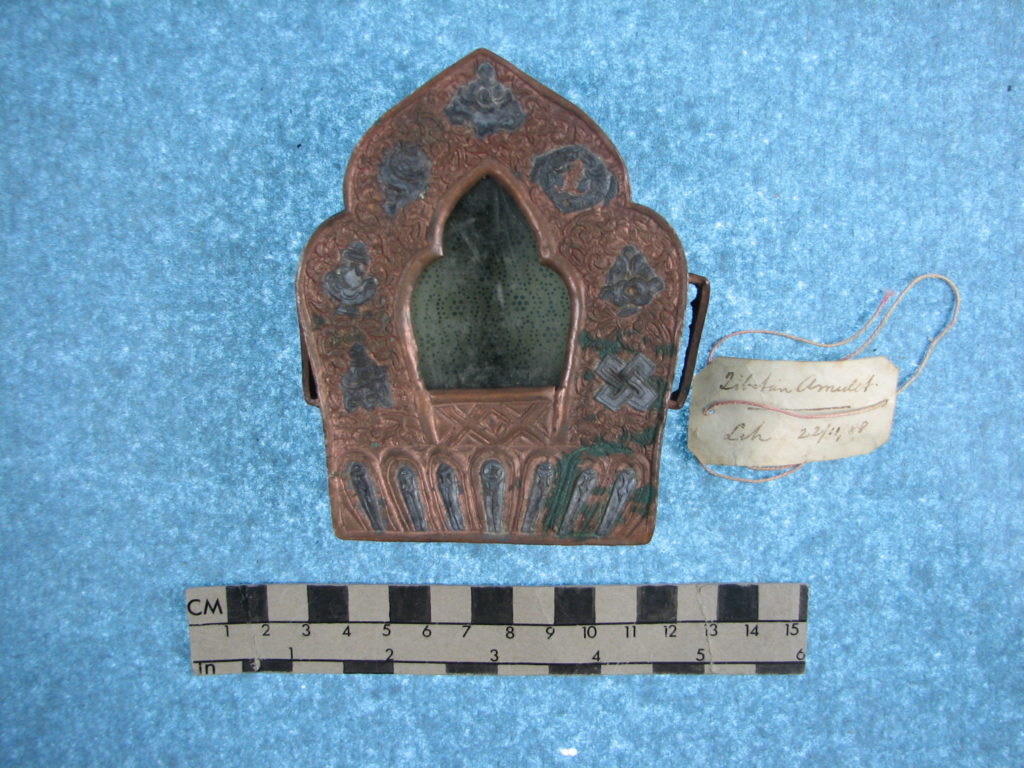

Tibetan amulet
19th century; bought in China, 1888
Metal
Lansdell travelled with a letter of introduction from the Archbishop of Canterbury, hoping to gain entry to the closed city of Lhasa, Tibet.
He was unable to cross from India to Tibet. Travelling to China he was again prevented from crossing: the British ambassador feared upsetting the Chinese. Lansdell had to be content with buying Tibetan items from a merchant, “Baltistan Leh”, who had visited Tibet.
Presented by Mary Landsdell in memory of her late husband, 1922
Reference: 2006.56.35.1-2a
Can be found: Henry Lansdell in Explorers and Collectors Collection


Tibetan cup
19th century; bought in China, 1888
Metal
Lansdell travelled with a letter of introduction from the Archbishop of Canterbury, hoping to gain entry to the closed city of Lhasa, Tibet.
He was unable to cross from India to Tibet. Travelling to China he was again prevented from crossing: the British ambassador feared upsetting the Chinese. Lansdell had to be content with buying Tibetan items from a merchant, “Baltistan Leh”, who had visited Tibet.
Presented by Mary Landsdell in memory of her late husband, 1922
Reference: 2006.56.33a
Can be found: Henry Lansdell in Explorers and Collectors Collection


Tibetan girdle plate
19th century; bought in China, 1888
Metal
Lansdell travelled with a letter of introduction from the Archbishop of Canterbury, hoping to gain entry to the closed city of Lhasa, Tibet.
He was unable to cross from India to Tibet. Travelling to China he was again prevented from crossing: the British ambassador feared upsetting the Chinese. Lansdell had to be content with buying Tibetan items from a merchant, “Baltistan Leh”, who had visited Tibet.
Presented by Mary Landsdell in memory of her late husband, 1922
Reference: 2006.56.34
Can be found: Henry Lansdell in Explorers and Collectors Collection


Tibetan pipe
19th century; bought in China, 1888
Wood
Lansdell travelled with a letter of introduction from the Archbishop of Canterbury, hoping to gain entry to the closed city of Lhasa, Tibet.
He was unable to cross from India to Tibet. Travelling to China he was again prevented from crossing: the British ambassador feared upsetting the Chinese. Lansdell had to be content with buying Tibetan items from a merchant, “Baltistan Leh”, who had visited Tibet.
Presented by Mary Landsdell in memory of her late husband, 1922
Reference: 2006.56.36
Can be found: Henry Lansdell in Explorers and Collectors Collection


Tibetan whip
19th century; bought in China, 1888
Wood, leather
Lansdell travelled with a letter of introduction from the Archbishop of Canterbury, hoping to gain entry to the closed city of Lhasa, Tibet.
He was unable to cross from India to Tibet. Travelling to China he was again prevented from crossing: the British ambassador feared upsetting the Chinese. Lansdell had to be content with buying Tibetan items from a merchant, “Baltistan Leh”, who had visited Tibet.
Presented by Mary Landsdell in memory of her late husband, 1922
Reference: 2006.56.32
Can be found: Henry Lansdell in Explorers and Collectors Collection


Tongan headrest or pillow
Late 18th century; Tonga, South Sea Islands
Probably whalebone
Headrests were valued, high status items. This example has inlaid decoration including a flying bird. It is probably one of the objects collected during Captain Cook’s voyages and distributed among museums in Britain.
Reference: 4507
Can be found: Heroes and VillainsTravellers to the Pacific, Australasia and America in Explorers and Collectors Collection

















































































































Towelling Cloth
Small specimen of bath towelling cloth/mummy cloth
Hundreds of metres of linen were used to wrap a mummy. It didn’t just come in bandage-like strips, but shrouds, large sheets that covered the body like a cape. Bandages were wrapped very tight to maintain the mummies distinctive shape, and brushed with a sticky resin to stick them together.
Reference: CANCM: 5159
Can be found: Ancient EgyptBottom Shelf in Explorers and Collectors Collection


Tweezers
7th-8th Centuries AD
Copper Alloy
Tweezers are often found in Anglo-Saxon graves. They may have been worn on a necklace or attached to a belt, but either way their inclusion in a grave shows how dedicated the Anglo-Saxons were to personal hygiene.
Reference: CANCM:1980.11.1410
Can be found: The Anglo-Saxon Kingdom of KentTop Shelf in Explorers and Collectors Collection


Two Glass Beakers
5th – 8th Century AD
Glass
Two glass beakers of yellow-green glass.
Donated by Mr. John Hewett.
Reference: Cancm:9934.2 + 3
Can be found: Bottom ShelfThe Anglo-Saxon Kingdom of Kent in Explorers and Collectors Collection


Two Glass Beakers
5th – 8th Century AD
Glass
Two glass beakers.
Found in Faversham, Kent, UK.
Reference: CANCM:nn
Can be found: Bottom ShelfThe Anglo-Saxon Kingdom of Kent in Explorers and Collectors Collection


Two-handled vase
Reference: 4089
Can be found: Viscount Strangford in Explorers and Collectors Collection


Unknown date; found at Brusa (now Bursa)
Turkey Stone
This square marble relief shows one of the labours of Hercules, who was tasked with stealing apples from the Garden of the Hesperides, guarded by a serpent. Hercules tricked Atlas into doing the task. The latter’s cloak is shown flowing behind to suggest speed.
Presented by Viscount Strangford to Canterbury Philosophical and Literary Institution Museum, 1844, and acquired through purchase of the museum by Canterbury Corporation, 1846-47
Reference: 4267
Can be found: Viscount Strangford in Explorers and Collectors Collection


Urn with two female heads facing one another
Reference: 4165
Can be found: Viscount Strangford in Explorers and Collectors Collection


Vase
Reference: 4238
Can be found: Viscount Strangford in Explorers and Collectors Collection


Vase
With four figures, the two central ones fighting
Reference: 4119
Can be found: Viscount Strangford in Explorers and Collectors Collection


Vase
Reference: 4111
Can be found: Viscount Strangford in Explorers and Collectors Collection


Vase with diamond pattern
Reference: 4230
Can be found: Viscount Strangford in Explorers and Collectors Collection


Vase with honeysuckle design
Reference: 4115
Can be found: Viscount Strangford in Explorers and Collectors Collection


Vase with honeysuckle design
Reference: 4224
Can be found: Viscount Strangford in Explorers and Collectors Collection


Vase with honeysuckle design
Reference: 4117
Can be found: Viscount Strangford in Explorers and Collectors Collection


Vase with honeysuckle design From Megara
Reference: 4110
Can be found: Viscount Strangford in Explorers and Collectors Collection


Vase with longitudinal furrows
Reference: 4232
Can be found: Viscount Strangford in Explorers and Collectors Collection


Vase with winged horse lying down
Reference: 4229
Can be found: Viscount Strangford in Explorers and Collectors Collection


Veil cords
19th century; collected in Khotan, China, 1888
Silk
Tagged, like most of Lansdell’s collection, with labels describing where and when acquired.
Presented by Mary Landsdell in memory of her late husband, 1922, and conserved with grant-aid from the Kathy Callow Trust, 2012
Reference: 2006.56.31.1-3
Can be found: Henry Lansdell in Explorers and Collectors Collection


Vessel
Egyptian ceramic vessel
Stone lidded pots for storing kohl or galena eye-paint. Several found in an early New Kingdom shaft tomb of about 1550–1450 BC (Y66) near Abydos by William Matthew Flinders Petrie (1853–1942).
Reference: CANCM:6147
Can be found: Ancient EgyptMiddle Shelf in Explorers and Collectors Collection
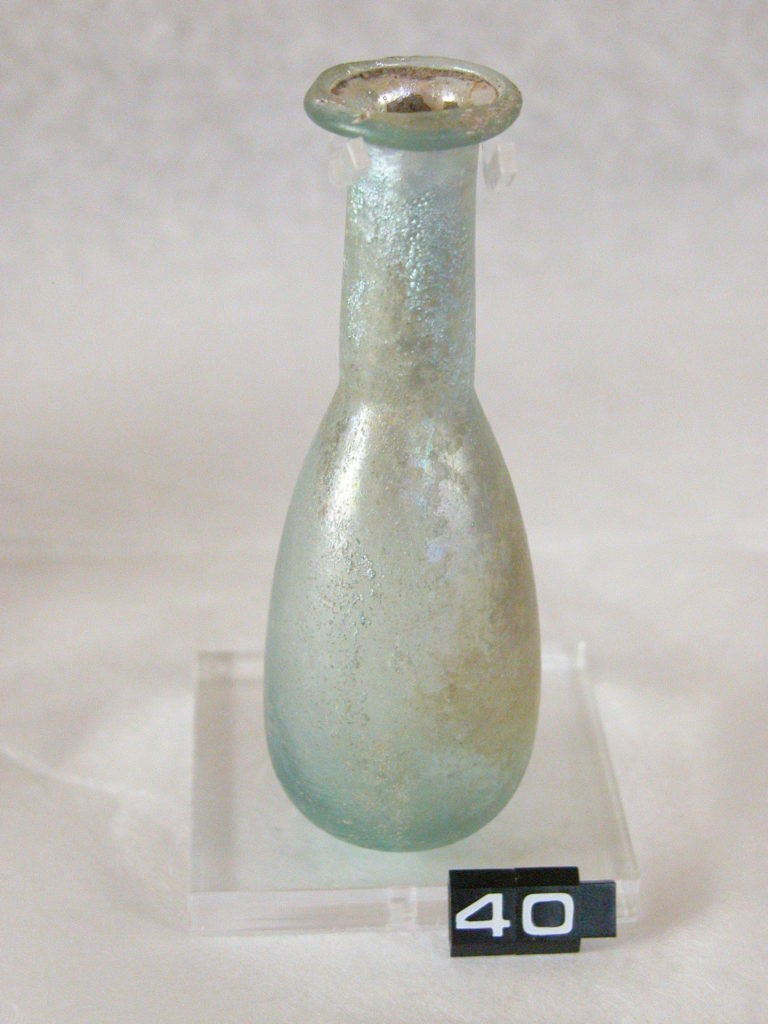

Vessel
Glass vessel.
Reference: E308
Can be found: Ancient EgyptMiddle Shelf in Explorers and Collectors Collection


Wolf’s head
Terracotta
Reference: 4223
Can be found: Viscount Strangford in Explorers and Collectors Collection


Zoomorphic Brooch
Late 6th Century AD
Copper Alloy
Cast in bronze to resemble a bird. This shape has been found both in Kent and in Northern France, and it is one of the ways we know about the close links of the Anglo Saxons across the Channel.
Excavated from a site in Castle Street in 1978. Presented by Canterbury Archaeological Trust
Reference: CANCM:1978.1.210
Can be found: The Anglo-Saxon Kingdom of KentTop Shelf in Explorers and Collectors Collection
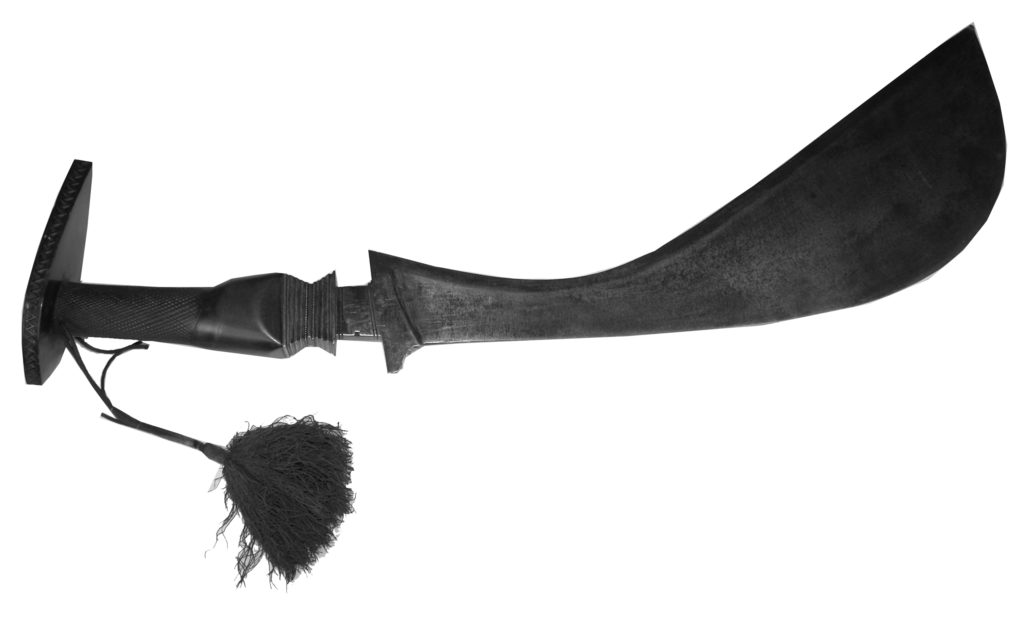

‘Adya Katti’ knife
18th century; Coorg, South India
Steel and horn
This type of knife with heavy single-edged blade and no guard was used in Coorg, on the Western Ghat mountains, and Malabar, between the Western Ghats and Arabian Sea.
Presented by Stephen Lushington to Canterbury Philosophical and Literary Institution Museum, 1825-68, and acquired through purchase of the Museum by Canterbury Corporation, 1846-47
Reference: CANCM:nn
Can be found: Stephen Lushington in Explorers and Collectors Collection

















































































































‘Dastana’ arm guard with pistols
Early 19th century; Madras, South India
Steel
An arm guard fitted with English-style box-lock flintlock pistols and a triangular-shaped ‘flick’ bayonet. This gauntlet would probably have been a back-up weapon to a sword, or pata gauntlet sword, in the warrior’s other hand. However, whether it was a combat weapon is uncertain. Pistols were occasionally combined with swords in Indian arms. But this unusual piece is more likely a novelty weapon made for European visitors.
The arm guard is displayed to show the hinged underside, which fitted snugly round the forearm.
Presented by Stephen Lushington to Canterbury Philosophical and Literary Institution Museum, 1825-68, and acquired through purchase of the Museum by Canterbury Corporation, 1846-47
Reference: WG 74
Can be found: Henry Lansdell in Explorers and Collectors Collection


‘Dhal’ shield
19th century; South India
Brass
This shield was made for the European souvenir market. It is styled on the fighting shield, known as a dhal, but with rich inlaid decoration of foliage patterns.
Presented by Stephen Lushington to Canterbury Philosophical and Literary Institution Museum, 1825-68, and acquired through purchase of the Museum by Canterbury Corporation, 1846-47
Reference: WG 504
Can be found: Stephen Lushington in Explorers and Collectors Collection


‘Dhal’ shield from rhino hide
18th century; probably Rajasthan, South India
Rhino hide, metal and wood
Rajasthan was the centre for manufacture and decoration of the traditional Indian round dhal fighting shields, with shallow domed shape and four metal bosses (round knobs) on the front corresponding to handle fixings inside. Dhal varied in size and could be made of metal or animal hide.
Rhino hide was popular because it is translucent: a shield similar to the one here is displayed in the Materials and Masters gallery to show how light passes through the hide.
Presented by Stephen Lushington to Canterbury Philosophical and Literary Institution Museum, 1825-68, and acquired through purchase of the Museum by Canterbury Corporation, 1846-47
Reference: CANCM:nn
Can be found: Stephen Lushington in Explorers and Collectors Collection


‘Firangi’ sword
18th century; South India
Steel
Indian long sword of the type known as a Firangi (from ‘Frank’, meaning ‘foreigner’) because such swords originally incorporated European or other foreign blades, or ones made locally in European style.
It has a basket-type hilt (sword-handle) with a hand-guard above the crossbar. The grip (hand-hold) ends in a pommel of round discs. A spike extends from the pommel, enabling the sword to be used two-handed, but also providing a second, close-combat weapon. Hilts like this with a spike are known as Khanda style. It is decorated with gold inlay and turquoises; there are also inscriptions in Persian and Hindi. From the 16th century onwards Mughal rule in India meant that Persian culture and crafts were adopted.
Presented by Stephen Lushington to Canterbury Philosophical and Literary Institution Museum, 1825-68, and acquired through purchase of the Museum by Canterbury Corporation, 1846-47
Reference: 1464
Can be found: Stephen Lushington in Explorers and Collectors Collection


‘Firangi’ sword
18th to 19th century; South India
Steel
Firangi means ‘foreigner’ and this type of sword originally incorporated European blades, or ones made locally in European style.
Presented by Stephen Lushington to Canterbury Philosophical and Literary Institution Museum, 1825-68, and acquired through purchase of the Museum by Canterbury Corporation, 1846-47
Reference: CANCM:nn
Can be found: Stephen Lushington in Explorers and Collectors Collection


‘Jibbah’ tunics
1881-98; Mahdi people, Sudan
Cotton and wool
These Jibbah or Jibbeh tunics belonged to officers in the Islamic Mahdi army. They are made from strips of hand-spun and woven cotton with appliqué of coloured woollen patches. The frugality of these garments and their clear re-use of textiles accord with the Islamic principles of humility and poverty adopted by the Mahdists. The patterned design of these tunics helped make Mahdi officers visible to their troops in battle.
Collected by Captain J Graham, 1898, and presented by General Sir James Graham, KCB, 1902
Reference: 4752, 4753
Can be found: Africa, Asia, America, PacificHeroes and Villains in Explorers and Collectors Collection


‘Katar’ dagger
18th century; South India
Steel
A Hindu punch or thrust dagger for close combat, with characteristic ‘H’-shaped hand-grip and double-edged ‘knuckleduster’ blade. These were often made from broken sword blades.
Presented by Stephen Lushington to Canterbury Philosophical and Literary Institution Museum, 1825-68, and acquired through purchase of the Museum by Canterbury Corporation, 1846-47
Reference: 1490
Can be found: Stephen Lushington in Explorers and Collectors Collection


‘Kris’ knives
18th to 19th century; Malaysia
Metal and wood
The Kris is a traditional Malay knife. One or several of these may the Kris knives given to the museum after their seizure from the forces of Tipu Sultan, ruler of Mysore, at Seringapatam, South India, in 1799.
Reference: 1465, 1466
Can be found: Heroes and VillainsTravellers to the East in Explorers and Collectors Collection


‘Kukri’ knives
18th to 19th century; Nepal, North India
Steel
Short knives used by the Gurkhas of Nepal are called Kukri. They have an inward-curved cutting edge and are used as both weapons and tools, like a machete. One has a dog-head handle, the other a dragon-head.
Presented by Stephen Lushington to Canterbury Philosophical and Literary Institution Museum, 1825-68, and acquired through purchase of the Museum by Canterbury Corporation, 1846-47
Reference: WG 498 and WG 499
Can be found: Stephen Lushington in Explorers and Collectors Collection

















































































































‘Lekythos’ and other vessels
5th to 2nd century BC; found in Greece and Turkey
Earthenware
Ancient Greek pottery is predominantly red and black. The colours were achieved by covering parts of the clay pots with slip (diluted clay solution) and firing at different temperatures. Early decoration was black-on-red, succeeded from about 500 BC by red-on-black. Several pots are made in the tall, slim Lekythos shape particular to Athens.
The decoration includes images of a charioteer driving quadriga (four-horse chariot) and a Nike (winged victory) pouring a libation (liquid offering) at an altar. The small black spouted vessel may be a child’s feeding pot.
Presented by Viscount Strangford to Canterbury Philosophical and Literary Institution Museum, 1844, and acquired through purchase of the museum by Canterbury Corporation, 1846-47
Reference: CANCM:nn
Can be found: Viscount Strangford in Explorers and Collectors Collection


‘Lekythos’ vase
5th century BC; found at Athens in 1811 (mouth found separately in 1821)
Earthenware
The Lekythos is a type of tall vase particular to ancient Athens. It contained oil for funerary offerings.
The image shows a crucial moment in the story of mythological hero Agamemnon. He had returned from years of war in Troy to find his wife, Clytemnestra, was having an affair with his cousin Aigisthus. The adulterous pair murdered Agamemnon and neglected to observe correct funeral rites. Agamemnon’s daughter, Electra, sent her younger brother, Orestes, to safety. Years later he returned, and the two met and recognised one another at their father’s tomb (represented by the column). They planned how to avenge his death.
Presented by Viscount Strangford to Canterbury Philosophical and Literary Institution Museum, 1844, and acquired through purchase of the museum by Canterbury Corporation, 1846-47
Reference: 4105
Can be found: Viscount Strangford in Explorers and Collectors Collection


‘Lekythos’ vase
5th to 2nd century BC; found in Greece or Turkey
Earthenware
The Lekythos is a type of tall vase particular to ancient Athens. It contained oil for funerary offerings. The colours were achieved by covering parts of the clay pots with slip (diluted clay solution). Iron oxide naturally present in the clay turned from red to black, or back to red, depending on firing conditions. Further pigments could be added to the slip. This example has leaf patterns.
Presented by Viscount Strangford to Canterbury Philosophical and Literary Institution Museum, 1844, and acquired through purchase of the museum by Canterbury Corporation, 1846-47
Reference: 4106
Can be found: Viscount Strangford in Explorers and Collectors Collection


‘Lekythos’ vase
5th to 2nd century BC; found in Greece or Turkey
Earthenware
The Lekythos is a type of tall vase particular to ancient Athens. It contained oil for funerary offerings. The colours were achieved by covering parts of the clay pots with slip (diluted clay solution). Iron oxide naturally present in the clay turned from red to black, or back to red, depending on firing conditions. Further pigments could be added to the slip.
Black-on-red decoration was favoured initially, like this example with charioteer driving a quadriga (four-horse chariot).
Presented by Viscount Strangford to Canterbury Philosophical and Literary Institution Museum, 1844, and acquired through purchase of the museum by Canterbury Corporation, 1846-47
Reference: 4151
Can be found: Viscount Strangford in Explorers and Collectors Collection


‘Lekythos’ vase
5th to 2nd century BC; found in Greece or Turkey
Earthenware
The Lekythos is a type of tall vase particular to ancient Athens. It contained oil for funerary offerings. The colours were achieved by covering parts of the clay pots with slip (diluted clay solution). Iron oxide naturally present in the clay turned from red to black, or back to red, depending on firing conditions. Further pigments could be added to the slip.
Black-on-red decoration was favoured initially. From about 500 BC red-on-black predominated like this example depicting a woman holding a mirror.
Presented by Viscount Strangford to Canterbury Philosophical and Literary Institution Museum, 1844, and acquired through purchase of the museum by Canterbury Corporation, 1846-47
Reference: 4149
Can be found: Viscount Strangford in Explorers and Collectors Collection


‘Pata’ gauntlet sword
17th century; Tanjore or Mysore, South India
Steel and brass
The Pata, or gauntlet sword, was used by Maratha warriors during their long but eventually successful war against the Persian Mughal empire (1681-1707). Maratha warriors were trained to fight with two patas, one in each hand, or with a single pata in one hand and an axe or spear in the other. The snug-fitting steel gauntlet covers the fighter’s hand, wrist and part of their forearm. Inside the gauntlet is a metal crossbar, gripped by the fist. The sword becomes effectively an extension of the arm, for slash and thrust with a double-edged blade.
The steel arm-guard here is formed in the shape of an elephant being devoured by a Makara (demon). This ornate weapon may have been a royal sword.
Presented by Stephen Lushington to Canterbury Philosophical and Literary Institution Museum, 1825-68, and acquired through purchase of the Museum by Canterbury Corporation, 1846-47
Reference: WG 80
Can be found: Stephen Lushington in Explorers and Collectors Collection


‘Pesh-Kabz’ knife
18th to 19th century; South India
Steel
A dagger with a re-curving blade of very finely forged steel, designed to penetrate chain mail and other armour. This type was introduced to India by the Persian Mughals and is also called an Afghan or Khyber knife.
Presented by Stephen Lushington to Canterbury Philosophical and Literary Institution Museum, 1825-68, and acquired through purchase of the Museum by Canterbury Corporation, 1846-47
Reference: CANCM:1524
Can be found: Stephen Lushington in Explorers and Collectors Collection


‘Tabar’ battle axe
Early 18th century; Madurai, South India
Steel
This weapon used mainly by horsemen is decorated with bird motifs. Two concealed knives emerge from the hammer head of the axe.
Presented by Stephen Lushington to Canterbury Philosophical and Literary Institution Museum, 1825-68, and acquired through purchase of the Museum by Canterbury Corporation, 1846-47
Reference: 1270
Can be found: Stephen Lushington in Explorers and Collectors Collection


‘Tabar’ battle axe
18th to 19th century; South India
Steel
A weapon used for close combat, with a crescent-shaped blade and pick.
Presented by Stephen Lushington to Canterbury Philosophical and Literary Institution Museum, 1825-68, and acquired through purchase of the Museum by Canterbury Corporation, 1846-47
Reference: 1264
Can be found: Stephen Lushington in Explorers and Collectors Collection


‘Temple’ sword
18th century; Malabar, South India
Steel
Angled swords like this are known as Temple Swords and are associated with the Nair people of Malabar. They were used for religious and domestic ceremonies.
Presented by Stephen Lushington to Canterbury Philosophical and Literary Institution Museum, 1825-68, and acquired through purchase of the Museum by Canterbury Corporation, 1846-47
Reference: CANCM:nn
Can be found: Stephen Lushington in Explorers and Collectors Collection


‘Tulwar’ sabre
18th to 19th century; South India
Steel
Used by cavalry or similar mounted soldiers, with a single-edged blade. Sabres are often called scimitars, from their Persian name Shamshir. The pommel (handle end) is disc-shaped.
Presented by Stephen Lushington to Canterbury Philosophical and Literary Institution Museum, 1825-68, and acquired through purchase of the Museum by Canterbury Corporation, 1846-47
Reference: CANCM:nn
Can be found: Stephen Lushington in Explorers and Collectors Collection



‘Tulwar’ sabre
18th to 19th century; South India
Steel
Used by cavalry or similar mounted soldiers, with a single-edged blade. Sabres are often called scimitars, from their Persian name Shamshir. The pommel (handle end) is disc-shaped. This sabre has a Rajput basket-style hilt (sword-handles with knuckle guard).
The grooves on the blade (sometimes mistakenly called ‘blood grooves’) are known as fullers and help create a lighter blade whilst maintaining its strength.
Presented by Stephen Lushington to Canterbury Philosophical and Literary Institution Museum, 1825-68, and acquired through purchase of the Museum by Canterbury Corporation, 1846-47
Reference: (WG 341)
Can be found: Stephen Lushington in Explorers and Collectors Collection


‘Tulwar’ sabre
18th to 19th century; South India
Steel
Used by cavalry or similar mounted soldiers, with a single-edged blade. Sabres are often called scimitars, from their Persian name Shamshir. The pommel (handle end) is disc-shaped.
The grooves on the blade (sometimes mistakenly called ‘blood grooves’) are known as fullers and help create a lighter blade whilst maintaining its strength.
Presented by Stephen Lushington to Canterbury Philosophical and Literary Institution Museum, 1825-68, and acquired through purchase of the Museum by Canterbury Corporation, 1846-47
Reference: (WG 284)
Can be found: Stephen Lushington in Explorers and Collectors Collection



‘Tulwar’ sabre
18th to 19th century; South India
Steel
Used by cavalry or similar mounted soldiers, with a single-edged blade. Sabres are often called scimitars, from their Persian name Shamshir. The pommel (handle end) is disc-shaped. This sabre has a Rajput basket-style hilt (sword-handles with knuckle guard) and a Khanda style with spike on the pommel.
The grooves on the blade (sometimes mistakenly called ‘blood grooves’) are known as fullers and help create a lighter blade whilst maintaining its strength.
Presented by Stephen Lushington to Canterbury Philosophical and Literary Institution Museum, 1825-68, and acquired through purchase of the Museum by Canterbury Corporation, 1846-47
Reference: CANCM:nn
Can be found: Stephen Lushington in Explorers and Collectors Collection


‘Yatagan’ sword within scabbard
18th century; South India
Steel, wood and silver
Yatagan short sabres are Ottoman Turkish in origin. They have a slightly re-curved blade and no guard on the hilt (handle).
Presented by Stephen Lushington to Canterbury Philosophical and Literary Institution Museum, 1825-68, and acquired through purchase of the Museum by Canterbury Corporation, 1846-47
Reference: 1510
Can be found: Stephen Lushington in Explorers and Collectors Collection

